Glossaire des termes botaniques
La plupart des termes utilisés dans les glossaires de Wikipédia sont déjà définis et expliqués dans Wikipédia lui-même. Cependant, des listes comme celle-ci indiquent où de nouveaux articles doivent être écrits et sont également utiles pour rechercher et comparer un grand nombre de termes ensemble.
| Apprendre encore plus Cette liste est incomplète ; vous pouvez aider en ajoutant les éléments manquants . ( juin 2018 ) |
Ce glossaire de termes botaniques est une liste de définitions de termes et de concepts relatifs à la botanique et aux plantes en général. Les termes de morphologie des plantes sont inclus ici ainsi que dans le Glossaire plus spécifique de la morphologie des plantes et le Glossaire de la morphologie des feuilles . Pour d’autres termes apparentés, voir Glossaire de phytopathologie et Liste des mots latins et grecs couramment utilisés dans les noms systématiques .
UN

 Dans le bourgeon , les feuilles de Tetradenia riparia avaient leurs faces supérieures tournées vers la tige et l’ aisselle . La surface inférieure est abaxiale (“loin de l’axe”) et la surface supérieure est adaxiale .
Dans le bourgeon , les feuilles de Tetradenia riparia avaient leurs faces supérieures tournées vers la tige et l’ aisselle . La surface inférieure est abaxiale (“loin de l’axe”) et la surface supérieure est adaxiale . 
 Abscission de la viorne
Abscission de la viorne 
 Welwitschia mirabilis présente un exemple de croissance acaulescente inhabituelle chez une si grande espèce végétale.
Welwitschia mirabilis présente un exemple de croissance acaulescente inhabituelle chez une si grande espèce végétale. 
 Diagrammes schématiques de l’ arrangement accumant des cotylédons et de la radicule dans une graine d’ Erysimum
Diagrammes schématiques de l’ arrangement accumant des cotylédons et de la radicule dans une graine d’ Erysimum 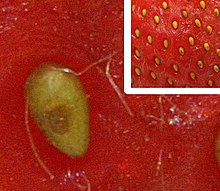
 Akène sà la surface de la tige de l’infructescence d’un fraisier
Akène sà la surface de la tige de l’infructescence d’un fraisier 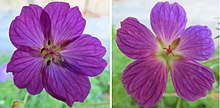
 Les fleurs de Geranium incanum sont actinomorphes , ayant cinq axes de symétrie, par opposition aux deux axes de symétrie des fleurs zygomorphes de la plupart des espèces du genre apparenté Pelargonium .
Les fleurs de Geranium incanum sont actinomorphes , ayant cinq axes de symétrie, par opposition aux deux axes de symétrie des fleurs zygomorphes de la plupart des espèces du genre apparenté Pelargonium . 
 Fronde de fougère à folioles acuminées
Fronde de fougère à folioles acuminées 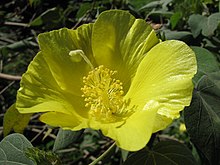
 Étamines Adelphous en fleur de Gossypium tomentosum
Étamines Adelphous en fleur de Gossypium tomentosum 
 Fleur de Watsonia fendue ouverte et avec une étamine courbée vers le haut pour montrer son attachement adné au pétale.
Fleur de Watsonia fendue ouverte et avec une étamine courbée vers le haut pour montrer son attachement adné au pétale. 
 Schéma d’un fruit de noix de coco. L’ Albumen (endosperme) est étiqueté Alb.
Schéma d’un fruit de noix de coco. L’ Albumen (endosperme) est étiqueté Alb. 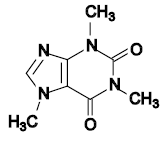
 La caféine est un alcaloïde avec quatre atomes d’azote dans son squelette carboné.
La caféine est un alcaloïde avec quatre atomes d’azote dans son squelette carboné. 
 Feuille de Rothmannia à nervation largement anastomosée
Feuille de Rothmannia à nervation largement anastomosée 
 Fleur androgyne de Sandersonia aurantiaca coupée longitudinalement pour montrer l’ androcée , qui comprend les anthères entourant le pistil central vert .
Fleur androgyne de Sandersonia aurantiaca coupée longitudinalement pour montrer l’ androcée , qui comprend les anthères entourant le pistil central vert . 
 Anthère de Lilium en état d’ anthèse, déhiscente et libérant du pollen
Anthère de Lilium en état d’ anthèse, déhiscente et libérant du pollen 
 Une espèce de Neea , famille des Nyctaginaceae , présente un exemple d’ anthocarpe : le calice et le style restent autour du fruit mûrissant.
Une espèce de Neea , famille des Nyctaginaceae , présente un exemple d’ anthocarpe : le calice et le style restent autour du fruit mûrissant. 
 Les fleurs aphanantes des chênes comme le Quercus robur , étant anémophiles , n’ont pas besoin de se faire remarquer des animaux pollinisateurs.
Les fleurs aphanantes des chênes comme le Quercus robur , étant anémophiles , n’ont pas besoin de se faire remarquer des animaux pollinisateurs. 
 Bourgeon apical d’une pousse de peuplier
Bourgeon apical d’une pousse de peuplier 

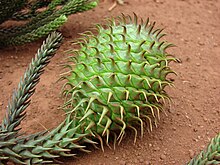
 Les apophyses sur les extrémités des écailles coniques d’ Araucaria cunninghamii correspondent à des pointes.
Les apophyses sur les extrémités des écailles coniques d’ Araucaria cunninghamii correspondent à des pointes. 
 Les poils des feuilles d’ Alyssum linifolium sont étoilés et appliqués à la surface des feuilles.
Les poils des feuilles d’ Alyssum linifolium sont étoilés et appliqués à la surface des feuilles. 

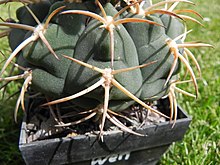


 Blighia , graines d’Akee, une entière, une en coupe longitudinale, montrant l’ arille pâle
Blighia , graines d’Akee, une entière, une en coupe longitudinale, montrant l’ arille pâle 
 Infructescence de seigle sauvage, montrant des arêtes proéminentes
Infructescence de seigle sauvage, montrant des arêtes proéminentes 
 Anatomie d’une arête et de poils sur une espèce d’herbe australienne
Anatomie d’une arête et de poils sur une espèce d’herbe australienne 
 Bourgeons axillaires dans la feuille un B- Un préfixe signifiant “de, loin de ou à l’extérieur”. abaxial La surface d’un organe opposée à l’axe de l’organe, par exemple la surface inférieure d’un organe latéral tel qu’une feuille ou un pétale. [1] Contraste adaxial . avorter Abandonner le développement d’une structure ou d’un organe. abscission La perte d’un organe mûr ou vieilli, comme un fruit mûr ou une vieille feuille. zone d’abscission Couche de tissu spécialisée qui permet à un organe de se détacher par abscission lorsqu’il est mûr ou sénescent. Un tel tissu est généralement formé, par exemple, à la base d’un pétiole ou d’un pédicelle . acaulescent N’ayant pas de tige apparente , ou du moins aucune visible au-dessus de la surface du sol. [1] Les exemples incluent certaines espèces d’ Agave , d’ Oxalis et d’ Attalea . [2] Antonyme de caulescent (possédant un radical) accrescent Augmentation de la taille avec l’âge, comme un calice qui continue de croître après la chute de la corolle , [1] par exemple chez Physalis peruviana . titulaire Allongé contre une autre partie de la plante; lorsqu’il est appliqué à un cotylédon , cela signifie qu’un bord du cotylédon se trouve le long de la radicule . -acées Suffixe ajouté à la racine d’un nom générique pour former le nom d’une famille taxonomique ; par exemple, les Rosaceae sont la famille des roses, dont le genre type est Rosa . akène Fruit sec indéhiscent à une seule graine [3] dans lequel le vrai fruit n’est pas la soi-disant “baie”, mais les akènes, qui sont les soi-disant “graines” sur l’ infructescence , par exemple dans le genre Fragaria . aciculaire Mince ou en forme d’aiguille. [3] acropète Passage des racines aux feuilles, par exemple des signaux moléculaires chez les plantes. acrophylle Les feuilles régulières d’une plante mature, produites au-dessus de la base, par opposition à la bathyphylle . acrostichoïde (décrivant un type de sorus ) Couvrant toute la surface abaxiale d’une fronde , généralement de manière dense, comme dans Elaphoglossum et Acrostichum . actino- Un préfixe qui indique un motif radial , une forme ou une morphologie. actinodrome ( nervation foliaire ) Nervation palmée ou disposée radialement avec trois veines primaires ou plus apparaissant à ou près de la base de la feuille et atteignant la marge chez la plupart des espèces, mais pas toutes. actinomorphe Régulier ou à symétrie radiale ; [4] peut être divisé en moitiés similaires dans au moins deux plans. S’applique par exemple aux stèles et aux fleurs dans lesquelles les segments du périanthe à l’intérieur de chaque verticille sont semblables en taille et en forme. Comparer régulier ; contraste asymétrique , irrégulier et zygomorphe . aculé Armé d’aiguillons, [5] par exemple la tige d’une rose. acuminé Se rétrécissant progressivement jusqu’à un point, avec des côtés concaves s’approchant du point. [5] Contraste aigu et mucroné . aigu 1. Aiguë, mais non allongée, avec des côtés droits approchant la pointe. [5] Contraste acuminé . 2. Convergent à un angle inférieur à 90°. Contraste obtus . un d- Un préfixe signifiant “près ou vers” ; signifiant aussi “ajouté à”. [5] adaxial La surface d’un organe tournée vers l’axe de l’organe, [5] par exemple la surface supérieure d’un organe latéral tel qu’une feuille ou un pétale. Contraste abaxial . Adelphie Pluriel : adelphie. Un faisceau ou une structure d’étamines formant une unité dans une fleur adelphe ; par exemple, le tube d’étamine autour du pistil d’ Hibiscus . adelphos Ayant des organes, en particulier des filaments tels que des étamines, reliés en une ou plusieurs adelphies , qu’elles soient sous forme de grappes ou de tubes, comme on en voit couramment dans des familles telles que les Malvacées . L’utilisation du terme n’est pas cohérente; certains auteurs incluent des filaments étroitement groupés, tandis que d’autres n’incluent que des adelphies dans lesquelles les filaments sont connectés à leurs bases au moins. Voir par exemple, Sims : “…les filaments sont si serrés qu’ils ont l’apparence d’être monadelphes…”. [6] Comparez les termes dérivés tels que monadelphous , ayant des étamines poussant dans un seul bouquet ou tube, par exemple dans Hibiscus , et diadelphe poussant en deux grappes. adhérent Légèrement uni à un organe d’un autre type [5] , généralement à une partie d’un autre verticille, par exemple un sépale relié à un pétale. Contraste adné . adné Cultivé à partir ou étroitement fusionné à un organe d’un type différent, [5] en particulier le long d’une marge , par exemple une étamine fusionnée à un pétale. Les anthères adnées ont leurs moitiés attachées au filament sur la majeure partie de leur longueur. (Contraste conné .) adventice Produit dans une position imprévisible ou inhabituelle, [5] par exemple un bourgeon adventif produit à partir d’une tige plutôt qu’à partir de l’ aisselle plus typique d’une feuille . Les racines adventives peuvent se développer à partir des nœuds des tiges prostrées de certaines espèces végétales, ou à partir de l’ hypocotyle plutôt qu’à partir de la radicule d’un monocotylédon en germination . adventif Introduit accidentellement [5] (faisant généralement référence à une mauvaise herbe ). aérien De l’air; croissant ou porté au-dessus de la surface du sol ou de l’eau. [7] estivation Disposition des sépales et des pétales ou de leurs lobes dans un bouton floral non développé . Vernation de contraste . aff. (affinis) Avec affinité avec les autres, semblable à; souvent utilisé pour un taxon provisoirement reconnu mais sans nom considéré comme proche de ce nom, peut-être une variante hybride ou extrême. fruits agrégés Une grappe de fruits formés à partir des carpelles libres d’une seule fleur, par exemple une mûre . Comparez plusieurs fruits . agochorique Plantes qui se propagent par transport accidentel. mauvaise herbe agricole Voir mauvaise herbe . agrophyte Espèces végétales qui ont envahi la végétation indigène et qui pourraient y survivre sans intervention humaine. Ils y sont établis dans des habitats naturels, faisant toujours partie de la végétation naturelle même après la fin de l’influence humaine, et sont indépendants des humains dans leur existence continue. [8] agronome une série de veines en forme de peigne bifurquant d’un seul côté d’une veine primaire ou secondaire en retard Avoir une aile ou des ailes. Albumen Ancien nom de l’ endosperme des plantes à fleurs. Sauf qu’il s’agit d’un tissu de stockage de nutriments, il ne ressemble en rien à l’Albumen ( blanc d’œuf ) des embryons d’animaux. albumineux (de graines ) Contenant de l’endosperme . -ales Un suffixe ajouté à la racine d’un nom générique ou d’un nom descriptif pour former le nom d’un ordre taxonomique . extraterrestre Toute plante introduite dans une zone en dehors de son aire de répartition naturelle. Souvent utilisé de manière interchangeable ou en combinaison avec étranger , exotique , non indigène et non indigène . alcaloïde Toute classe vaguement définie de composés organiques trouvés dans les tissus de nombreuses espèces de plantes. Les molécules d’alcaloïdes ont un ou plusieurs atomes d’azote à réaction alcaline dans leurs structures carbonées. De nombreux alcaloïdes sont commercialement importants en tant que médicaments ou poisons, par exemple la caféine , la morphine , la quinine et la strychnine , chacun étant naturellement présent dans certaines plantes. alterner 1. (adj.) (de feuilles ou de fleurs ) Portées seules à différents niveaux le long d’une tige , y compris les parties spiralées. Contraste ci -contre . 2. (prép.) Survenant entre quelque chose d’autre, par exemple des étamines alternant avec des pétales . ament Synonyme de chaton . amphitrope (D’un ovule ) Plié de manière à ce que les deux extrémités soient proches l’une de l’autre. Contraste anatrope , campylotrope et orthotrope . amplexicaul Avec la base dilatée et enserrant la tige, généralement des feuilles. étoile d’amylum un corps végétatif propagatif rempli d’ amidon (amylum) et situé autour des nœuds inférieurs de certains stonewort s. anastomoser Ramification et ensuite rejoindre, comme avec la nervation des feuilles . Anastomose Connexion ou fusion de deux ou plusieurs veines qui divergent ou se ramifient normalement, formant ainsi un réseau. anatrope (d’un ovule ) Inversé de sorte que le micropyle fasse face au placenta (c’est l’orientation la plus courante de l’ovule chez les plantes à fleurs). Contraste amphitrope , campylotrope et orthotrope . androdioïque Avoir des fleurs bisexuées et des fleurs mâles sur des individus séparés. Contraste andromonoïque , polygamodioïque , polygamomonoique et polygame . androcée Nom collectif désignant les organes reproducteurs mâles d’une fleur ; les étamines d’une fleur considérées collectivement. Gynécée de contraste . A abrégé ; ex. A 3+3 indique six étamines en deux verticilles . androgynophore Pédoncule portant à la fois l’ androcée et le gynécée d’une fleur au-dessus du niveau d’ insertion du périanthe . androgyne Avoir des fleurs mâles et femelles dans la même inflorescence . androphore Tige ou colonne supportant les étamines de certaines fleurs. andromonoïque Avoir des fleurs bisexuées et des fleurs mâles sur la même plante individuelle. Opposez androdioïque , gymononoïque , polygamodioïque , polygamomonoique et polygame . anémophile Adapté à la pollinisation par le vent . anémophilie Adaptation à la pollinisation par le vent . angiospermes Une plante à fleurs ; une plante dont les graines se développent enfermées dans un ovaire . anisomérie La condition d’avoir un verticille floral avec un nombre de pièces différent (généralement plus petit) des autres verticilles floraux. anisotomique Ramifié, avec des branches ayant des diamètres inégaux, comme un tronc et sa branche. Contraste isotomique . annuel Une plante qui termine son cycle de vie (c.-à-d. germe, se reproduit et meurt) en une seule année ou saison de croissance. anneau 1. Une structure en forme d’anneau ; en forme d’anneau. Les soies du pappus sont parfois attachées à un anneau appelé anneau ou disque au sommet du bec de l’ akène . Dans certains grains de pollen , l’exine autour des ouvertures est plus épaisse ou plus fine. Dans les pores, cette bordure est appelée anneau. Certaines fleurs ont des constrictions en forme d’anneau à l’embouchure de la fleur, par exemple chez Huernia et Aristolochia . 2. Un anneau de cellules spécialisées sur le sporange . antérieur Positionné devant, vers l’ apex . Comparez distal . anthémioïde Dans les Compositae , un style avec une touffe de poils en forme de pinceau à l’extrémité de chaque branche de style. anthère La partie pollinifère d’une étamine . anthéridie chez les bryophytes, un organe gamétophytique spécialisé qui produit les gamètes mâles anthéridiophore Chez les hépatiques de l’ordre des Marchantiales, un gamétophore mâle , une structure pédonculée spécialisée qui porte les anthéridies anthérode Une anthère stérile d’un staminode . anthèse 1. (d’une fleur) La période pendant laquelle le pollen est présenté et/ou le stigmate est réceptif. 2. (d’une plante à fleurs) La période pendant laquelle les fleurs en anthèse sont présentes. Non défini pour certains cas, comme lorsque le pollen est libéré dans le bourgeon. anthocarpe Type de fruit dans lequel une partie de la fleur persiste attachée au péricarpe , par exemple chez les Nyctaginaceae . anthophore Une structure en forme de tige, entre- nœud situé entre le calice et les autres parties de la fleur. anticlinal Pointant vers le haut, à l’opposé ou perpendiculairement à une surface. Contraste périclinal . ancré Dirigé vers ou vers le haut, par exemple des poils d’une tige. Rétroverse de contraste . apétale Manque de pétales . sommet
Bourgeons axillaires dans la feuille un B- Un préfixe signifiant “de, loin de ou à l’extérieur”. abaxial La surface d’un organe opposée à l’axe de l’organe, par exemple la surface inférieure d’un organe latéral tel qu’une feuille ou un pétale. [1] Contraste adaxial . avorter Abandonner le développement d’une structure ou d’un organe. abscission La perte d’un organe mûr ou vieilli, comme un fruit mûr ou une vieille feuille. zone d’abscission Couche de tissu spécialisée qui permet à un organe de se détacher par abscission lorsqu’il est mûr ou sénescent. Un tel tissu est généralement formé, par exemple, à la base d’un pétiole ou d’un pédicelle . acaulescent N’ayant pas de tige apparente , ou du moins aucune visible au-dessus de la surface du sol. [1] Les exemples incluent certaines espèces d’ Agave , d’ Oxalis et d’ Attalea . [2] Antonyme de caulescent (possédant un radical) accrescent Augmentation de la taille avec l’âge, comme un calice qui continue de croître après la chute de la corolle , [1] par exemple chez Physalis peruviana . titulaire Allongé contre une autre partie de la plante; lorsqu’il est appliqué à un cotylédon , cela signifie qu’un bord du cotylédon se trouve le long de la radicule . -acées Suffixe ajouté à la racine d’un nom générique pour former le nom d’une famille taxonomique ; par exemple, les Rosaceae sont la famille des roses, dont le genre type est Rosa . akène Fruit sec indéhiscent à une seule graine [3] dans lequel le vrai fruit n’est pas la soi-disant “baie”, mais les akènes, qui sont les soi-disant “graines” sur l’ infructescence , par exemple dans le genre Fragaria . aciculaire Mince ou en forme d’aiguille. [3] acropète Passage des racines aux feuilles, par exemple des signaux moléculaires chez les plantes. acrophylle Les feuilles régulières d’une plante mature, produites au-dessus de la base, par opposition à la bathyphylle . acrostichoïde (décrivant un type de sorus ) Couvrant toute la surface abaxiale d’une fronde , généralement de manière dense, comme dans Elaphoglossum et Acrostichum . actino- Un préfixe qui indique un motif radial , une forme ou une morphologie. actinodrome ( nervation foliaire ) Nervation palmée ou disposée radialement avec trois veines primaires ou plus apparaissant à ou près de la base de la feuille et atteignant la marge chez la plupart des espèces, mais pas toutes. actinomorphe Régulier ou à symétrie radiale ; [4] peut être divisé en moitiés similaires dans au moins deux plans. S’applique par exemple aux stèles et aux fleurs dans lesquelles les segments du périanthe à l’intérieur de chaque verticille sont semblables en taille et en forme. Comparer régulier ; contraste asymétrique , irrégulier et zygomorphe . aculé Armé d’aiguillons, [5] par exemple la tige d’une rose. acuminé Se rétrécissant progressivement jusqu’à un point, avec des côtés concaves s’approchant du point. [5] Contraste aigu et mucroné . aigu 1. Aiguë, mais non allongée, avec des côtés droits approchant la pointe. [5] Contraste acuminé . 2. Convergent à un angle inférieur à 90°. Contraste obtus . un d- Un préfixe signifiant “près ou vers” ; signifiant aussi “ajouté à”. [5] adaxial La surface d’un organe tournée vers l’axe de l’organe, [5] par exemple la surface supérieure d’un organe latéral tel qu’une feuille ou un pétale. Contraste abaxial . Adelphie Pluriel : adelphie. Un faisceau ou une structure d’étamines formant une unité dans une fleur adelphe ; par exemple, le tube d’étamine autour du pistil d’ Hibiscus . adelphos Ayant des organes, en particulier des filaments tels que des étamines, reliés en une ou plusieurs adelphies , qu’elles soient sous forme de grappes ou de tubes, comme on en voit couramment dans des familles telles que les Malvacées . L’utilisation du terme n’est pas cohérente; certains auteurs incluent des filaments étroitement groupés, tandis que d’autres n’incluent que des adelphies dans lesquelles les filaments sont connectés à leurs bases au moins. Voir par exemple, Sims : “…les filaments sont si serrés qu’ils ont l’apparence d’être monadelphes…”. [6] Comparez les termes dérivés tels que monadelphous , ayant des étamines poussant dans un seul bouquet ou tube, par exemple dans Hibiscus , et diadelphe poussant en deux grappes. adhérent Légèrement uni à un organe d’un autre type [5] , généralement à une partie d’un autre verticille, par exemple un sépale relié à un pétale. Contraste adné . adné Cultivé à partir ou étroitement fusionné à un organe d’un type différent, [5] en particulier le long d’une marge , par exemple une étamine fusionnée à un pétale. Les anthères adnées ont leurs moitiés attachées au filament sur la majeure partie de leur longueur. (Contraste conné .) adventice Produit dans une position imprévisible ou inhabituelle, [5] par exemple un bourgeon adventif produit à partir d’une tige plutôt qu’à partir de l’ aisselle plus typique d’une feuille . Les racines adventives peuvent se développer à partir des nœuds des tiges prostrées de certaines espèces végétales, ou à partir de l’ hypocotyle plutôt qu’à partir de la radicule d’un monocotylédon en germination . adventif Introduit accidentellement [5] (faisant généralement référence à une mauvaise herbe ). aérien De l’air; croissant ou porté au-dessus de la surface du sol ou de l’eau. [7] estivation Disposition des sépales et des pétales ou de leurs lobes dans un bouton floral non développé . Vernation de contraste . aff. (affinis) Avec affinité avec les autres, semblable à; souvent utilisé pour un taxon provisoirement reconnu mais sans nom considéré comme proche de ce nom, peut-être une variante hybride ou extrême. fruits agrégés Une grappe de fruits formés à partir des carpelles libres d’une seule fleur, par exemple une mûre . Comparez plusieurs fruits . agochorique Plantes qui se propagent par transport accidentel. mauvaise herbe agricole Voir mauvaise herbe . agrophyte Espèces végétales qui ont envahi la végétation indigène et qui pourraient y survivre sans intervention humaine. Ils y sont établis dans des habitats naturels, faisant toujours partie de la végétation naturelle même après la fin de l’influence humaine, et sont indépendants des humains dans leur existence continue. [8] agronome une série de veines en forme de peigne bifurquant d’un seul côté d’une veine primaire ou secondaire en retard Avoir une aile ou des ailes. Albumen Ancien nom de l’ endosperme des plantes à fleurs. Sauf qu’il s’agit d’un tissu de stockage de nutriments, il ne ressemble en rien à l’Albumen ( blanc d’œuf ) des embryons d’animaux. albumineux (de graines ) Contenant de l’endosperme . -ales Un suffixe ajouté à la racine d’un nom générique ou d’un nom descriptif pour former le nom d’un ordre taxonomique . extraterrestre Toute plante introduite dans une zone en dehors de son aire de répartition naturelle. Souvent utilisé de manière interchangeable ou en combinaison avec étranger , exotique , non indigène et non indigène . alcaloïde Toute classe vaguement définie de composés organiques trouvés dans les tissus de nombreuses espèces de plantes. Les molécules d’alcaloïdes ont un ou plusieurs atomes d’azote à réaction alcaline dans leurs structures carbonées. De nombreux alcaloïdes sont commercialement importants en tant que médicaments ou poisons, par exemple la caféine , la morphine , la quinine et la strychnine , chacun étant naturellement présent dans certaines plantes. alterner 1. (adj.) (de feuilles ou de fleurs ) Portées seules à différents niveaux le long d’une tige , y compris les parties spiralées. Contraste ci -contre . 2. (prép.) Survenant entre quelque chose d’autre, par exemple des étamines alternant avec des pétales . ament Synonyme de chaton . amphitrope (D’un ovule ) Plié de manière à ce que les deux extrémités soient proches l’une de l’autre. Contraste anatrope , campylotrope et orthotrope . amplexicaul Avec la base dilatée et enserrant la tige, généralement des feuilles. étoile d’amylum un corps végétatif propagatif rempli d’ amidon (amylum) et situé autour des nœuds inférieurs de certains stonewort s. anastomoser Ramification et ensuite rejoindre, comme avec la nervation des feuilles . Anastomose Connexion ou fusion de deux ou plusieurs veines qui divergent ou se ramifient normalement, formant ainsi un réseau. anatrope (d’un ovule ) Inversé de sorte que le micropyle fasse face au placenta (c’est l’orientation la plus courante de l’ovule chez les plantes à fleurs). Contraste amphitrope , campylotrope et orthotrope . androdioïque Avoir des fleurs bisexuées et des fleurs mâles sur des individus séparés. Contraste andromonoïque , polygamodioïque , polygamomonoique et polygame . androcée Nom collectif désignant les organes reproducteurs mâles d’une fleur ; les étamines d’une fleur considérées collectivement. Gynécée de contraste . A abrégé ; ex. A 3+3 indique six étamines en deux verticilles . androgynophore Pédoncule portant à la fois l’ androcée et le gynécée d’une fleur au-dessus du niveau d’ insertion du périanthe . androgyne Avoir des fleurs mâles et femelles dans la même inflorescence . androphore Tige ou colonne supportant les étamines de certaines fleurs. andromonoïque Avoir des fleurs bisexuées et des fleurs mâles sur la même plante individuelle. Opposez androdioïque , gymononoïque , polygamodioïque , polygamomonoique et polygame . anémophile Adapté à la pollinisation par le vent . anémophilie Adaptation à la pollinisation par le vent . angiospermes Une plante à fleurs ; une plante dont les graines se développent enfermées dans un ovaire . anisomérie La condition d’avoir un verticille floral avec un nombre de pièces différent (généralement plus petit) des autres verticilles floraux. anisotomique Ramifié, avec des branches ayant des diamètres inégaux, comme un tronc et sa branche. Contraste isotomique . annuel Une plante qui termine son cycle de vie (c.-à-d. germe, se reproduit et meurt) en une seule année ou saison de croissance. anneau 1. Une structure en forme d’anneau ; en forme d’anneau. Les soies du pappus sont parfois attachées à un anneau appelé anneau ou disque au sommet du bec de l’ akène . Dans certains grains de pollen , l’exine autour des ouvertures est plus épaisse ou plus fine. Dans les pores, cette bordure est appelée anneau. Certaines fleurs ont des constrictions en forme d’anneau à l’embouchure de la fleur, par exemple chez Huernia et Aristolochia . 2. Un anneau de cellules spécialisées sur le sporange . antérieur Positionné devant, vers l’ apex . Comparez distal . anthémioïde Dans les Compositae , un style avec une touffe de poils en forme de pinceau à l’extrémité de chaque branche de style. anthère La partie pollinifère d’une étamine . anthéridie chez les bryophytes, un organe gamétophytique spécialisé qui produit les gamètes mâles anthéridiophore Chez les hépatiques de l’ordre des Marchantiales, un gamétophore mâle , une structure pédonculée spécialisée qui porte les anthéridies anthérode Une anthère stérile d’un staminode . anthèse 1. (d’une fleur) La période pendant laquelle le pollen est présenté et/ou le stigmate est réceptif. 2. (d’une plante à fleurs) La période pendant laquelle les fleurs en anthèse sont présentes. Non défini pour certains cas, comme lorsque le pollen est libéré dans le bourgeon. anthocarpe Type de fruit dans lequel une partie de la fleur persiste attachée au péricarpe , par exemple chez les Nyctaginaceae . anthophore Une structure en forme de tige, entre- nœud situé entre le calice et les autres parties de la fleur. anticlinal Pointant vers le haut, à l’opposé ou perpendiculairement à une surface. Contraste périclinal . ancré Dirigé vers ou vers le haut, par exemple des poils d’une tige. Rétroverse de contraste . apétale Manque de pétales . sommet
PL. sommets
Le pourboire; le point le plus éloigné du point d’attache. aphanante (de fleurs) Discret ou discret, par opposition à phaneranthous ou voyant. aphlébie
PL. aphlébies
Terminaisons de feuilles imparfaites ou irrégulières que l’on trouve couramment sur les fougères et les fossiles de fougères de la période carbonifère . apical Au niveau ou sur le sommet d’une structure, généralement une pousse , une tige ou le tronc d’un arbre, par exemple un méristème apical ou un bourgeon apical . apiculé surtout des feuilles, se terminant par une courte pointe triangulaire. apiphilie Une forme de pollinisation par laquelle le pollen est distribué par les abeilles mellifères . apo- Un préfixe signifiant “loin de, séparé, sans”. apocarpe (d’un gynécée ) Composé d’un ou plusieurs carpelles qui sont libres les uns des autres (ou presque), par exemple chez les membres des Ranunculaceae et Dilleniaceae . apomixie
adj. apomictique
Type de reproduction asexuée par lequel des graines ou des spores viables sont produites de manière asexuée, sans fécondation , de sorte que le matériel génétique qu’elles contiennent est un clone du matériel génétique du parent. Une plante ainsi produite est appelée apomicte . apomorphie En cladistique , une “forme différente” de la forme d’un ancêtre (c’est-à-dire une innovation ) utilisée pour déterminer l’appartenance à un clade . apopétale Ayant des pétales séparés , non fusionnés ( sympétales ). apophylle périanthe ou autres segments libres, non unis. Comparer symphylle , gamophyle , polyphylle . apophyse 1. La partie externe d’une échelle conique . 2. Une excroissance d’un organe ou un élargissement d’une tige . appendice Une partie secondaire attachée à une structure principale ; une excroissance externe qui a rarement une fonction évidente, donc appendiculaire . appendiculaire Ayant la nature ou portant un appendice art. apprimé Pressées étroitement mais non fusionnées, par exemple feuilles contre une tige. plante aquatique Une plante dont l’habitat naturel est l’eau, vivant dans ou sur l’eau pendant la totalité ou une partie substantielle de sa durée de vie ; généralement limité aux eaux douces ou intérieures. arachnoïde Cobwebby, d’être couvert de poils fins et blancs. arborescent Arbre – comme dans la croissance ou l’apparence générale. arboretum
PL. arboretum
Une collection d’ arbres classés taxonomiquement . archéophyte Plante non indigène qui est néanmoins présente dans une zone géographique donnée depuis un certain temps. Contraste néophyte . archégone Structure multicellulaire ou organe de la phase gamétophyte de certaines plantes, produisant et contenant l’ovule ou le gamète femelle. L’organe mâle correspondant s’appelle l’anthéridie. archégoniophore Chez les hépatiques de l’ordre des Marchantiales, un gamétophore femelle , structure pédonculée spécialisée qui porte les archégones et les sporophytes arctotoïde Chez les Composées , un style avec un anneau de poils larges porté sur la tige du style à proximité des branches du style. aréolé Ayant ou étant composé d’ aréoles , comme un lichen crustacé aréolé . aréole 1. Un espace entre les fils d’un filet, par exemple la partie d’une surface foliaire définie par chacun des éléments d’un réseau de veines ; comme pour les cactus, la zone entre les veinules d’une feuille. 2. Une structure sur le nœud de la tige d’un cactus ; la région d’un cactus sur laquelle sont portées des épines et des fleurs. 3. En lichénologie , un morceau polygonal d’une surface de thalle où un lichen crustacé est brisé comme de la vieille peinture séchée et craquelée, ou comme les “îlots” polygonaux de boue séchée dans un lit de lac asséché . arille Appendice membraneux ou charnu formé par l’expansion du funicule qui recouvre partiellement ou entièrement une graine , par exemple la couche externe charnue du fruit du litchi , ou celle trouvée chez les membres des Sapindaceae . aristocrate Avec une arête ou une pointe raide en forme de poils. article Un segment d’une tige articulée ou d’un fruit avec des constrictions entre les graines; une partie d’organe qui se sépare facilement du reste de l’organe au niveau d’une articulation ou d’une articulation. articuler articulé ; se séparer librement, laissant une cicatrice propre; par exemple les frondes de certaines fougères où elles rejoignent le rhizome . Ascendant 1. (d’une tige ) S’étalant horizontalement, puis dirigé vers le haut ; une tige ascendante est plus ou moins couchée près de sa base, puis dressée . 2. (d’un ovule ) attaché un peu au-dessus de la base. reproduction asexuée Reproduction sans gamètes . Souvent utilisé de manière interchangeable avec la reproduction végétative . aspérité Avoir une texture rugueuse et ponceuse, par exemple certaines surfaces de feuilles. asymétrique Irrégulier ou inégal ; dépourvu de tout plan de symétrie ; par exemple les fleurs de Canna . atténuer Se rétrécit progressivement. oreillette Un lobe en forme d’oreille , en particulier un petit appendice latéral arrondi d’une feuille ou d’un organe semblable à une feuille. awn 1. Tout long appendice en forme de soie . 2. Chez les Poacées , un appendice se terminant ou sur le dos des glumes et/ou des lemmes de certains épillets de graminées . 3. Chez les Géraniacées , la partie du style qui reste attachée au carpelle qui se sépare du carpophore (colonne). 4. Un élément de pappus généralement droit et rigide , variant de raide en forme de soie à dur et en forme d’aiguille. Chez Strophanthus , l’arête est le bec de la graine , stipe des poils de la chevelure . à l’ aisselle et un bourgeon apical naissant de l’ apex de la pousse de Searsia angustifolia. Les bourgeons axillaires sont dormants dans des cataphylles écailleuses , mais le bourgeon apical est nu, exposant des rudiments de feuilles émergentes . aisselle L’angle supérieur entre une partie d’une plante et une autre, par exemple la tige et une feuille. axile Sur un axe ; d’un placenta , sur l’axe central de l’ ovaire . axillaire Porté dans ou provenant de l’ aisselle , se référant généralement à l’aisselle d’une feuille. axe Tige principale d’une plante entière ou inflorescence ; aussi, la ligne le long de laquelle cette tige s’étend.
B

 Desmide baculiforme du genre Closterium
Desmide baculiforme du genre Closterium 
 Des barbes apparaissent sur les épines de certaines espèces de cactus, comme illustré ici agrandi.
Des barbes apparaissent sur les épines de certaines espèces de cactus, comme illustré ici agrandi. 
 Baies d’ Olinia ventosa , y compris une coupe transversale montrant des graines dures dans la pulpe
Baies d’ Olinia ventosa , y compris une coupe transversale montrant des graines dures dans la pulpe 
 Les feuilles composées bifoliées de l’arbre Mopane, Colophospermum mopane , ont suggéré le nom commun “arbre à papillons”.
Les feuilles composées bifoliées de l’arbre Mopane, Colophospermum mopane , ont suggéré le nom commun “arbre à papillons”. 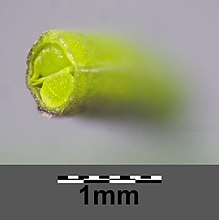
 Coupe d’ une silique d’ Arabidopsis thaliana , montrant qu’elle est biloculée , formée de deux carpelles , morphologiquement une silique et non une gousse
Coupe d’ une silique d’ Arabidopsis thaliana , montrant qu’elle est biloculée , formée de deux carpelles , morphologiquement une silique et non une gousse 
 Feuille bipennée de Gymnocladus dioicus
Feuille bipennée de Gymnocladus dioicus 
 Structure d’une feuille composée biternée
Structure d’une feuille composée biternée 
 Ce baobab africain, Adansonia digitata , a un énorme fût sous une canopée relativement modeste qui est typique de cette espèce.
Ce baobab africain, Adansonia digitata , a un énorme fût sous une canopée relativement modeste qui est typique de cette espèce. 
 Les grandes bractées colorées de Bougainvillea sont souvent confondues avec ses pétales.
Les grandes bractées colorées de Bougainvillea sont souvent confondues avec ses pétales. 
 Bavures , fruits des espèces d’ Arctium
Bavures , fruits des espèces d’ Arctium 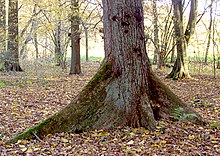
 Contrefort racine d’un ormemature baculiforme en forme de bâtonnet ; plus long que large. Comparer cylindrique . barbillon Un point orienté vers l’arrière, comme dans un hameçon . barbelé Avoir des barbes pointant dans une direction. barbiller Poils barbelés ( barbellae ). écorce La couche externe protectrice de tissu sur les tiges et les racines des arbres et arbustes ligneux ; comprend tous les tissus vivants et non vivants externes au cambium . basal Situé ou attaché à la base. basifixé Quelque chose attaché par sa base, par exemple une anthère attachée au filament . Comparez dorsifixé . basipète Se développant séquentiellement de l’ apex vers la base (c’est-à-dire avec les plus jeunes vers la base), par exemple de fleurs dans une inflorescence . En outre, le déplacement des feuilles aux racines, par exemple des signaux moléculaires chez les plantes. bathyphylle Feuille spécialisée produite à la base d’une plante, généralement lorsque la plante est immature, et qui sert à ancrer la plante à un substrat; particulièrement notable dans la fougère Teratophyllum . Contraste acrophylle . le bec Une saillie terminale proéminente et pointue, en particulier d’un carpelle ou d’un fruit . baie Type de fruit indéhiscent dont les graines sont immergées dans la pulpe, par exemple une tomate . bi- Un préfixe signifiant “deux” ; par exemple bisulcate , ayant deux sillons ou rainures. biennal Une plante qui termine son cycle de vie (c.-à-d. germe, se reproduit et meurt) en deux ans ou saisons de croissance. Les plantes bisannuelles forment généralement une rosette basale de feuilles la première année, puis fleurissent et fructifient la deuxième année. bifide À bifurcation; coupé en deux sur environ la moitié de sa longueur. Comparez trifide . bifoliée (d’une feuille composée ) Ayant précisément deux folioles , généralement en paire symétrique, par exemple une feuille de Colophospermum mopane . Comparez la feuille lobée juguée , par exemple la plupart des espèces de Bauhinia . bifusiforme Fusiforme avec une pincée au milieu. bilabiate Ayant deux lèvres, par exemple la forme des pétales de nombreuses fleurs irrégulières . bilatéral 1. Ayant deux côtés distincts, tels que les deux faces d’une feuille dorsiventrale . 2. Disposées sur des côtés opposés, p.ex. feuilles sur une tige ; cf. distiques et opposés . 3. Symétrique bilatéralement, comme dans une feuille avec un contour symétrique. biloculer Ayant deux loges , par exemple dans les anthères ou les ovaires . binôme Utilisation de noms composés de deux mots pour former le nom scientifique (ou combinaison) sous une forme latine. Par exemple, où le premier est le nom du genre auquel appartient l’ espèce , et le second est l’ épithète spécifique donnée à cette espèce pour la distinguer des autres du même genre. nomenclature binominale Système de nomenclature dans lequel le nom scientifique d’une espèce (et non d’un taxon à un autre rang) est une combinaison de deux noms, le premier étant le nom générique . Le deuxième nom est désigné botaniquement comme l’ épithète spécifique . Notez que les deux noms ensemble (pas seulement le deuxième nom) constituent le nom de l’espèce. bipenné Doublement penné ; par exemple une feuille composée avec des folioles individuelles pennées. bipinnatisecte Une feuille pennatiséquée avec des segments profondément disséqués. bisexuel Portant à la fois des organes reproducteurs mâles et femelles ; généralement, fleurs avec étamines et carpelles ; synonyme d’ hermaphrodite , synoïque et monocline . Les fleurs bisexuées n’apparaissent que sur les plantes monoïques . Voir aussi androgyne , monoïque et morphologie reproductive des plantes . mordu (d’un ovule ) Recouvert de deux téguments . Contraste unitégmique . biterné Ternate , avec chaque division divisée en trois. bivalve Avoir deux vannes ou pièces articulées. Trivalve de contraste . lame Limbe ou partie aplatie d’une feuille , à l’exclusion de la tige ou du pétiole . Floraison Fine poudre cireuse blanche ou bleuâtre présente sur les parties de la plante, généralement les tiges, les feuilles et les fruits. Il s’enlève facilement en frottant. fût Le tronc d’un arbre, généralement la partie située sous la branche la plus basse. Comparez la canopée . botrychoïde Disposé sur une surface conique (comme une coquille d’escargot); utilisé pour décrire les inflorescences dans lesquelles les bourgeons sont disposés de manière presque hélicoïdale à l’extérieur d’un long rachis conique et effilé . bractée Feuille modifiée associée à une fleur ou à une inflorescence et dont la forme, la taille ou la couleur diffèrent des autres feuilles (et sans bourgeon axillaire ). bracté Possédant des bractées . bractéole Une petite bractée portée seule ou par paires sur le pédicelle ou le calice ; synonyme de braclette . bractéolé Possédant des bractéoles (bractlets). bracté Voir bractéole . rameau Une petite branche . à feuilles caduques Une plante qui ne perd toutes ses feuilles que brièvement avant d’en faire pousser de nouvelles, de sorte qu’elle n’est sans feuilles que pendant une courte période, par exemple environ deux semaines. poil Un poil raide et raide (lisse ou avec des dents minuscules); la partie supérieure d’une arête (lorsque celle-ci est courbée et a une partie inférieure, plus robuste et généralement tordue, appelée la colonne ). brochidodrome Nervation pennée des feuilles dans laquelle les nervures secondaires ne se terminent pas au bord des feuilles , mais se rejoignent en une succession d’ arcs saillants . brochus
Contrefort racine d’un ormemature baculiforme en forme de bâtonnet ; plus long que large. Comparer cylindrique . barbillon Un point orienté vers l’arrière, comme dans un hameçon . barbelé Avoir des barbes pointant dans une direction. barbiller Poils barbelés ( barbellae ). écorce La couche externe protectrice de tissu sur les tiges et les racines des arbres et arbustes ligneux ; comprend tous les tissus vivants et non vivants externes au cambium . basal Situé ou attaché à la base. basifixé Quelque chose attaché par sa base, par exemple une anthère attachée au filament . Comparez dorsifixé . basipète Se développant séquentiellement de l’ apex vers la base (c’est-à-dire avec les plus jeunes vers la base), par exemple de fleurs dans une inflorescence . En outre, le déplacement des feuilles aux racines, par exemple des signaux moléculaires chez les plantes. bathyphylle Feuille spécialisée produite à la base d’une plante, généralement lorsque la plante est immature, et qui sert à ancrer la plante à un substrat; particulièrement notable dans la fougère Teratophyllum . Contraste acrophylle . le bec Une saillie terminale proéminente et pointue, en particulier d’un carpelle ou d’un fruit . baie Type de fruit indéhiscent dont les graines sont immergées dans la pulpe, par exemple une tomate . bi- Un préfixe signifiant “deux” ; par exemple bisulcate , ayant deux sillons ou rainures. biennal Une plante qui termine son cycle de vie (c.-à-d. germe, se reproduit et meurt) en deux ans ou saisons de croissance. Les plantes bisannuelles forment généralement une rosette basale de feuilles la première année, puis fleurissent et fructifient la deuxième année. bifide À bifurcation; coupé en deux sur environ la moitié de sa longueur. Comparez trifide . bifoliée (d’une feuille composée ) Ayant précisément deux folioles , généralement en paire symétrique, par exemple une feuille de Colophospermum mopane . Comparez la feuille lobée juguée , par exemple la plupart des espèces de Bauhinia . bifusiforme Fusiforme avec une pincée au milieu. bilabiate Ayant deux lèvres, par exemple la forme des pétales de nombreuses fleurs irrégulières . bilatéral 1. Ayant deux côtés distincts, tels que les deux faces d’une feuille dorsiventrale . 2. Disposées sur des côtés opposés, p.ex. feuilles sur une tige ; cf. distiques et opposés . 3. Symétrique bilatéralement, comme dans une feuille avec un contour symétrique. biloculer Ayant deux loges , par exemple dans les anthères ou les ovaires . binôme Utilisation de noms composés de deux mots pour former le nom scientifique (ou combinaison) sous une forme latine. Par exemple, où le premier est le nom du genre auquel appartient l’ espèce , et le second est l’ épithète spécifique donnée à cette espèce pour la distinguer des autres du même genre. nomenclature binominale Système de nomenclature dans lequel le nom scientifique d’une espèce (et non d’un taxon à un autre rang) est une combinaison de deux noms, le premier étant le nom générique . Le deuxième nom est désigné botaniquement comme l’ épithète spécifique . Notez que les deux noms ensemble (pas seulement le deuxième nom) constituent le nom de l’espèce. bipenné Doublement penné ; par exemple une feuille composée avec des folioles individuelles pennées. bipinnatisecte Une feuille pennatiséquée avec des segments profondément disséqués. bisexuel Portant à la fois des organes reproducteurs mâles et femelles ; généralement, fleurs avec étamines et carpelles ; synonyme d’ hermaphrodite , synoïque et monocline . Les fleurs bisexuées n’apparaissent que sur les plantes monoïques . Voir aussi androgyne , monoïque et morphologie reproductive des plantes . mordu (d’un ovule ) Recouvert de deux téguments . Contraste unitégmique . biterné Ternate , avec chaque division divisée en trois. bivalve Avoir deux vannes ou pièces articulées. Trivalve de contraste . lame Limbe ou partie aplatie d’une feuille , à l’exclusion de la tige ou du pétiole . Floraison Fine poudre cireuse blanche ou bleuâtre présente sur les parties de la plante, généralement les tiges, les feuilles et les fruits. Il s’enlève facilement en frottant. fût Le tronc d’un arbre, généralement la partie située sous la branche la plus basse. Comparez la canopée . botrychoïde Disposé sur une surface conique (comme une coquille d’escargot); utilisé pour décrire les inflorescences dans lesquelles les bourgeons sont disposés de manière presque hélicoïdale à l’extérieur d’un long rachis conique et effilé . bractée Feuille modifiée associée à une fleur ou à une inflorescence et dont la forme, la taille ou la couleur diffèrent des autres feuilles (et sans bourgeon axillaire ). bracté Possédant des bractées . bractéole Une petite bractée portée seule ou par paires sur le pédicelle ou le calice ; synonyme de braclette . bractéolé Possédant des bractéoles (bractlets). bracté Voir bractéole . rameau Une petite branche . à feuilles caduques Une plante qui ne perd toutes ses feuilles que brièvement avant d’en faire pousser de nouvelles, de sorte qu’elle n’est sans feuilles que pendant une courte période, par exemple environ deux semaines. poil Un poil raide et raide (lisse ou avec des dents minuscules); la partie supérieure d’une arête (lorsque celle-ci est courbée et a une partie inférieure, plus robuste et généralement tordue, appelée la colonne ). brochidodrome Nervation pennée des feuilles dans laquelle les nervures secondaires ne se terminent pas au bord des feuilles , mais se rejoignent en une succession d’ arcs saillants . brochus
PL. brochi
Largeur d’une lumière d’un réticulum de grain de pollen et moitié de la largeur des muri environnants (murs), d’où hétérobrochate et homobrochate , où les lumières sont de tailles différentes ou similaires, respectivement. bryophyte Officieusement, toute plante qui est une mousse , une anthocérote ou une hépatique . Formellement, ces plantes sont placées dans trois divisions distinctes : les hornworts ( Anthocerophyta ), les hépatiques ( Marchantiophyta ) et les mousses ( Bryophyta ). ampoule Un organe de stockage épais, généralement souterrain, composé d’une tige et de bases de feuilles (les internes charnues). bulbe Une ampoule provenant d’une autre ampoule. Voir bulbe . bulbille Petit bulbe ou tubercule à feuilles caduques formé à l’ aisselle d’une feuille ou d’une penne ; un moyen de propagation végétative. bulbille Une ampoule provenant d’une autre ampoule; un bulbe . buller Avoir des cloques arrondies ou globulaires à la surface. bavure 1. Un fruit piquant . 2. Une propagule rugueuse ou épineuse constituée d’une graine ou d’un fruit et de parties florales ou bractées associées . contrefort racine Racine poussant à partir d’ une tige ou d’un tronc hors sol, et fournissant un support, par exemple couramment de Ficus macrophylla . byssoïde Une forme de croissance d’un thalle de lichen qui est sifflant, comme de la laine taquinée .
C
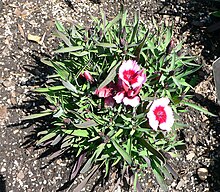
 Dianthus chinensis a une croissance cespiteuse .
Dianthus chinensis a une croissance cespiteuse . 
 Tissu calleux de Nicotiana tabacum poussant sur un milieu nutritif en culture de tissus végétaux}}
Tissu calleux de Nicotiana tabacum poussant sur un milieu nutritif en culture de tissus végétaux}} 
 Structure de la fleur d’une orchidée du genre Praecoxanthus , avec le callus étiqueté
Structure de la fleur d’une orchidée du genre Praecoxanthus , avec le callus étiqueté 
 Callus barbu d’un fleuron de l’espèce graminée Chrysopogon filipes
Callus barbu d’un fleuron de l’espèce graminée Chrysopogon filipes 
 Les bourgeons foliaires dormants des arbres à feuilles caduques sont généralement protégés par des cataphylles imbriquées qui se détachent lorsque le bourgeon pousse.
Les bourgeons foliaires dormants des arbres à feuilles caduques sont généralement protégés par des cataphylles imbriquées qui se détachent lorsque le bourgeon pousse. 
 Chatons mâles de Betula pendula
Chatons mâles de Betula pendula 



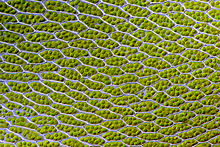
 Chloroplaste sdans les cellules des feuilles de la mousse Bryum capillare
Chloroplaste sdans les cellules des feuilles de la mousse Bryum capillare 
 Tous les chloroplastes ne sont pas de forme simple. Les chloroplastes de Spirogyra sont hélicoïdaux dans les cellules tubulaires de leurs filaments algaux.
Tous les chloroplastes ne sont pas de forme simple. Les chloroplastes de Spirogyra sont hélicoïdaux dans les cellules tubulaires de leurs filaments algaux. 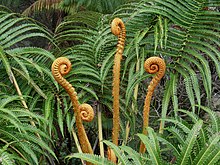
 Vernation circinée des crossesde la fougère Sadleria cyatheoides
Vernation circinée des crossesde la fougère Sadleria cyatheoides 
 Les soi-disant “feuilles charnues” des cactus comme cet Opuntia tomentosa sont en réalité des cladodes , des branches. Les vraies feuilles sont les épines qui poussent sur les cladodes, qui sur ce jeune cladode sont encore charnues.
Les soi-disant “feuilles charnues” des cactus comme cet Opuntia tomentosa sont en réalité des cladodes , des branches. Les vraies feuilles sont les épines qui poussent sur les cladodes, qui sur ce jeune cladode sont encore charnues. 
 Colonie de cellules formant un coenobium , d’une algue du genre Pediastrum
Colonie de cellules formant un coenobium , d’une algue du genre Pediastrum 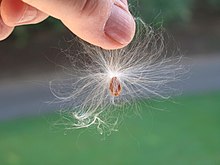
 Graines d ‘ Asclepias syriaca , montrant le coma de poils dans son aigrette
Graines d ‘ Asclepias syriaca , montrant le coma de poils dans son aigrette 




 Coma au sommet de Muscari armeniacum , portant des fleurs stériles
Coma au sommet de Muscari armeniacum , portant des fleurs stériles 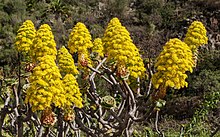
 L’ inflorescence composée conique d’ Aeonium arboreum est une panicule composée composée de panicules mineures, dont certaines sont composées à leur tour.
L’ inflorescence composée conique d’ Aeonium arboreum est une panicule composée composée de panicules mineures, dont certaines sont composées à leur tour. 
 Le marronnier de Californie ( Aesculus californica ) a une feuille palmée composée , les folioles partant d’un point central.
Le marronnier de Californie ( Aesculus californica ) a une feuille palmée composée , les folioles partant d’un point central. 
 Les lobes de la corolle gamopétale des fleurs de Nicotiana sont dupliqués dans le bourgeon.
Les lobes de la corolle gamopétale des fleurs de Nicotiana sont dupliqués dans le bourgeon. 
 Casuarina equisetifolia fleurs mâles et femelles et cône s
Casuarina equisetifolia fleurs mâles et femelles et cône s 
 La fleur de Watsonia gamopétale s’ouvre entre deux pétales pour montrer la formation connée du tube de la corolle . Comparez l’ attachement adné des bases des étamines aux pétales correspondants.
La fleur de Watsonia gamopétale s’ouvre entre deux pétales pour montrer la formation connée du tube de la corolle . Comparez l’ attachement adné des bases des étamines aux pétales correspondants. 
 Cormus , un entier dans sa tunique , un partiellement pelé pour montrer la cataphylle de laet un fendu pour montrer la structure interne
Cormus , un entier dans sa tunique , un partiellement pelé pour montrer la cataphylle de laet un fendu pour montrer la structure interne 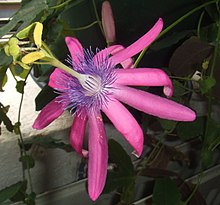
 La couronne de cette fleur de Passiflora est un anneau de filaments violets entre les pétales et les étamines.
La couronne de cette fleur de Passiflora est un anneau de filaments violets entre les pétales et les étamines. 
 Cotylédons de semis deKoelreuteria. Une plante montre les premières nouvelles feuilles au-dessus de ses cotylédons ; les autres montrent divers stades plus jeunes de cotylédons émergents.
Cotylédons de semis deKoelreuteria. Une plante montre les premières nouvelles feuilles au-dessus de ses cotylédons ; les autres montrent divers stades plus jeunes de cotylédons émergents. 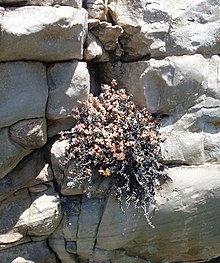
 Crassula rupestris pousse fréquemment sous forme de cremnophyte sur les parois des falaises du fynbos .
Crassula rupestris pousse fréquemment sous forme de cremnophyte sur les parois des falaises du fynbos . 
 Nymphoides crenata a marges de feuilles crénelées .
Nymphoides crenata a marges de feuilles crénelées . 
 Lichens crustacés surun mur
Lichens crustacés surun mur 
 Mimetes cucullatus , ainsi nommé pour la forme encapuchonnée et cucullée de ses fleurs blanches
Mimetes cucullatus , ainsi nommé pour la forme encapuchonnée et cucullée de ses fleurs blanches 


 Exemples de cupules de Fagacées :
Exemples de cupules de Fagacées :
A : Quercus rubra B : Quercus trojana
C : Fagus sylvatica D : Castanea sativa 
 Feuilles cuspidées de Diplacus bigelovii var. cuspidatus
Feuilles cuspidées de Diplacus bigelovii var. cuspidatus 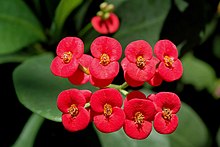
 Euphorbia milii est cultivé commercialement pour l’aspect esthétique de ses structures aux couleurs vives ressemblant à des bractées appelées cyathophylle s , qui se trouvent sous l’ inflorescence . C, C−, C+ En lichénologie , « C » est une abréviation pour le résultat du test consistant à placer une solution à 5 % d’hypochlorite de calcium ou d’hypochlorite de sodium (par exemple, de l’eau de Javel domestique sans additifs) sur le cortex ou la moelle d’un lichen , pour noter le changement de couleur, sans réaction noté “C-“, et production d’une couleur vive notée “C+”. caduc Chute précoce, par exemple les sépales de coquelicots, qui tombent lorsque les pétales commencent à s’ouvrir. Comparez persistant et fugace . cespiteux Touffe ou ressemblant à du gazon, par exemple la forme de croissance de certaines graminées. calcaire possédant un éperon . calcaire Un type de sol ou un type de roche de substrat de lichen qui est riche ou composé en grande partie de carbonate de calcium . calleux Endurci; épaissi; insensible. cal
Euphorbia milii est cultivé commercialement pour l’aspect esthétique de ses structures aux couleurs vives ressemblant à des bractées appelées cyathophylle s , qui se trouvent sous l’ inflorescence . C, C−, C+ En lichénologie , « C » est une abréviation pour le résultat du test consistant à placer une solution à 5 % d’hypochlorite de calcium ou d’hypochlorite de sodium (par exemple, de l’eau de Javel domestique sans additifs) sur le cortex ou la moelle d’un lichen , pour noter le changement de couleur, sans réaction noté “C-“, et production d’une couleur vive notée “C+”. caduc Chute précoce, par exemple les sépales de coquelicots, qui tombent lorsque les pétales commencent à s’ouvrir. Comparez persistant et fugace . cespiteux Touffe ou ressemblant à du gazon, par exemple la forme de croissance de certaines graminées. calcaire possédant un éperon . calcaire Un type de sol ou un type de roche de substrat de lichen qui est riche ou composé en grande partie de carbonate de calcium . calleux Endurci; épaissi; insensible. cal
PL. calli
1. Une masse de tissu en saillie 2. Croissance tissulaire indifférenciée formée en réponse à une blessure; peut être cultivé in vitro . 3. Chez les orchidées, excroissances charnues du labelle qui peuvent être de formes variées, des papilles aux plaques. 4. Chez les graminées, extension durcie à partir de la base d’un fleuron (formé à partir de l’ articulation rachidienne et/ou de la base de la lemme ) qui peut ou non s’allonger et qui est souvent couverte de poils ou de soies. calciflore Pétales et étamines attachés au calice . calycophylle Une structure en forme de feuille formée à partir d’un lobe de sépale ou de calice qui s’agrandit, généralement plusieurs fois, avant ou après l’anthèse , en particulier lorsque la plupart des autres sépales ou lobes de calice conservent leur taille d’origine. Plus extrêmes qu’un calice accrescent , les calycophylles se retrouvent chez les Rubiacées . Comparez sémaphylle et ptérophylle . calculer Avoir un épicalice . calicule 1. Une structure en forme de coupe formée de bractées ressemblant à un calice externe . 2. Chez certaines Astéracées , un cercle de bractées sous l’ involucre . calyptre Une hotte ou un couvercle. Voir opercule . calice
PL. calices
Un terme collectif pour les sépales d’une fleur; verticille externe d’une fleur, généralement verte. Comparez corolle . tube du calice Tube formé par la fusion des sépales ( calice ), au moins à la base. cambium Couche de tissu qui fournit des cellules partiellement indifférenciées pour la croissance des plantes. campanuler En forme de cloche. camptodrome Nervation pennée dans laquelle les veines secondaires se courbent vers les marges, devenant dans certains cas presque parallèles à elles, et ne se reconnectant pas avec d’autres veines pour former des boucles. campylotrope Lorsque l’ ovule est orienté transversalement (c’est-à-dire avec son axe perpendiculaire à sa tige) et avec un sac embryonnaire incurvé . Comparez amphitrope , anatrope et orthotrope . canaliculé Canalisé ; ayant une rainure longitudinale. gris Se rapprochant de la couleur blanche, comme dans une feuille recouverte de duvet blanc ou de laine. canopée Les branches et le feuillage d’un arbre ; la couronne . Fait également référence à la couche supérieure protectrice d’une forêt. Comparez le coffre . capillaire 1. Un tube, un pore ou un passage avec une section interne étroite. 2. Mince ; ressemblant à des cheveux. capitate 1. (d’une inflorescence ) Ayant une tête en forme de bouton, avec les fleurs non pédonculées et agrégées en une grappe dense. 2. (d’un stigmate ) Comme la tête d’une épingle. capitule Un amas dense de sessiles fleurs ou fleurons ou subsessiles , par exemple un capitule de la famille des marguerites, Astéracées . Voir pseudanthe . capsule Fruit sec formé de deux ou plusieurs carpelles unis et déhiscent à maturité (généralement en se divisant en morceaux ou en s’ouvrant au sommet par des dents ou des pores). cardioïde Chez les Astéracées , ayant un style avec un anneau de poils larges porté sur la tige du style sous les branches du style. carine Voir quille . canal carinal Une cavité longitudinale dans les tiges d’ Equisetum et d’ Equisetopsida éteint , coïncidant avec une crête à la surface de la tige. carnivore De couleur chair, surtout appliqué à certaines fleurs. carnosé, carneux Texture charnue ou pulpeuse, en particulier appliquée à certains tissus ou organes. Contraste coriace et cornée . carpelle L’organe reproducteur féminin de base chez les angiospermes , constitué soit d’un seul sporophylle , soit d’un seul locule d’un ovaire composé , avec un style et un stigmate . Le gynécée est le terme collectif désignant l’ensemble des carpelles d’une même fleur . carpopode Sur les akènes (Cypselas), un allongement de la base du gynécée qui semble distinct ; la zone d’abscission , où l’ akène est séparé du réceptacle . cartilagineux Dur et dur; tendineux. Comparer cornéeux et coriace . caroncule Petit morceau de tissu ressemblant à de la chair, généralement grumeleux ou verruqueux, poussant sur le testa près du hile . Arille de contraste . caryopse Fruit sec, indéhiscent , à une seule graine dont le tégument est étroitement soudé à la paroi du fruit, par exemple dans la plupart des graminées. Bande casparienne Une bande continue de subérine dans les parois cellulaires primaires radiales de l’ endoderme dans les tiges et les racines des plantes vasculaires qui forme une barrière de perméabilité à la diffusion passive de l’eau externe et des solutés dans le tissu vasculaire. cassidieux En forme de cagoule, de casque ou de bonnet ; se référant généralement à l’anatomie florale, par exemple dans les fleurs d’ Aconitum , Satyrium , etc. extraterrestre occasionnel Une plante exotique qui apparaît sans aide humaine apparente mais qui ne développe pas de population(s) soutenue(s), ou qui ne persiste que par de nouvelles introductions répétées. Comparer extraterrestre . cataphylle Toute structure végétale qui est morphologiquement une feuille mais qui a au plus une fonction photosynthétique accidentelle ou transitoire . Ils sont soit jetés lorsque leur fonction principale a été accomplie, soit incorporés dans des structures où, une fois morts, ils remplissent une fonction de protection ou de soutien. caténuler En forme de chaîne; formé de parties ou de cellules connectées comme si elles étaient enchaînées, par exemple certaines diatomées , algues et cyanobactéries comme Anabaena . Voir aussi concaténer . chaton Un épi , généralement pendant , dans lequel les fleurs pour la plupart petites sont unisexuées et sans périanthe bien visible , par exemple chez les saules , les peupliers , les chênes et les casuarinas . Les fleurs individuelles ont souvent des bractées écailleuses et sont généralement pollinisées par le vent . Les chatons sont généralement versés en tant qu’unité. caudé Avoir un appendice ou une pointe étroite en forme de queue, par exemple un drip tip . Contraste acuminé , cuspidé et mucroné . caudex
PL. caudales
La tige d’une plante, en particulier ligneuse ; également utilisé pour désigner un porte- greffe , ou en particulier une structure de tige basale ou un organe de stockage à partir duquel une nouvelle croissance se pose. Comparez lignotuber . caudiciforme En forme de tige ou en forme de caudex ; parfois utilisé pour signifier « pachycaul », signifiant « à tige épaisse ». caulescent possédant une tige bien développée au-dessus du sol, semblable à caulinaire . Antonyme de acaulescent (sans tige apparente) caulinaire Porté sur une tige aérienne ou un caulis , comme avec des feuilles, des fleurs ou des fruits (lorsqu’il est appliqué à ces deux derniers organes, se référant généralement à des tiges plus anciennes ; synonyme de cauliflore ). cellule 1. L’unité microscopique de base de la structure végétale, généralement constituée de compartiments dans un fluide visqueux entouré d’une paroi cellulaire . 2. Une cavité d’une anthère ou d’un ovaire . cenanthous (d’un périanthe ) Dépourvu à la fois d’ étamines et de pistil , c’est-à-dire une fleur sans androcée ni gynécée . centrifugé D’un organe à deux branches attaché par son centre, par exemple un cheveu ou une anthère . céracé Avoir une apparence, une couleur ou une texture cireuse, par exemple les fleurs de nombreuses espèces de Ceropegia et les fruits cireux de certaines espèces de Myrica . cerné Hochant la tête, tombant tête baissée ou face contre terre ; incliné, penché ou incliné vers l’avant. Appliqué à de nombreuses espèces avec un hochement de tête et une habitude courbée , comme de nombreuses espèces de Narcisse et de Dierama . De nombreuses espèces végétales portent l’ épithète spécifique « cernua ». cespiteuse Une orthographe alternative de cespitose , signifiant Tufté ou ressemblant à du gazon, par exemple la forme de croissance de certaines graminées. chambre Une cavité d’un ovaire . canalisé Enfoncé sous la surface, résultant en un canal arrondi. chartacé Avoir une texture papyracée. chasmogame Des fleurs qui sont pollinisées lorsque le périanthe est ouvert. Comparez cleistogamous . chasmophyte Une plante adaptée à la croissance dans les crevasses ou les creux, comme dans les falaises. Comparer cremnophyte . [9] [10] chimère Un individu composé de deux ou plusieurs tissus génétiquement distincts, le plus souvent à la suite d’une greffe et parfois par des mutations qui se produisent lors de la division cellulaire ou des transferts cellulaires au cours du développement des graines. chiroptérophile Pollinisé par les chauves -souris . chlorophylle N’importe lequel des différents pigments chimiques présents dans les chloroplastes qui sont essentiels à la photosynthèse . chloroplaste Organelle présente dans les cellules végétales qui contient de la chlorophylle . chlorose Absence anormale ou pâleur de la couleur d’un organe normalement vert. cils
chanter. cil ; adj. cilié
Très petits poils ou protubérances ressemblant à des cheveux plus ou moins confinés aux marges d’un organe, comme les cils ; dans les cellules motiles, de minuscules protubérances ressemblant à des cheveux qui facilitent la motilité. circuler Enroulé en spirale avec la pointe la plus à l’intérieur, par exemple la vernation circinée des frondes en développement de la plupart des fougères. cirrhose (d’une feuille) Se terminant par une vrille au sommet . cladode Une branche ou une tige photosynthétique , souvent en forme de feuille et généralement avec des feuilles de feuillage absentes ou très réduites. Comparez phyllode . classe La catégorie principale pour les taxons se classant entre la division et l’ ordre . clathrate En forme de filet ou de treillis ; percé d’ouvertures, comme une cage. clavé En forme de massue. clavuncule Chez les Apocynaceae , stigmate élargi en forme de tambour dont les côtés et la face inférieure sont les zones réceptrices. Cohérent avec les anthères ou non. griffe 1. Partie basale étroite en forme de tige d’un pétale , d’un sépale ou d’une bractée . 2. Dans Melaleuca , la partie unie d’un faisceau d’ étamines . cléistogame Avoir des fleurs qui s’autopollinisent et ne s’ouvrent jamais complètement, ou qui s’autopollinisent avant de s’ouvrir. Comparez chasmogame . grimpeur Une plante poussant plus ou moins dressée en s’appuyant ou en s’enroulant autour d’une autre structure pour se soutenir, ou en s’accrochant avec des vrilles . cline
adj. clinal
Une variation morphologique continue de forme au sein d’une espèce ou parfois entre deux espèces. cloner Plante issue de la reproduction végétative asexuée d’une plante mère, les deux plantes ayant des compositions génétiques identiques. coalescent Avoir des parties de plantes fusionnées ou cultivées ensemble pour former une seule unité. cochléariforme Concave et en forme de cuillère. cochléaire Enroulé comme une coquille d’escargot. cénobium Une colonie organisée d’ algues qui agit comme un seul organisme. cénocyte Cellule unique à noyaux multiples , formée lorsque la division nucléaire n’était pas suivie d’ une cytokinèse . coléoptile Un type de gaine dans la structure des graines monocotylédones . Le coléoptile est une gaine ou coiffe protectrice (chapeau ) , généralement plus ou moins pointue, qui recouvre la plumule monocotylédone à sa sortie du sol. Il devient généralement vert et contribue à la photosynthèse jusqu’à ce que sa fonction soit remplacée par la croissance principale du semis. Comparez cela avec le coleorhiza , qui reste souterrain jusqu’à ce qu’il soit remplacé à mesure que les racines émergent. coléorhize Un type de gaine dans la structure des graines monocotylédones . Le coléorhize relie le coléoptile à la radicule et protège la radicule monocotylédone lors de la germination. Contrairement au coléoptile, le coléorhize est associé à la racine et ne sort pas du sol lors de la germination. Coléoptile de contraste . collenchyme Tissu spécialisé composé de cellules vivantes avec des parois cellulaires de cellulose et de pectine épaissies de manière inégale qui remplit une fonction de soutien dans des organes tels que les feuilles et les jeunes tiges composées de tissus végétaux primaires. colleter Poil glanduleux multicellulaire qui produit généralement une substance mucilagineuse et est situé sur les sépales , les stipules ou les pétioles , ou sur les parties voisines des tiges ; trouve couramment sur les plantes de l’ordre des Gentianales . columelle Chez les plantes à fleurs, l’axe central du cône ou du fruit , par exemple chez Callitris . colonne 1. Une structure s’étendant au-dessus de l’ ovaire et incorporant le style et les étamines également connus sous le nom de gynostège , par exemple chez les orchidées et les asclépiades . 2. Chez les graminées, la partie inférieure, plus robuste et généralement tordue d’une arête , distincte de la partie supérieure ou soie élancée. de colonne En forme de colonne. coma 1. Une touffe de poils de testa ou funiculus à une ou aux deux extrémités de certaines graines, par exemple chez Strophanthus , Asclepias ou Alstonia . 2. Bractées stériles , par exemple dans Curcuma , Ananas ou Eucomis . 3. Fleurs stériles , par exemple chez Muscari et Leopoldia , au sommet de certaines inflorescences . 4. Une touffe de poils à la base de certaines fleurs, par exemple chez Pfaffia gnaphalioides . 5. Une touffe de poils au sommet ou à la base de certains épillets . 6. Une touffe axillaire de poils dans les inflorescences de certaines Poacées , par exemple chez Eragrostis comata . nom commercial Un nom souvent sans valeur botanique et non régi par l ‘ ICNCP . Le terme s’applique généralement aux noms tels que les noms de marque, les noms couverts par les droits d’obtenteur, les brevets et les noms promotionnels, qui sont souvent utilisés pour améliorer la vente d’une plante. commissure La couture ou le visage auquel deux carpelles adhèrent. Voir aussi fissure et suture . communauté Assemblage écologique de plantes qui se produisent généralement ensemble. composé Composé de plusieurs parties, par exemple une feuille composée de plusieurs folioles , un gynécée composé de plusieurs carpelles , ou une inflorescence composée de multiples inflorescences plus petites. composé palmé Avoir des folioles qui rayonnent à partir d’un point central (généralement au sommet d’un pétiole ), comme des doigts étalés rayonnant de la paume d’une main. Comparer palmé . comprimé Aplatis dans le sens de la longueur, soit latéralement (d’un côté à l’autre) soit dorsalement (d’avant en arrière). enchaîner Réunis en forme de chaîne. Voir aussi concaténation et caténation . concolore Avoir la même couleur partout; uniformément colorée. dupliquer Disposés de telle sorte que les deux côtés d’une surface plane sont pliés le long de la ligne médiane pour se faire face. Voir aussi ptyxis , estivation et vernation . cône Type de fruit , généralement ligneux , ovoïde à globuleux , comprenant des écailles , des bractées ou des bractéoles disposées autour d’un axe central, par exemple chez les gymnospermes , en particulier les conifères et Casuarina . conflorescence Terme rarement utilisé décrivant des différences substantielles entre la structure globale d’une inflorescence et celle de ses branches individuelles, par exemple le capitule à fleurs multiples en goupillon des membres du genre Callistemon . conné Fusionnés à un ou plusieurs autres organes du même type, par exemple pétales dans un tube de corolle gamopétale . Comparez adnate . conjonctif La partie d’une anthère qui relie les cellules de l’anthère. complice Entrer en contact ou converger. congénère Appartenant à la même espèce . contigu Adjacents, touchants, mais pas unis. tordre (de sépales ou de pétales ) Type d’ estivation imbriquée dans laquelle un côté de chaque segment chevauche l’un des segments adjacents et l’autre côté est recouvert par l’autre segment adjacent. Voir alambiquée . tordu Tordu hors de la forme normale. convoluté 1. Se référant à la disposition des organes floraux ou foliaires dans un bourgeon lorsque chaque organe ou segment a un bord chevauchant l’organe ou le segment adjacent ; une forme d’ arrangement imbriqué . Voir contorsion . 2. (de feuilles ) Un type de vernation dans lequel une feuille est enroulée à l’intérieur d’une autre. 3. Un type de vernation de deux feuilles à un nœud , dans lequel une moitié de chaque feuille est exposée et l’autre moitié est enveloppée à l’intérieur de l’autre feuille. cercle Embryon de plante , plumule ou plumule plus radicule . cordiforme En forme de cœur, avec l’encoche la plus basse ; de la base d’une feuille , comme la partie échancrée d’un cœur. Contraste obcordé . coriace cuir; rigide et dur, mais flexible. Comparez cornée . bulbe Une base de tige charnue et renflée , généralement souterraine et fonctionnant dans le stockage des réserves alimentaires, avec des bourgeons nus ou recouverts d’écailles très fines ; un type de porte- greffe . Les adjectifs dérivés de “corm” incluent “cormose” et “cormous”. corné Texture cornée; raide et dur, mais un peu dur. Comparez coriaces . corolle Terme collectif désignant les pétales d’une fleur . Comparer calice . couronne 1. Dans les plantes à fleurs, un anneau de structures qui peuvent être unis dans un tube, découlant de la corolle ou du périanthe d’une fleur et se tenant entre les lobes du périanthe et les étamines . La trompette d’une jonquille est une couronne. 2. Chez les graminées, un anneau de tissu durci surmontant la lemme chez certaines espèces. cortex
PL. cortex ou cortex
Dans les lichens, la « peau » ou la couche externe du tissu du thalle qui recouvre la moelle . Les lichens fruticuleux ont un cortex entourant les branches, même des formes aplaties en forme de feuille; les lichens foliacés ont des cortex supérieur et inférieur différents; les lichens crustacés , placodioïdes et squamuleux ont un cortex supérieur mais pas de cortex inférieur; et les lichens lépreux n’ont pas de cortex. corticole Poussant sur l’écorce ou sur le bois avec l’écorce enlevée. Comparer lignicole . corymbe
adj. corymbe
Une inflorescence avec des branches apparaissant à différents endroits mais atteignant à peu près la même hauteur, donnant à la grappe de fleurs un aspect à sommet plat. costa Une côte . costapalmé Ayant une costa définie ( nervure médiane ), contrairement à la feuille palmée ou en éventail typique, mais avec les folioles disposées radialement comme dans une feuille palmée. cotylédon La ou les feuilles primaires d’un embryon de plante qui, lors de la germination, se développent en feuille de graine ou en premier ensemble de feuilles. craspédodrome Nervation pennée dans laquelle les nervures secondaires se terminent aux marges , souvent en dents. cratériforme En forme de soucoupe ou de tasse peu profonde ; hémisphérique ou moins profond. crémnophyte Une plante adaptée à la croissance sur, en particulier suspendue à, des falaises ou des crevasses. Comparez chasmophyte . [9] [10] crénelé Avoir des dents émoussées ou arrondies ; festonné . crénelé Minutieusement festonné. croustillant Finement frisé, comme les bords des feuilles et des pétales. cellule cristarque Un scléréide qui contient une druse et dont la lignine est déposée de manière excentrique sur la paroi cellulaire pour former une forme de coupe, ou en coupe transversale , une forme en ∪. couronne Voir verrière . croix Faire quelque chose se croiser; l’acte d’hybridation. cruciforme En forme de croix. crustacé Dur, fin et cassant. crustacé Formation d’une couche de surface ou d’une croûte étroitement appliquée. cryptogame Toutes les “plantes inférieures” qui produisent des spores et n’ont pas d’ étamines , d’ ovaires ou de graines ; littéralement, des plantes dont les organes reproducteurs sexuels ne sont pas visibles. Ce groupe comprend généralement les fougères , les bryophytes et les algues , et parfois les champignons (y compris les champignons lichénisés). Comparez phanérogame . cuculler En forme de capuchon ou à capuchon, se référant généralement à la forme des feuilles ou des pétales, par exemple Pelargonium cucullatum . Les termes dérivés de la même manière incluent cuculliform et cuccularis . culm Dans les graminées, les carex, les joncs et quelques autres monocotylédones , une tige aérienne portant l’ inflorescence , s’étendant strictement de la base de la plante à la bractée involucrale la plus basse (ou base de l’inflorescence). cultigène Une plante dont l’origine ou la sélection est principalement due à une activité humaine intentionnelle. cultivar Terme dérivé de « variété cultivée » désignant un assemblage de plantes cultivées se distinguant clairement par un ou plusieurs caractères (morphologiques, physiologiques, cytologiques, chimiques ou autres). Lorsqu’il est reproduit (sexuée ou asexuée), l’assemblage conserve ses caractères distinctifs. Un cultivar peut apparaître en culture ou être introduit à partir de la nature. C’est une variante qui présente un intérêt ou une valeur horticole . Les noms de cultivars sont écrits entre guillemets simples, par exemple ‘Blue Carpet’ ou ‘Alba’. Tous les nouveaux noms établis après le 1er janvier 1959 doivent être en langue commune (c’est-à-dire pas en latin), mais les noms établis en latin avant cette date sont conservés sous forme latine. épithète de cultivar La partie déterminante d’un nom qui désigne un cultivar . Les cultivars sont désignés par des épithètes fantaisie (qv) ajoutées soit au nom scientifique, soit au nom commun du taxon auquel ils appartiennent ; ils ne sont pas en italique mais placés entre guillemets simples, par exemple Rubus nitidoides ‘Merton Early’. ‘Merton Early’ est l’épithète du cultivar. cunéiforme En forme de coin, avec des côtés droits convergeant vers une base. cupule Une structure en forme de coupe composée de bractées coalescentes , comme la coupe d’un gland . Voir calybium . cupulaire En forme de cupule . cupule Cupules portantes . cupuliforme Presque hémisphérique, en forme de coupole ou de dôme. cuspide Pointe dure et pointue, plus raide et plus redoutable qu’un mucron , donc cuspidée . cuspidé Bout avec une cuspide , comme avec certaines feuilles. cuticule Couche imperméabilisante recouvrant l’ épiderme des surfaces végétales aériennes et composée des polymères cutine , et/ou cutane et de cires. Coupe Pointe apicale d’ une structure de pousse , d’ une racine ou d’ une feuille qui est coupée d’une plante et utilisée pour la multiplication végétative asexuée. cyathe
PL. cyathie
Inflorescence de fleurs unisexuées entourées de bractées involucrées , en particulier les fleurs d’ Euphorbia . cyathophylle Chez Euphorbia , la structure en forme de bractée sur laquelle repose l’ involucre , se produisant généralement mais pas toujours par deux. Ils peuvent parfois être de couleurs vives et confondus avec des pétales . cylindrique En forme de bâtonnet et deux à trois fois plus long que large. Comparer baculiforme . cynaroïde Voir cardioïde . cyme
adj. cymose
Type d’ inflorescence dans laquelle l’axe principal et toutes les branches latérales se terminent par une fleur (chaque latéral peut être ramifié à plusieurs reprises). cymose Avoir une cyme ou des cymes. cypsèle Type de fruit sec, à une seule graine et indéhiscent formé à partir d’un ovaire infère .
ré

 Décortication saisonnière et saine de l’écorce externe d’ Eucalyptus grandis
Décortication saisonnière et saine de l’écorce externe d’ Eucalyptus grandis 
 Une décortiqueuse récupérant les fibres des feuilles
Une décortiqueuse récupérant les fibres des feuilles 
 Phyllotaxie décusséede Crassula rupestris
Phyllotaxie décusséede Crassula rupestris 


 Feuilles denticulées de Ziziphus mauritiana
Feuilles denticulées de Ziziphus mauritiana 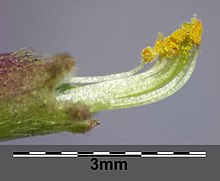
 Astragalus austriacus est considéré comme diadelphe car il a une étamine non attachée à l’ adelphie principale (bouquet).
Astragalus austriacus est considéré comme diadelphe car il a une étamine non attachée à l’ adelphie principale (bouquet). 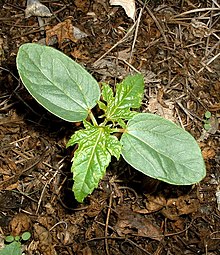
 Les cotylédons appariés d’un plant de graine de ricin ( Ricinus communis ) sont typiques d’un dicotylédone .
Les cotylédons appariés d’un plant de graine de ricin ( Ricinus communis ) sont typiques d’un dicotylédone . 




 Dissepment se développant dans les tissus des carpellesoù ils se rencontrent pour former des loculesdans la capsule de l’ovaire de Lilium
Dissepment se développant dans les tissus des carpellesoù ils se rencontrent pour former des loculesdans la capsule de l’ovaire de Lilium 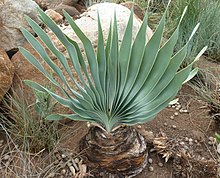
 Boophone disticha a des feuilles visiblement distiques .
Boophone disticha a des feuilles visiblement distiques . 
 Domatia à la base des épines d’ Acacia drepanolobium, l'”Epine sifflante”. Notez les trous d’accès.
Domatia à la base des épines d’ Acacia drepanolobium, l'”Epine sifflante”. Notez les trous d’accès. 
 Feuilles dorsiventrales (bilatérales) de Syzygium gerrardiiet Triadica sebifera
Feuilles dorsiventrales (bilatérales) de Syzygium gerrardiiet Triadica sebifera 
 Les feuilles d’ Epipremnum aureum ont un drip tip cuspidé . à feuilles caduques Déhiscence et chute saisonnières, comme avec l’écorce , les feuilles ou les pétales . Contraste persistant . décliner Courbé vers le bas, puis vers le haut à la pointe. Souvent qualifié, par exemple descendant-ascendant. décomposer Divisé à plus d’un niveau, par exemple dans les feuilles bipennées , dans lesquelles les folioles de ce qui serait autrement une feuille pennée sont elles-mêmes pennées. décortiquer 1. (intr. v.) Se débarrasser de l’écorce externe d’un arbre, généralement de façon saisonnière dans le cadre du cycle de croissance naturel. 2. (tr. v.) Dépouiller la peau, la croûte, l’écorce ou d’autres tissus de surface d’une plante ou de matériel récolté, comme dans l’extraction de fibres à partir de feuilles d’ agave récoltées. déchu Ayant des branches qui poussent horizontalement sur le sol mais qui sont retroussées aux extrémités. décurrent S’étendant vers le bas au-delà du point d’ insertion , par exemple lorsque la base d’une feuille ou d’une branchie fongique se prolonge vers le bas le long de la tige en une ligne surélevée ou une aile étroite. décussant Synonyme de décussé ; l’utilisation decusssant est discutable et se produit rarement, probablement comme une erreur. L’utilisation formellement correcte est décussée . déçusse Ci -contre avec des couples successifs portés perpendiculairement au dernier ; généralement appliqué à la disposition des feuilles . précis D’un nombre constant, par exemple deux fois plus d’ étamines que de pétales ou de sépales (ou moins), ou une inflorescence se terminant par une fleur ou un bouton floral avorté , typiquement une inflorescence cymeuse . Contraste indéfini . déformé Plié vers le bas. Contraste inflexible . déhiscent Ouverture à maturité pour libérer le contenu ; désigne par exemple l’ouverture des fruits pour libérer les graines , des anthères pour libérer le pollen et des sporanges pour libérer les spores . Contraste indéhiscent . deltoïde En forme de lettre grecque majuscule Δ , c’est-à-dire d’un triangle plus ou moins équilatéral. dendroïde semblable à un arbre ; ramifié comme un arbre. denté Denté , surtout en référence aux bords des feuilles . denticulé Finement denté ; une forme diminutive de denté . désertique Habiter un désert. déterminé Limité, généralement en croissance. Contraste indéterminé . diadelphe Se référant à une classe de structure adelphe dans laquelle les étamines ou organes similaires sont reliés en deux adelphes au lieu d’un seul. diaspore Toute partie reproductrice d’une plante adaptée à la dispersion et à l’établissement de nouvelles plantes ; peut être une dissémination telle qu’une graine ou d’autres parties telles que des bourgeons spécialisés , des branches, des inflorescences ou des fruits. dichasium Une inflorescence cymeuse avec toutes les branches sous la fleur terminale en paires opposées régulières . Comparez monochasium et pleiochasium . dichlamyde Ayant un périanthe divisé en un calice et une corolle séparés . Comparez les homochlamydes . dichotomique Fourche en deux branches égales. Cela peut résulter d’une division égale de la pointe en croissance, ou peut être sympodial , dans lequel la pointe en croissance est avortée et remplacée. Se réfère généralement au mode de croissance des branches, comme dans Aloidendron dichotomum , mais aussi à d’autres organes, tels que les motifs de nervation sur les feuilles, les épines de diverses espèces de Carissa (qui morphologiquement sont des branches), et les thalles ou hyphes de diverses algues et champignons. dicotylédone
Les feuilles d’ Epipremnum aureum ont un drip tip cuspidé . à feuilles caduques Déhiscence et chute saisonnières, comme avec l’écorce , les feuilles ou les pétales . Contraste persistant . décliner Courbé vers le bas, puis vers le haut à la pointe. Souvent qualifié, par exemple descendant-ascendant. décomposer Divisé à plus d’un niveau, par exemple dans les feuilles bipennées , dans lesquelles les folioles de ce qui serait autrement une feuille pennée sont elles-mêmes pennées. décortiquer 1. (intr. v.) Se débarrasser de l’écorce externe d’un arbre, généralement de façon saisonnière dans le cadre du cycle de croissance naturel. 2. (tr. v.) Dépouiller la peau, la croûte, l’écorce ou d’autres tissus de surface d’une plante ou de matériel récolté, comme dans l’extraction de fibres à partir de feuilles d’ agave récoltées. déchu Ayant des branches qui poussent horizontalement sur le sol mais qui sont retroussées aux extrémités. décurrent S’étendant vers le bas au-delà du point d’ insertion , par exemple lorsque la base d’une feuille ou d’une branchie fongique se prolonge vers le bas le long de la tige en une ligne surélevée ou une aile étroite. décussant Synonyme de décussé ; l’utilisation decusssant est discutable et se produit rarement, probablement comme une erreur. L’utilisation formellement correcte est décussée . déçusse Ci -contre avec des couples successifs portés perpendiculairement au dernier ; généralement appliqué à la disposition des feuilles . précis D’un nombre constant, par exemple deux fois plus d’ étamines que de pétales ou de sépales (ou moins), ou une inflorescence se terminant par une fleur ou un bouton floral avorté , typiquement une inflorescence cymeuse . Contraste indéfini . déformé Plié vers le bas. Contraste inflexible . déhiscent Ouverture à maturité pour libérer le contenu ; désigne par exemple l’ouverture des fruits pour libérer les graines , des anthères pour libérer le pollen et des sporanges pour libérer les spores . Contraste indéhiscent . deltoïde En forme de lettre grecque majuscule Δ , c’est-à-dire d’un triangle plus ou moins équilatéral. dendroïde semblable à un arbre ; ramifié comme un arbre. denté Denté , surtout en référence aux bords des feuilles . denticulé Finement denté ; une forme diminutive de denté . désertique Habiter un désert. déterminé Limité, généralement en croissance. Contraste indéterminé . diadelphe Se référant à une classe de structure adelphe dans laquelle les étamines ou organes similaires sont reliés en deux adelphes au lieu d’un seul. diaspore Toute partie reproductrice d’une plante adaptée à la dispersion et à l’établissement de nouvelles plantes ; peut être une dissémination telle qu’une graine ou d’autres parties telles que des bourgeons spécialisés , des branches, des inflorescences ou des fruits. dichasium Une inflorescence cymeuse avec toutes les branches sous la fleur terminale en paires opposées régulières . Comparez monochasium et pleiochasium . dichlamyde Ayant un périanthe divisé en un calice et une corolle séparés . Comparez les homochlamydes . dichotomique Fourche en deux branches égales. Cela peut résulter d’une division égale de la pointe en croissance, ou peut être sympodial , dans lequel la pointe en croissance est avortée et remplacée. Se réfère généralement au mode de croissance des branches, comme dans Aloidendron dichotomum , mais aussi à d’autres organes, tels que les motifs de nervation sur les feuilles, les épines de diverses espèces de Carissa (qui morphologiquement sont des branches), et les thalles ou hyphes de diverses algues et champignons. dicotylédone
Aussi abrégé dicot .
Une plante à fleurs dont l’embryon a deux ou plusieurs cotylédons (feuilles de graines). Monocotylédon de contraste . numériser Avec des segments s’étendant à partir d’un centre commun, comme les doigts d’une main. Voir aussi palmé et palmatisé . digitiforme en forme de doigt. dimorphique Apparaissant sous deux formes différentes (en ce qui concerne la forme et/ou la taille), par exemple des étamines , des frondes ou des feuilles. Voir aussi monomorphe (ayant une seule forme) et polymorphe (ayant plusieurs formes). dioïque (de plantes vasculaires) Ayant des structures reproductrices mâles et femelles qui ne se développent que sur des individus différents et jamais sur le même individu. Contraste monoïque . dioïque (d’un gamétophyte bryophyte ) Possède des structures reproductrices mâles et femelles qui ne se développent que sur des individus différents et jamais sur le même individu. Contraste monoïque . diploïde Avoir deux ensembles complets de chromosomes dans le noyau d’une cellule sporophyte , c’est-à-dire un ensemble de chacun des gamètes parentaux . Ceci est souvent exprimé symboliquement par 2n , où n = le nombre de chromosomes dans le gamète haploïde . diplostémoneux Ayant des étamines disposées en deux verticilles , le verticille extérieur alternant avec les pétales tandis que le verticille intérieur est opposé aux pétales. Comparez obdiplostémone et haplostémone . disque
Aussi orthographié disk .
Une plaque ou un anneau de structures dérivées du réceptacle et apparaissant entre les verticilles des parties florales. Chez certains groupes, notamment les Sapindales , le nectaire se présente sous la forme d’un disque proéminent. Chez les marguerites , la partie centrale du capitule est un disque, d’où les fleurs qui y sont portées sont appelées fleurs de disque ou fleurons . discoïde Ressemblant à un disque ou à une plaque, ayant à la fois une épaisseur et des faces parallèles et avec une marge arrondie. Également utilisé pour décrire le capitule des Astéracées où il n’y a pas de fleurons ligulés mais seulement des fleurons en forme de disque. décoloré (des feuilles ) Ayant des faces supérieures et inférieures de couleurs différentes. disjoint Se produisant dans des zones géographiques largement séparées, nettement séparées ; s’applique à une aire de répartition discontinue dans laquelle une ou plusieurs populations sont séparées d’autres populations susceptibles de se reproduire avec une distance suffisante pour empêcher le flux de gènes entre elles. fleuron du disque Un fleuron apparaissant le plus souvent dans le disque du capitule des fleurs de la famille des Astéracées et, dans une certaine mesure, chez d’autres plantes qui portent un capitule fleuri avec un disque, comme Scabiosa . disséqué Profondément divisé; coupé en plusieurs segments. opposition Une cloison ou un septum dans une partie de la plante, se référant généralement aux cloisons entre les loges des capsules ou d’autres fruits avec plusieurs cloisons. distale Éloigné du point d’origine ou de rattachement ; l’extrémité libre. Contraste proximal . distique Disposés en deux rangées opposées (et donc dans le même plan). distinct Séparé ou libre ; pas uni. d’une manière distyly État dans lequel les fleurs d’une espèce se présentent sous deux formes qui ne diffèrent que par la longueur du style et des étamines , et les fleurs d’une seule de ces formes apparaissent sur une même plante. Comparez l’hétérostylie . diurne Du jour; survenant ou s’ouvrant dans la journée. diverger Large diffusion. divergent Propagation dans différentes directions, généralement vers le haut. division Un rang taxonomique inférieur au royaume dans la hiérarchie taxonomique standard. “Division” est généralement utilisé uniquement pour les plantes et est l’équivalent botanique approximatif du terme phylum , qui est utilisé pour les animaux et d’autres règnes. domatie
chanter. domaine
Toute structure creuse formée par une plante qui est habitée par des animaux tels que des fourmis ou des acariens. dorsal Du latin dorsum , une crête ou le dos d’un animal. En partie parce que le terme désignait à l’origine des animaux plutôt que des plantes, l’utilisation en botanique est arbitraire selon le contexte et la source. En général, “dorsale” fait référence à “l’arrière ou le dos ou la surface supérieure”, mais dans l’ usage botanique , ces concepts ne sont pas toujours clairement définis et peuvent être contradictoires. Par example:
- tourné à l’opposé de l’axe ( abaxial ) dans un organe latéral d’une plante dressée
- face à l’opposé du substrat dans toute partie d’une plante dressée, par exemple la face supérieure d’une feuille plus ou moins horizontale ( adaxiale ) ou la partie supérieure de la couronne de la plante
- face à l’opposé du substrat dans une plante prostrée ou grimpante ou des feuilles flottantes telles que celles de Nymphaea .
Les termes dérivés ou apparentés incluent dorsad , “vers la dorsale” et dorsum , “la partie dorsale de l’organe ou de l’organisme en tant qu’unité”. Les termes anatomiques liés à l’emplacement incluent ventral , latéral . dorsifixé Attachés à ou par le dos, p.ex. anthères sur un filament . dorsiventrale Ayant des surfaces supérieures et inférieures structurellement et visiblement différentes, par exemple certaines feuilles. Comparer bilatéral et isobilatéral . pointe glissante Extension longue, étroite, acuminée , caudée ou cuspidée à l’extrémité d’une feuille ou d’un foliole . Généralement une adaptation aux conditions pluvieuses, car elle favorise l’évacuation de l’eau par son égouttement de la pointe étroite. Le terme “drip tip” n’est pas anatomiquement descriptif de la manière dont, par exemple, acuminé ou cuspidé, le sont ; il s’agit plutôt d’une description de la forme fonctionnelle qui facilite l’égouttement, quelle que soit la géométrie spécifique de la forme elle-même. drupe Un type de fruit succulent formé d’un carpelle ; la graine unique est entourée d’une couche pierreuse de la paroi du fruit, par exemple dans les pêches et les olives. Aussi appelé noyau . drupelette Petite drupe formée à partir de l’un des carpelles d’une fleur apocarpe . Les drupelettes forment généralement un fruit composé , comme chez Rubus , mais elles peuvent devenir largement séparées, comme chez Ochna . druze Une masse globulaire de cristaux d’ oxalate de calcium , généralement avec les cristaux rayonnant à partir d’un noyau organique .
E

 Les plantes du genre Corydalis portent des graines avec des élaiosomes attachés , qui ont diverses fonctions, attirant généralement les fourmis. Sur certaines espèces de Corydalis , les élaiosomes qui attirent les fourmis repoussent également les souris. [11]
Les plantes du genre Corydalis portent des graines avec des élaiosomes attachés , qui ont diverses fonctions, attirant généralement les fourmis. Sur certaines espèces de Corydalis , les élaiosomes qui attirent les fourmis repoussent également les souris. [11] 

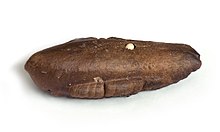
 L’ embryon pâle émergeant de la surface supérieure de la graine de datte en germination est minuscule par rapport à l’ endosperme , sa principale source de nourriture, qui comprend presque tout le reste de la graine.
L’ embryon pâle émergeant de la surface supérieure de la graine de datte en germination est minuscule par rapport à l’ endosperme , sa principale source de nourriture, qui comprend presque tout le reste de la graine. 
 Les nénuphars et les roseaux représentent deux catégories écologiques de végétation aquatique émergente .
Les nénuphars et les roseaux représentent deux catégories écologiques de végétation aquatique émergente . 


 Le calice élargi et l’épicalice plus petit d’ Hibiscus sabdariffa
Le calice élargi et l’épicalice plus petit d’ Hibiscus sabdariffa 
 Pousses de bourgeons épicormiques sur Eucalyptus suite à un feu de brousse
Pousses de bourgeons épicormiques sur Eucalyptus suite à un feu de brousse 
 Un lichen épilithique
Un lichen épilithique 
 Tillandsia recurvata poussant comme un épiphyte épiphloedal inoffensif et non parasite sur un tronc d’arbre qui est également infesté d’un lichen foliacé épiphloedal
Tillandsia recurvata poussant comme un épiphyte épiphloedal inoffensif et non parasite sur un tronc d’arbre qui est également infesté d’un lichen foliacé épiphloedal 
 Les graines ou les fruits sont dispersés par épizoochorie lorsqu’ils se collent à la fourrure des animaux.
Les graines ou les fruits sont dispersés par épizoochorie lorsqu’ils se collent à la fourrure des animaux. 
 Les bases des feuilles équitantes renferment les feuilles ultérieures sur la tige.
Les bases des feuilles équitantes renferment les feuilles ultérieures sur la tige. 
 Sections de graines exalbuminées
Sections de graines exalbuminées 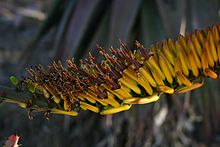
 Fleurs d’ Aloe marlothii avec étamines et stigmates de fleurs matures sortant de l’embouchure des tubes floraux -eae Un suffixe ajouté à la racine d’un nom générique pour former le nom d’une tribu , par exemple Aster → Astereae . ébractée Manque de bractées ; synonyme d’ ébractéolate . amplitude écologique Gamme de conditions environnementales dans lesquelles un organisme peut survivre. édaphique Of or influenced by the soil. elaiosome An external structure attached to the seed of many species of plants. Elaiosomes generally look fleshy and in some species they are rich in oils or other nutritious materials. Their functions vary and are not always obvious; commonly they attract ants or other animals that aid in dispersal, but they may also repel other animals from eating the seed. [11] elephophily A form of pollination whereby pollen or spores are distributed by the feet of elephants, as in Rafflesia arnoldii. ellipsoid A three-dimensional shape that is elliptical in all sections through the long axis. elliptical
Fleurs d’ Aloe marlothii avec étamines et stigmates de fleurs matures sortant de l’embouchure des tubes floraux -eae Un suffixe ajouté à la racine d’un nom générique pour former le nom d’une tribu , par exemple Aster → Astereae . ébractée Manque de bractées ; synonyme d’ ébractéolate . amplitude écologique Gamme de conditions environnementales dans lesquelles un organisme peut survivre. édaphique Of or influenced by the soil. elaiosome An external structure attached to the seed of many species of plants. Elaiosomes generally look fleshy and in some species they are rich in oils or other nutritious materials. Their functions vary and are not always obvious; commonly they attract ants or other animals that aid in dispersal, but they may also repel other animals from eating the seed. [11] elephophily A form of pollination whereby pollen or spores are distributed by the feet of elephants, as in Rafflesia arnoldii. ellipsoid A three-dimensional shape that is elliptical in all sections through the long axis. elliptical
Also elliptic.
Planar, shaped like a flattened circle, symmetrical about both the long and the short axis, tapering equally both to the tip and the base; oval. emarginate Notched at the apex (notch usually broad and shallow). embryo The young plant contained by a seed prior to germination. emergent A plant taller than the surrounding vegetation or, among aquatic plant species, one that bears flowers and commonly leaves above the surface of the water. Aquatic examples include water lilies, reeds, and papyrus. Some pondweeds such as Stuckenia are not emergent until they flower, at which time only their flowers appear above the water surface. enantiostyly The condition in which the gynoecium protrudes laterally, to the right ( dextrostyly) or to the left ( sinistrostyly) of the Androecium, e.g. Senna. endemic Having a natural distribution restricted to a particular geographic region. Compare native. endocarp The innermost layer of the wall of a fruit; in a drupe, the stony layer surrounding the seed. endodermis The innermost layer of the cortex of vascular plant roots, also present in the stems of pteridophytes. The radial walls are impregnated with suberin to form a permeability barrier known as the Casparian strip. endophloeodal See endophloic. endophloic
Also endophloeodal.
(of crustose lichens) Having the thallus growing within rather than upon the bark of trees. [12]: 159 Compare epiphloedal and corticolous (growing on the surface of wood or bark) and endolithic (growing within rock). endosperm 1. ( angiosperms) A nutritive tissue surrounding the embryo of the seed, usually triploid, originating from the fusion of both polar nuclei with one gamete after the fertilization of the egg. 2. ( gymnosperms) The prothallus within the embryo sac. endospory The production of spores that germinate into a reduced multicellular gametophyte contained within the spore wall. Contrast exospory. ensiform Shaped like the blade of a sword. entire 1. Not divided. 2. (of a margin) Smooth and not lobed or toothed (though possibly wavy or scalloped). entomophily A form of pollination whereby pollen or spores are distributed by insects. epecophyte Species of recent appearance, usually numerous and constant in the country, but confined to artificial habitats, such as meadows and ruderal vegetation and are dependent on humans for existence. [13] ephemeral Short-lived. See also caducous. epicalyx An involucre resembling an outer calyx, e.g. as in Hibiscus. epicarp The outer layer of the wall of a fruit, i.e. the “skin”. epicormic Used to refer to buds, shoots, or flowers developing from the old wood of trees, especially after injury or fire. epicotyl The part of the plant axis or stem between the cotyledonary node and the first foliage leaves. epicuticular wax A layer of crystalline or amorphous wax deposited on the surface of the cuticle. epidermis An organ’s outermost layer of cells, usually only one cell thick. epigynous Borne on the ovary; describes floral parts when attached above the level of the ovary and arising from tissue fused to the ovary wall. Compare hypogynous and perigynous. epilithic Growing on stone. Compare lithophytic, a plant growing on stone. epinecral Dead ( necral) tissue above the surface of the cortex of a lichen. epipetalous Of stamens that are attached to the petals. epipetric Growing on rock or stone, lithophytic, epilithic. epiphloedal Growing on the surface of bark. Contrast endophloedal (growing inside, not on, the bark) and epilithic (growing on rock, not bark). epiphyte A plant, alga or fungus that grows on another plant without deriving nourishment from it but using it for support. epiphytic Of an epiphyte; living on the surface of a plant. Compare epilithic, lithophytic. episepalous Of stamens that are attached to the sepals. epitepalous Of stamens that are attached to the tepals. epithet The adjectival component in a binomial scientific name, usually more specifically called a specific epithet; the final word or combination of words in a name of more than one word (other than a term denoting rank) that denominates an individual taxon. The simplest and commonest example is the second word in a two-word name of a species, such as ” mirabilis” in Welwitschia mirabilis. epizoochory A type of seed dispersal that occurs when seeds or fruits physically adhere to the outside of vertebrate animal bodies. epruinose Not pruinose. equitant (of a leaf) Folded lengthwise and clasping another leaf. erect Upright, more or less perpendicular to the ground or point of attachment. Compare patent (spreading) and erecto-patent, between erect and patent. ericoid Having leaves like those of the European heaths ( Erica); small and sharply pointed. erose (of a margin) Irregular as though nibbled or worn away. ethelochoric Deliberate introduction by seedlings, seeds or plants in a new habitat by humans. even-pinnate Having an even number of leaflets in a compound leaf; synonymous with paripinnate. evergreen Not deciduous; having leaves all year. ex In nomenclature, indicating that the preceding author proposed the name but did not legitimately publish it, and that the succeeding author referred to the first author when legitimately publishing the name. See Author citation (botany). exalbuminous In seeds of a given species, having no endosperm, i.e. no Albumen, e.g. in Fabaceae and Combretaceae. exocarp The outer layer of the pericarp, often the skin of fleshy fruits. exospory The production of spores that germinate into free-living multicellular gametophytes. Contrast endospory. exotesta The outer layer of the testa (seed coat). It is derived from the outer integument of the ovule. exotic Not native; introduced from another region or country. exserted Projected beyond, e.g. stamens beyond the corolla tube. exstipulate Lacking stipules. extrastaminal Outside the stamens or Androecium, usually referring to the location of a nectary disk. extrorse (of anther locules) Opening toward the outside of the flower. Contrast introrse and latrorse.
F

 Astragalus falcatus has conspicuously falcate pods; not many falcate anatomical structures are so markedly curved.
Astragalus falcatus has conspicuously falcate pods; not many falcate anatomical structures are so markedly curved. 
 Rhigozum obovatum bears its leaves in well-defined fascicles.
Rhigozum obovatum bears its leaves in well-defined fascicles. 
 Favolaschia calocera, the orange pore fungus, has conspicuously faveolate fruiting bodies.
Favolaschia calocera, the orange pore fungus, has conspicuously faveolate fruiting bodies. 


 Fenestrate leaves of Darlingtonia californica
Fenestrate leaves of Darlingtonia californica 
 Digitalis ferruginea owes its specific name to its ferruginous (rust-coloured) flowers.
Digitalis ferruginea owes its specific name to its ferruginous (rust-coloured) flowers.  Calochortus fimbriatus has fimbriate flowers.
Calochortus fimbriatus has fimbriate flowers.  Panaeolus cinctulus has gently flexuous stipes.
Panaeolus cinctulus has gently flexuous stipes.  The pseudanthium of Zinnia elegans is typical of many Asteraceae in that it includes two types of florets, ray florets and disk florets.
The pseudanthium of Zinnia elegans is typical of many Asteraceae in that it includes two types of florets, ray florets and disk florets. 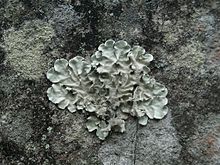 The foliose thallus of the lichen Parmotrema tinctorum is leafy.
The foliose thallus of the lichen Parmotrema tinctorum is leafy.  Medicago sativa ( alfalfa or lucerne) is an agriculturally important forb, grown in large volumes for forage, soil improvement, and other purposes.
Medicago sativa ( alfalfa or lucerne) is an agriculturally important forb, grown in large volumes for forage, soil improvement, and other purposes.  Foveolate seeds of Physochlaina physaloides
Foveolate seeds of Physochlaina physaloides  Letharia vulpina is a fruticose lichen. F1 hybrid A single cross; a plant breeding term for the result of a repeatable cross between two pure bred lines. F2 hybrid A plant breeding term for the result of a plant arising from a cross between two F1 hybrids; may also refer to self-pollination in a population of F1 hybrids. fabiform Shaped like a kidney bean. facultative Of parasites, optional. Compare obligate. falcate Curved like the blade of a scythe. family A taxonomic group of one or more genera with features and/or ancestry in common; the term for the principal rank between order and genus. farina powdery, pale yellow crystalline secretion consisting of flavonoids in Primula and other species farinaceous Powderiness that is mealy fascicle
Letharia vulpina is a fruticose lichen. F1 hybrid A single cross; a plant breeding term for the result of a repeatable cross between two pure bred lines. F2 hybrid A plant breeding term for the result of a plant arising from a cross between two F1 hybrids; may also refer to self-pollination in a population of F1 hybrids. fabiform Shaped like a kidney bean. facultative Of parasites, optional. Compare obligate. falcate Curved like the blade of a scythe. family A taxonomic group of one or more genera with features and/or ancestry in common; the term for the principal rank between order and genus. farina powdery, pale yellow crystalline secretion consisting of flavonoids in Primula and other species farinaceous Powderiness that is mealy fascicle
adj. fasciculate
A cluster, e.g. a tuft of leaves all arising from the same node. fasciculate Branching in clusters like a bundle of sticks or needles; having fascicles. faveolate Honeycombed; having regular, angled pits. Compare foveolate. faucal Pertaining to the fauces; located in the throat of a calyx or corolla. fauces The throat of a calyx or corolla; the conspicuously widened portion between the mouth and the apex of the tube. In Boraginaceae, the site of distinctive appendages. felted Covered with very dense, interlocked and matted hairs with the appearance or texture of felt or woollen cloth. female flower See pistillate flower. fenestrate Having translucent areas. See also perforate, with holes. ferruginous Ruddy or rust-colored. fertile Capable of producing fruit; of flowers when they produce seed or of anthers containing pollen. fertilization The union of male and female gametes during sexual reproduction. fiber 1. A fiber cell. 2. Any flexible, strong, stringy, and very elongate structure. fiber cell a type of cell that is found in sclerenchyma, it is much elongated and dies soon after an extensive modification of its cell wall. The cell wall is usually thickly lignified, but is sometimes gelatinous. filament 1. The stalk of a stamen. 2. Any very narrow, thread-like structure that is one or a few cells thick. filamentous consisting of filaments or fibres, hairlike. filiform. thread-like. e.g. stamen filaments, or leaf shapes. fimbria slender hair-like process (plural: fimbriae) fimbriate. Fringed. fissure A split or crack, often referring to fissured bark; a line or opening of dehiscence. fistule A tube-shaped cavity. fistulose Hollow; usually applied to a tube-shaped cavity, as in a reed. flabellate Fan-shaped. flaccid Limp; tending to wilt. Compare turgid. flexistyly Depending on the degree of maturation of the stamens, the style moves up or down (cataflexistyle or (ana-)hyperflexisyle). flexuous flexuose Bent alternately in different directions; zig-zag. floccose Having a soft and woolly covering of hairs. flora 1. all the plants growing in a certain region or country. 2. an enumeration of them, generally with a guide to their identification (e.g. the present volume, the Flora of Victoria, the Flora of New South Wales and so on). In this case ‘flora’ is written with a capital F. floral envelope See perianth. floral leaves The upper leaves at the base of the flowering branches. floral diagram A graphical means to describe flower structure, usually a schematic cross-section through a young flower. floral formula A description of flower structure using numbers, letters and various symbols. floral tube An imprecise term sometimes used as a synonym of hypanthium or of corolla tube or of calyx tube. floret A small flower, usually referring to the individual true flowers clustered within an inflorescence, particularly those of the grasses and the pseudanthia of daisies. flower The sexual reproductive structure of the angiosperms, typically with a gynoecium, Androecium, perianth and an axis. foliate Preceded by a number: having a certain number of leaflets; for example, 3-foliate, “having three leaflets” foliicolous A growth habit of certain lichens, algae, and fungi that prefer to grow on the leaves of vascular plants. follicle A dry fruit formed from one carpel, splitting along a single suture, to which the seeds are attached. Compare pod (of legume). foliole A small leaf-like appendage on the front or back. foliose Leaf-like; flattened like a leaf. forb Any non-woody flowering plant that is not a grass, sedge, or rush. forest Vegetation dominated by trees with single trunks (including closely arranged trees with or without an understory of shrubs and herbs). forma (in common usage, form) A taxonomic category subordinate to species and within the taxonomic hierarchy, below variety (varietas), and usually differentiated by a minor character. foveolate Having regular tiny pits. Compare faveolate. free Not united with other organs of the same type; not attached at one end. free central Of placentation, ovules attached to a free-standing column in the centre of a unilocular ovary. frond A leaf of a fern, cycad, or palm. frutescent Shrub-like ( fruticose) or becoming shrub-like. fruticose Shrubby; having the branching character of a shrub. fruit A seed-bearing structure present in all angiosperms, formed from the mature ovary and sometimes associated floral parts upon fertilization. fugacious Disappearing, falling off, or withering. Compare persistent and caducous. funicle (funiculus) The stalk of an ovule. funnelform Having a form gradually widening from the base to apex; funnel-shaped. furcate Forked, usually applied to a terminal division; with two long lobes. fused Joined together. fusiform Rod-shaped and narrowing gradually from the middle toward each end; spindle-shaped.
G

 Gametophores (red male antheridia and brown female archegonia) borne on a gametophyte of a Chara species of green algae
Gametophores (red male antheridia and brown female archegonia) borne on a gametophyte of a Chara species of green algae  Longitudinal section of immature male pine cone, showing male gametophytes (pollen grains) developing between the cone scales
Longitudinal section of immature male pine cone, showing male gametophytes (pollen grains) developing between the cone scales  Glandular hairs on the stem of Geranium dissectum
Glandular hairs on the stem of Geranium dissectum  The leaves, buds, and young stalks of Eucalyptus macrocarpa are glaucous, covered with a thick waxy pruinosity.
The leaves, buds, and young stalks of Eucalyptus macrocarpa are glaucous, covered with a thick waxy pruinosity.  Glochids at the base of an Opuntia cactus spine
Glochids at the base of an Opuntia cactus spine  Glumes of a grass species with a fairly large inflorescence
Glumes of a grass species with a fairly large inflorescence 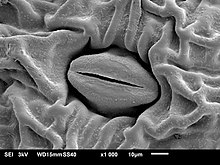 Scanning electron micrograph of a stoma on the leaf of Haemanthus. The two lip-shaped cells on either side of the pore are the guard cells.
Scanning electron micrograph of a stoma on the leaf of Haemanthus. The two lip-shaped cells on either side of the pore are the guard cells. 
 Examples of gymnosperms
Examples of gymnosperms
LEFT
1- Welwitschia mirabilis
2- Cycas revoluta
3- Taxus baccata
4- Ginkgo biloba
RIGHT
1- Cupressus sempervirens
2- Sequoiadendron giganteum
3- Agathis dammara
4- Araucaria heterophylla }} galbulus In gymnosperms, a fleshy cone ( megastrobilus); chiefly relates to cones borne by junipers and cypresses, which are often mistakenly called berries. galea An overhanging, helmet-shaped, structure that protects the reproductive parts from precipitation, wind or unwanted visitors. gall Abnormal outgrowth on external plant tissues, caused by various parasites, from viruses, fungi and bacteria, to other plants, insects and mites. gamete A cell or nucleus that fuses with another of the opposite sex during sexual reproduction. gametophore Specialized structures on the gametophytes of some bryophyte species, for example many species in the order Marchantiales; in such species the gametes are produced on the gametophores, which amount to sex organs. gametophyte The haploid multicellular phase in the alternation of generations of plants and algae that bears gametes. In bryophytes the gametophyte is the dominant vegetative phase; in ferns and their allies it is a small free-living plant known as the prothallus; in gymnosperms and angiosperms the gametophytes are reduced to microscopic structures dependent on the sporophyte, male gametophytes contained in pollen grains and females contained within the ovules. gamopetalous with joined or fused petals gamophyllous a single perianth-whorl of united segments. Compare symphyllous ( synonym), apophyllous, polyphyllous gemma an asexual reproductive structure found in liverworts and mosses. gene pool The complete range of genetic variation found within a population. genus
pl. genera
A group of one or more species with features or ancestry (or both) in common. Genus is the principal category of taxa intermediate in rank between family and species in the standard nomenclatural hierarchy. generic name The name of a taxonomic genus, such as Acacia and Eucalyptus. genotype The genetic make-up of an individual. geophilous Growing or rooting in the ground. germination 1. of seeds, describing the complex sequence of physiological and structural changes that occur from resting to growth stage. 2. of a pollen grain; production of a pollen tube when contacting a stigma receptive to it. 3. of a spore of fungi/bacterium; change of state – from resting to vegetative. gibbous (gibbose) (of part of an organ) Swollen, usually with a pouch-like enlargement at the base. glabrescent Becoming glabrous, almost glabrous; glabrate. glabrous 1. Lacking surface ornamentation such as hairs, scales or bristles; smooth. 2. In lichenology, having no indumentum. gland A secretory structure within or on the surface of a plant. glandular hair A hair tipped with a gland. glaucous Describes the external surface of a plant part that has a whitish covering, in some cases with a blueish cast. Often applied to plants with a woolly or arachnoid surface, but properly referring to pruinose surfaces, meaning those with a waxy bloom. The surface of the young leaves of many eucalypts provide good examples, and so do some xerophytes. globose
Also globular.
Roughly spherical. See also subglobose. globulose Approximately spherical. glochid A tiny barbed hair or bristle, e.g. the fine defensive hairs in cactus species such as Opuntia. glumes bracts subtending the floret(s) of a sedge, or similar plant; in grasses forming the lowermost organs of a spikelet (there are usually 2 but 1 is sometimes reduced; or rarely, both are absent). glutinous Sticky. graft 1. The artificial union of plant parts. 2. A plant shoot suitable for grafting; loosely, a scion, sucker, or branch. graft chimaera (sometimes graft hybrid) A taxon whose members consist of tissue from two or more different plants in intimate association originated by grafting. The addition sign “+” is used to indicate a graft-chimaera either as a part of a formula (e.g. Crataegus monogyna + Mespilus germanica) or in front of an abbreviated name (e.g. +Crataegomespilus ‘Dardari’). The nomenclature of graft hybrids is governed by the International Code of Nomenclature for Cultivated Plants. graminoid granular (of a surface) Covered with small rounded protuberances. grass A plant of the family Poaceae. grassland Low vegetation dominated by grasses. groundcover 1. Dense vegetation that covers the ground. 2. A term applied to describe a plant that covers the soil surface so densely that it smothers all beneath it. group A formal category equivalent to or below the rank of genus which distinguishes:
- an assemblage of two or more cultivars within a species or hybrid;
- plants derived from a hybrid in which one or more of the parent species is not known or is of uncertain origin;
- a range of cultivated plants of a species or hybrid which may exhibit variation but share one or more characters, which makes it worth distinguishing them as a unit.
guard cell Each of two cells surrounding the stoma which control gas exchange between the apoplast of the plant and the external environment. guttate Having droplet-shaped spots. Compare punctate and maculate. guttation The secretion of liquid water from uninjured plant parts. See hydathode. guttulate Having or appearing to be spotted with oil droplets; of spores, having oil droplets inside. gymnosperm A seed-bearing plant with unenclosed ovules borne on the surface of a sporophyll. Gymnosperms are among the oldest clades of vascular plants, and today are represented by approximately 1,000 extant species worldwide, including, among others, conifers, Ginkgo, Gnetum and cycads. Compare Angiosperm. gynobasic Of a style, arising near the base of the gynoecium, e.g. between the lobes of the ovary. gynodioecious Of a species, with some plants bearing only bisexual flowers and others bearing only female flowers. gynomonoecious Of a species, with bisexual flowers and female flowers on the same plant. gynoecium The collective term for the female reproductive parts of a flower or for the carpels of a flower, whether united or free. Contrast Androecium. Abbreviation: G. For instance, G indicates a superior ovary; G(5) indicates having five fused carpels. gynophore A stalk supporting the gynoecium and situated above the level of insertion of the other floral parts. gynostegium A compound organ in milkweeds ( Asclepiadaceae) and orchids formed by fusion of the filaments of the stamens with the style. Also known as the column.
H
 Epidermal hairs on plant leaves
Epidermal hairs on plant leaves  Multicellular hairs on the edge of a sepal of Veronica sublobata
Multicellular hairs on the edge of a sepal of Veronica sublobata 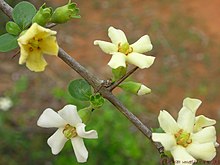 Haplostemonous arrangement of stamens and petals
Haplostemonous arrangement of stamens and petals  Markedly hastate leaf of Salvia canariensis
Markedly hastate leaf of Salvia canariensis  The swollen haustorium of Viscum capense renders the end of the branch stunted compared to the lower part of the branch.
The swollen haustorium of Viscum capense renders the end of the branch stunted compared to the lower part of the branch. 
 The hilum contrasts conspicuously with the rest of the testa in the seeds of many species. In the case of Erythrina species, the colours may be a warning that the seeds are poisonous.
The hilum contrasts conspicuously with the rest of the testa in the seeds of many species. In the case of Erythrina species, the colours may be a warning that the seeds are poisonous.  A hypocarpium forms below the fruits of Sassafras albidum.
A hypocarpium forms below the fruits of Sassafras albidum.  Flowers, fruit and propagule of a Rhizophora “mangle” or mangrove. The apparent root of the propagule is in fact meristematic tissue developing from the hypocotyl. The new plant develops largely from this tissue, especially if it has successfully penetrated into mud in which the new plant can establish itself. habit The general external appearance of a plant, including size, shape, texture, and orientation. habitat The place where a plant lives; the environmental conditions of its home. hafter A flat attachment that forms when the thallus of a fruticose or foliose lichens comes in contact with a substrate, different from rhizines and hapters. hair A single elongated cell or row of cells borne on the surface of an organ. half-inferior ovary An ovary partly below and partly above the level of attachment of the other floral parts. Compare inferior ovary, superior ovary. halonate Having a transparent coating, or being of a spore’s outer layer. halophyte A plant adapted to living in highly saline habitats; a plant that accumulates high concentrations of salt in its tissues. hand-pollination The controlled act of pollination that excludes the possibility of open-pollination. haploid Having one set of chromosomes, e.g. the complement of chromosomes in each of the cells of the gametophyte, the nucleus of a gamete and the spores. This is expressed symbolically as n, where n = the gametic number of chromosomes. Compare diploid, triploid, and tetraploid. haplostemonous Having a single series of stamens equal in number to the proper number of petals, and alternating with them. Compare diplostemonous, obdiplostemonous. hapter An attachment that may form when a foliose lichen thallus comes in contact with a substrate. harmomegathy process by which pollen grains in arid environments close off their apertures to avoid losing water hastate Triangular in outline, the basal lobes pointing outward, so that the base appears truncate; may refer only to the base of a leaf with such lobes. Compare sagittate which refers to basal lobes pointing backward. haustorium In parasitic plants, a structure developed for penetrating the host’s tissues. head See capitulum, a pseudanthium. heathland Vegetation dominated by small shrubs which usually have ericoid leaves. helicoid Coiled; of a cymose inflorescence, when the branching is repeatedly on the same side (the apex is often recurved). Compare scorpioid. hemerochory A plant that has been transported voluntarily or involuntarily by humans in a territory which it could not have colonized by its own natural mechanisms of dissemination, or at least much more slowly. [14] hemi-legume A legume fruit in which the seed or seeds and one valve of the pod are dispersed as a unit. The valve catches the wind and blows away with the seeds, as in Acacia tenuifolia and Peltogyne paniculata. herb Any vascular plant that does not develop a woody stem at any point during its life cycle, e.g. a daffodil. herbaceous Not woody; usually green and soft in texture. herbarium
Flowers, fruit and propagule of a Rhizophora “mangle” or mangrove. The apparent root of the propagule is in fact meristematic tissue developing from the hypocotyl. The new plant develops largely from this tissue, especially if it has successfully penetrated into mud in which the new plant can establish itself. habit The general external appearance of a plant, including size, shape, texture, and orientation. habitat The place where a plant lives; the environmental conditions of its home. hafter A flat attachment that forms when the thallus of a fruticose or foliose lichens comes in contact with a substrate, different from rhizines and hapters. hair A single elongated cell or row of cells borne on the surface of an organ. half-inferior ovary An ovary partly below and partly above the level of attachment of the other floral parts. Compare inferior ovary, superior ovary. halonate Having a transparent coating, or being of a spore’s outer layer. halophyte A plant adapted to living in highly saline habitats; a plant that accumulates high concentrations of salt in its tissues. hand-pollination The controlled act of pollination that excludes the possibility of open-pollination. haploid Having one set of chromosomes, e.g. the complement of chromosomes in each of the cells of the gametophyte, the nucleus of a gamete and the spores. This is expressed symbolically as n, where n = the gametic number of chromosomes. Compare diploid, triploid, and tetraploid. haplostemonous Having a single series of stamens equal in number to the proper number of petals, and alternating with them. Compare diplostemonous, obdiplostemonous. hapter An attachment that may form when a foliose lichen thallus comes in contact with a substrate. harmomegathy process by which pollen grains in arid environments close off their apertures to avoid losing water hastate Triangular in outline, the basal lobes pointing outward, so that the base appears truncate; may refer only to the base of a leaf with such lobes. Compare sagittate which refers to basal lobes pointing backward. haustorium In parasitic plants, a structure developed for penetrating the host’s tissues. head See capitulum, a pseudanthium. heathland Vegetation dominated by small shrubs which usually have ericoid leaves. helicoid Coiled; of a cymose inflorescence, when the branching is repeatedly on the same side (the apex is often recurved). Compare scorpioid. hemerochory A plant that has been transported voluntarily or involuntarily by humans in a territory which it could not have colonized by its own natural mechanisms of dissemination, or at least much more slowly. [14] hemi-legume A legume fruit in which the seed or seeds and one valve of the pod are dispersed as a unit. The valve catches the wind and blows away with the seeds, as in Acacia tenuifolia and Peltogyne paniculata. herb Any vascular plant that does not develop a woody stem at any point during its life cycle, e.g. a daffodil. herbaceous Not woody; usually green and soft in texture. herbarium
pl. herbaria
A collection of preserved, usually pressed and dried, plant material used for identification and comparison; also a building in which such collections are stored. hermaphrodite A synonym of bisexual. heteroblastic Having parts, especially leaves, that are distinctly different between the juvenile and adult stages. heteromorphic Having two or more distinct morphologies (e.g. of different size and shape). Compare isomorphic. heterospory The production of spores of two different sizes (small and large) by the sporophytes of land plants. Compare homospory. heterostyly The condition of a species having flowers with different style and stamen lengths, but with all the flowers of any one plant being identical. see: distyly. hilum The scar on a seed coat where it separates from its stalk ( funicle). hip The fruit of a rose plant. hippocrepiform Horseshoe-shaped. hirsute Bearing coarse, rough, longish hairs. See indumentum. hispid Bearing long, erect, rigid hairs or bristles, harsh to touch. hoary Covered with a greyish to whitish layer of very short, closely interwoven hairs, giving a frosted appearance. holotype A type chosen by the author of a name. Compare lectotype. homochlamydeous Having a perianth which is not divided into a separate calyx and corolla. Contrast dichlamydeous. homospory The production of spores of only one size by the sporophytes of land plants. Compare heterospory. hort.
(never capitalised) Of gardens, an author citation used in two ways:
1. as a name misapplied by gardeners 2. as an invalid name derived from horticultural writings of confused authorship. husk The protective outer covering of certain seeds, for example, the leafy outer covering of an ear of maize (corn), the leathery covering of the walnut or the spiky covering of the chestnut. hyaline Translucent; usually delicately membranous and colourless. hybrid A plant produced by the crossing of parents belonging to two different named groups, e.g. genera, species, varieties, subspecies, forma and so on; i.e. the progeny resulting within and between two different plants. An F1 hybrid is the primary product of such a cross. An F2 hybrid is a plant arising from a cross between two F1 hybrids (or from the self-pollination of an F1 hybrid). hybrid formula The names of the parents of a hybrid joined by a multiplication sign, e.g. Cytisus ardonoi × C. purgans. hydrophily A form of pollination whereby pollen is distributed by the flow of waters. hypanthium A tube or cup-like structure in a flower that includes the bases of sepals, petals, and stamens, and may or may not be connected ( adnate) to the ovary. hyper-resupinate In botany, describing leaves or flowers that are in the usual position, but are borne on a petiole or pedicel, respectively, that is twisted 360 degrees. The term is used to describe organs, such as orchid flowers, that are usually resupinate. Compare resupinate. hypocarpium An enlarged fleshy structure that forms below the fruit, from the receptacle or hypanthium. hypocotyl Of an embryo or seedling, the part of the plant axis below the cotyledon and node, but above the root. It marks the transition from root to stem development. hypocrateriform Salver shaped – synonym of salverform. From Greek kratḗrion – a vessel hypogynous Borne below the ovary; used to describe floral parts inserted below the ovary’s level of insertion. Compare epigynous, perigynous. hypothallus The hypothallus is the outgrowth of hyphae from under the margin of the thallus of a crustose lichens, connecting the island-like areoles into a single lichen. hysteranthous A type of growth in which new leaves appear after flowering. Also spelled histeranthous. Compare proteranthous and synanthous.
I
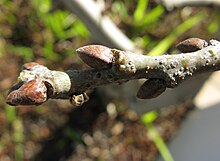 Imbricate protective cataphylls on dormant buds of Quercus robur
Imbricate protective cataphylls on dormant buds of Quercus robur  Petals of Mespilus germanica are imbricate before the flower opens.
Petals of Mespilus germanica are imbricate before the flower opens.  Doubly imparipinnate compound leaf of Melia azedarach
Doubly imparipinnate compound leaf of Melia azedarach  Deeply incised leaves of Pelargonium graveolens
Deeply incised leaves of Pelargonium graveolens  Indefinite stamens of Hypericum
Indefinite stamens of Hypericum  Indehiscent pods of Libidibia ferrea; unlike most Fabaceae species, the plant depends on the pods being crushed by large ungulates to disperse the seeds.
Indehiscent pods of Libidibia ferrea; unlike most Fabaceae species, the plant depends on the pods being crushed by large ungulates to disperse the seeds.  Aloe brevifolia bears an indeterminate raceme.
Aloe brevifolia bears an indeterminate raceme.  The leaves of Syagrus palms are ‘ induplicately] folded, in contrast to many other palm genera with reduplicate leaves.
The leaves of Syagrus palms are ‘ induplicately] folded, in contrast to many other palm genera with reduplicate leaves.  Stamens of Calotropis gigantea are inserted at the base of the corolla.
Stamens of Calotropis gigantea are inserted at the base of the corolla.  The intramarginal veins near the margins of this leaf are outlined in white.
The intramarginal veins near the margins of this leaf are outlined in white.  Two of these three green Asteraceae involucres encase unopened flower heads, and the third supports the open colourful head of emerging flowers. The imbricate phyllaries around the heads of this Malacothrix coulteri suggest the keeled scales of a snake, giving the plant its common name: “snake’s head”.
Two of these three green Asteraceae involucres encase unopened flower heads, and the third supports the open colourful head of emerging flowers. The imbricate phyllaries around the heads of this Malacothrix coulteri suggest the keeled scales of a snake, giving the plant its common name: “snake’s head”.  This Begonia leaf shows unusual iridescence for a plant. idioblast A cell, especially of a leaf, differing markedly from surrounding cells. They often synthesise specialised products such as crystals. illegitimate name (nomen illeg.) A name not abiding by the rules of the botanical Codes, e.g. later homonyms, cultivars that have been Latinised after 1 Jan 1959; cultivar names with more than 10 syllables or 30 letters; cultivar names that use confusing names of other plants, e.g. Camellia ‘Rose’. imbricate From the Latin for “tiled”. Overlapping each other; of perianth parts, edges overlapping in the bud (the convoluted arrangement is a special form of imbrication). Dormant buds of many deciduous species are imbricately covered with protective cataphylls called bud scales. Compare with subimbricates meaning lightly overlapping imparipinnate A pinnate leaf with an odd number of pinnae (terminated by a single leaflet). Compare paripinnate. in In nomenclature, where the preceding author published the name in an article or book, authored or edited by the succeeding author. -inae The suffix added to the stem of a generic name to form the name of a subtribe: for instance, Corydalinae from Corydalis + -inae. inbreeding The production of offspring between closely related parents leading to a high degree of similarity; self-fertilization is the most intense form of inbreeding. incertae sedis Of unknown taxonomic affinity; relationships obscure. incised Cut deeply and (usually) unevenly (a condition intermediate between toothed and lobed). included Enclosed, not protruding, e.g. stamens within the corolla. incomplete flower A flower which lacks one or more of its usual parts, such as carpels, sepals, petals, pistils, or stamens. incurved Bent or curved inward; of leaf margins, when curved toward the adaxial side. ined. An abbreviation of Latin inedita, an unpublished work. Used to indicate that a botanical name appeared only in a manuscript that was not published, so the name is invalid. indefinite variable in number, and as a rule numerous, e.g. more than twice as many stamens as petals or sepals, but no particular standard number of stamens. In another usage it is a synonym for the preferable term indeterminate, meaning the condition in which an inflorescence is not terminated by a flower, but continues growing until limited by physiological factors. Compare numerous. Contrast definite. indehiscent Not opening in any definite manner at maturity; usually referring to fruit. Contrast dehiscent. indeterminate usually referring to a stem or inflorescence in which there is no particular terminal bud or meristem that stops growth and ends the extension of the stem, which continues until physiological factors stop the growth. Racemes of some Xanthorrhoeaceae, such as many Aloes, and of many Iridaceae, such as Watsonias, are indeterminate. Contrast determinate. indigenous native to the area, not introduced, and not necessarily confined to the region discussed or present throughout it (hardly distinct from ‘native’ but usually applied to a smaller area). For example, the Cootamundra Wattle is native to Australia but indigenous to the Cootamundra region of southern New South Wales. Compare endemic. indumentum a collective term for a surface covering of any kind of trichomes, e.g. hairs, scales. induplicate folded upward, or folded with the two adaxial surfaces together. indusiumbiternateindusium 1. a membrane covering the sporangia of some ferns. 2. a cup enclosing the stigma in Goodeniaceae. inferior ovary An ovary at least partly below the level of attachment of other floral parts. Compare superior ovary, half-inferior ovary. inflated swollen, like a bladder. inflexed bent sharply upward or forward. Compare deflexed. inflorescence several flowers closely grouped together to form an efficient structured unit; the grouping or arrangement of flowers on a plant. infraspecific denotes taxonomic ranks below species level, for example subspecies. infrageneric denoting taxonomic ranks below the genus level, for example, subgenera, sections, and series. infructescence the grouping or arrangement of fruits on a plant. infundibular (infundibuliform) funnel-shaped, for example in the corolla of a flower. inrolled rolled inward. insectivorous catching, and drawing nutriment from, insects. insertion, point of The point at which one organ or structure (such as a leaf) is joined to the structure which bears it (such as a stem). inserted growing out from integument in general, any covering, but especially the covering of an ovule. intercalary (e.g. of growth) occurring between the apex and the base of an organ intercalary meristem a meristem located between the apex and the base of an organ interjugary glands in pinnate leaves, glands occurring along the leaf rachis between the pinnae (occurring below the single, and often slightly larger, gland at or just below the insertion of the pinnae). Compare jugary. internode The portion of a stem between two nodes. interpetiolar (of stipules) Between the petioles of opposite leaves, e.g in Rubiaceae. intramarginal inside but close to the margin, for example a vein in a leaf. intrastaminal inside the stamens or Androecium, usually referring to the location of a nectary disk. introrse of anther locules, with opening toward the centre of flower (at least in bud). Compare extrorse, latrorse. invalid Use of names not validly published according to the Code, i.e. they are not strictly ‘names’ in the sense of the International Code of Botanical Nomenclature. involucre A structure surrounding or supporting, usually a head of flowers. In Asteraceae, it is the group of phyllaries ( bracts) surrounding the inflorescence before opening, then supporting the cup-like receptacle on which the head of flowers sits. In Euphorbiaceae it is the cuplike structure that holds the nectar glands, nectar, and head of flowers, and sits above the bract-like cyathophyll structure. Involucres occur in Marchantiophyta, Cycads, fungi, and many other groups. involute Rolled inward, for example when the margins of a leaf are rolled toward the adaxial (usually upper) surface. Compare revolute. iridescent Having a reflective coloured sheen produced by structural coloration, as in the speculum of the mirror orchid Ophrys speculum. irregular Not able to be divided into two equal halves through any vertical plane. See also asymmetrical. Compare zygomorphic, Actinomorphic, and regular. isidium
This Begonia leaf shows unusual iridescence for a plant. idioblast A cell, especially of a leaf, differing markedly from surrounding cells. They often synthesise specialised products such as crystals. illegitimate name (nomen illeg.) A name not abiding by the rules of the botanical Codes, e.g. later homonyms, cultivars that have been Latinised after 1 Jan 1959; cultivar names with more than 10 syllables or 30 letters; cultivar names that use confusing names of other plants, e.g. Camellia ‘Rose’. imbricate From the Latin for “tiled”. Overlapping each other; of perianth parts, edges overlapping in the bud (the convoluted arrangement is a special form of imbrication). Dormant buds of many deciduous species are imbricately covered with protective cataphylls called bud scales. Compare with subimbricates meaning lightly overlapping imparipinnate A pinnate leaf with an odd number of pinnae (terminated by a single leaflet). Compare paripinnate. in In nomenclature, where the preceding author published the name in an article or book, authored or edited by the succeeding author. -inae The suffix added to the stem of a generic name to form the name of a subtribe: for instance, Corydalinae from Corydalis + -inae. inbreeding The production of offspring between closely related parents leading to a high degree of similarity; self-fertilization is the most intense form of inbreeding. incertae sedis Of unknown taxonomic affinity; relationships obscure. incised Cut deeply and (usually) unevenly (a condition intermediate between toothed and lobed). included Enclosed, not protruding, e.g. stamens within the corolla. incomplete flower A flower which lacks one or more of its usual parts, such as carpels, sepals, petals, pistils, or stamens. incurved Bent or curved inward; of leaf margins, when curved toward the adaxial side. ined. An abbreviation of Latin inedita, an unpublished work. Used to indicate that a botanical name appeared only in a manuscript that was not published, so the name is invalid. indefinite variable in number, and as a rule numerous, e.g. more than twice as many stamens as petals or sepals, but no particular standard number of stamens. In another usage it is a synonym for the preferable term indeterminate, meaning the condition in which an inflorescence is not terminated by a flower, but continues growing until limited by physiological factors. Compare numerous. Contrast definite. indehiscent Not opening in any definite manner at maturity; usually referring to fruit. Contrast dehiscent. indeterminate usually referring to a stem or inflorescence in which there is no particular terminal bud or meristem that stops growth and ends the extension of the stem, which continues until physiological factors stop the growth. Racemes of some Xanthorrhoeaceae, such as many Aloes, and of many Iridaceae, such as Watsonias, are indeterminate. Contrast determinate. indigenous native to the area, not introduced, and not necessarily confined to the region discussed or present throughout it (hardly distinct from ‘native’ but usually applied to a smaller area). For example, the Cootamundra Wattle is native to Australia but indigenous to the Cootamundra region of southern New South Wales. Compare endemic. indumentum a collective term for a surface covering of any kind of trichomes, e.g. hairs, scales. induplicate folded upward, or folded with the two adaxial surfaces together. indusiumbiternateindusium 1. a membrane covering the sporangia of some ferns. 2. a cup enclosing the stigma in Goodeniaceae. inferior ovary An ovary at least partly below the level of attachment of other floral parts. Compare superior ovary, half-inferior ovary. inflated swollen, like a bladder. inflexed bent sharply upward or forward. Compare deflexed. inflorescence several flowers closely grouped together to form an efficient structured unit; the grouping or arrangement of flowers on a plant. infraspecific denotes taxonomic ranks below species level, for example subspecies. infrageneric denoting taxonomic ranks below the genus level, for example, subgenera, sections, and series. infructescence the grouping or arrangement of fruits on a plant. infundibular (infundibuliform) funnel-shaped, for example in the corolla of a flower. inrolled rolled inward. insectivorous catching, and drawing nutriment from, insects. insertion, point of The point at which one organ or structure (such as a leaf) is joined to the structure which bears it (such as a stem). inserted growing out from integument in general, any covering, but especially the covering of an ovule. intercalary (e.g. of growth) occurring between the apex and the base of an organ intercalary meristem a meristem located between the apex and the base of an organ interjugary glands in pinnate leaves, glands occurring along the leaf rachis between the pinnae (occurring below the single, and often slightly larger, gland at or just below the insertion of the pinnae). Compare jugary. internode The portion of a stem between two nodes. interpetiolar (of stipules) Between the petioles of opposite leaves, e.g in Rubiaceae. intramarginal inside but close to the margin, for example a vein in a leaf. intrastaminal inside the stamens or Androecium, usually referring to the location of a nectary disk. introrse of anther locules, with opening toward the centre of flower (at least in bud). Compare extrorse, latrorse. invalid Use of names not validly published according to the Code, i.e. they are not strictly ‘names’ in the sense of the International Code of Botanical Nomenclature. involucre A structure surrounding or supporting, usually a head of flowers. In Asteraceae, it is the group of phyllaries ( bracts) surrounding the inflorescence before opening, then supporting the cup-like receptacle on which the head of flowers sits. In Euphorbiaceae it is the cuplike structure that holds the nectar glands, nectar, and head of flowers, and sits above the bract-like cyathophyll structure. Involucres occur in Marchantiophyta, Cycads, fungi, and many other groups. involute Rolled inward, for example when the margins of a leaf are rolled toward the adaxial (usually upper) surface. Compare revolute. iridescent Having a reflective coloured sheen produced by structural coloration, as in the speculum of the mirror orchid Ophrys speculum. irregular Not able to be divided into two equal halves through any vertical plane. See also asymmetrical. Compare zygomorphic, Actinomorphic, and regular. isidium
pl. isidia
A warty of club-like structure in some lichens that breaks off and forms new lichens without sexual reproduction. Isidia are dispersed by mechanical means, compared to soredia, which are dispersed by wind. isobifacial (of flat structures, especially leaves) Having both surfaces similar, usually referring to cell types or to the number and distribution of stomata. isomerous Having an equal number of parts in the whorls. isomorphic with all features morphologically similar, i.e. of similar size and shape. Compare heteromorphic. isotomic Having branches of equal diameter. Compare anisotomic.
J
 Acacia karroo bipinnate leaf
Acacia karroo bipinnate leaf
A. Rachilla
B. Pinnule
C. Jugary glands
D. Juga (plural of jugum)
E. Base of petiole
F. Petiolary gland
G. Rachis  Jugate leaf of Bauhinia glabra
Jugate leaf of Bauhinia glabra  Jugate fruit of Tabernaemontana elegans
Jugate fruit of Tabernaemontana elegans  Eucalyptus camaldulensis has dorsiventral juvenile leaves. joint A node or junction of two parts; articulation. jugary associated with a jugum or something yoke-like; see for example jugary gland. jugary gland A gland occurring on the rachis of a pinnate or bipinnate leaf on a jugum, the junction or attachment of pairs of pinnae or pinnules, as in some Acacia species. Compare interjugary. jugate yoke-like; describing a structure of paired items joined together as in a jugum or something yoke-like, such as some leaves and fruit. jugum applied to various yoke-like organs, usually in the sense of their being paired, such as a pair of pinnae on a rachis. juvenile leaves Leaves formed on a young plant, typically differing from the adult leaves in form.
Eucalyptus camaldulensis has dorsiventral juvenile leaves. joint A node or junction of two parts; articulation. jugary associated with a jugum or something yoke-like; see for example jugary gland. jugary gland A gland occurring on the rachis of a pinnate or bipinnate leaf on a jugum, the junction or attachment of pairs of pinnae or pinnules, as in some Acacia species. Compare interjugary. jugate yoke-like; describing a structure of paired items joined together as in a jugum or something yoke-like, such as some leaves and fruit. jugum applied to various yoke-like organs, usually in the sense of their being paired, such as a pair of pinnae on a rachis. juvenile leaves Leaves formed on a young plant, typically differing from the adult leaves in form.
K
 One form of the kettle traps of a pitcher plant
One form of the kettle traps of a pitcher plant  Kidney-shaped leaf of Cucurbita maxima
Kidney-shaped leaf of Cucurbita maxima  Typical knee at a node in a grass stem
Typical knee at a node in a grass stem 
adj. keeled
A prominent longitudinal ridge like the keel of a boat, e.g. the structure of the corolla formed by the fusion of the lower edge of the two abaxial anterior petals of flowers in the Fabaceae. kernel See drupe. kettle trap another term for the kettle-like pitchers of any of the carnivorous pitcher plants, in which they trap their prey. key innovation A novel phenotypic trait that allows subsequent evolutionary radiation and success of a taxonomic group. kidney shape fanciful term for a reniform object such as a bean or a leaf; more formally, oblately cordate, or crescent-shaped with the ends rounded. kingdom the highest generally employed category of the taxonomic hierarchy, above that of division (phylum). The Plant Kingdom includes vascular plants, bryophytes and green algae and is also known as the clade Viridiplantae. Klausenfrucht Klausen or Klausenfrucht (german) is a special type of fruits in Lamiaceae and Boraginaceae. A dry, dehiscent fruit formed from a superior ovary with axil or basal placentation, with an adherent calyx, from more than one carpel and usually breaking apart into 1-seeded units by separating each carpel by false septa. One unit is a half carpel, mostly there are four units, seeds. English terms are eremocarp, schizocarp, mericarp or nutlets. knee abrupt bend in a root or stem, commonly at a node; a cypress knee, or pneumatophore, is a type of bend or knob in the root of some plants, especially conifers such as some of the Taxodioideae, that shows as a projection of the root above ground level or mud level.
L
 Labiate flowers of Prunella vulgaris
Labiate flowers of Prunella vulgaris  Laciniate, deeply incised, leaves of Pelargonium crispum
Laciniate, deeply incised, leaves of Pelargonium crispum  Most Euphorbias are laticiferous and instantly exude latex when even mildly punctured.
Most Euphorbias are laticiferous and instantly exude latex when even mildly punctured. 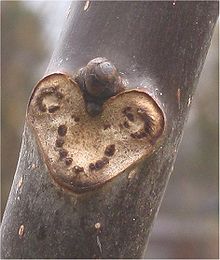 A leaf scar on Juglans regia, showing the layer of corky protective tissue that remained after the leaf separated along the abscission zone. It also shows the leaf traces of the vascular bundles that broke off when the abscission zone failed. The axillary bud associated with the leaf shows just above the scar.
A leaf scar on Juglans regia, showing the layer of corky protective tissue that remained after the leaf separated along the abscission zone. It also shows the leaf traces of the vascular bundles that broke off when the abscission zone failed. The axillary bud associated with the leaf shows just above the scar.  These lecanorine apothecia of the lichen Lecanora muralis have raised, rippled rims of tissue similar to the tissue of the main thallus body.
These lecanorine apothecia of the lichen Lecanora muralis have raised, rippled rims of tissue similar to the tissue of the main thallus body. 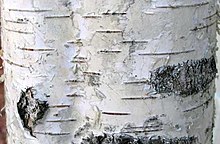 The dark horizontal lines on silver birch bark are lenticels.
The dark horizontal lines on silver birch bark are lenticels. 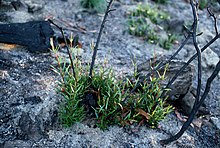 Lignotubers of Lambertia formosa growing sprouts after a bush fire
Lignotubers of Lambertia formosa growing sprouts after a bush fire  Ligule between the leaf sheath and leaf of a grass
Ligule between the leaf sheath and leaf of a grass 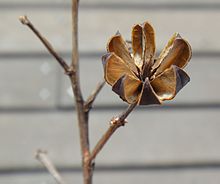 Loculicidal dehiscence of a fruit capsule. The locule walls split at the back, and the valves separate, bearing the septa on their centres.
Loculicidal dehiscence of a fruit capsule. The locule walls split at the back, and the valves separate, bearing the septa on their centres.  The loment (or lomentum) of Hedysarum occidentale splits into single-seeded segments along the visible lines of weakness when ripe. labellum lip; one of three or five petals which is (usually) different from the others, e.g. in Orchidaceae, Zingiberaceae, Cannaceae and Stylidiaceae. labiate lipped; where a corolla is divided into two parts, called an upper and lower lip, the two resembling an open mouth with lips. lacerate jagged, as if torn. lacinia In foliose lichens, a linear to elongate lobe, usually arising from or at the end of a larger lobe laciniate Of lobes – with ends irregularly divided into deeply divided, narrow, pointed segments; Of margins – deeply divided into pointed segments in an irregular manner. lacuna An empty space, hole, cavity, pit, depression, or discontinuity. lamella a thin, plate-like layer. (plural lamellae; adjective lamellate – composed of an assemblage of many layers) lamina the blade of a leaf or the expanded upper part of a petal, sepal or bract. laminal of, or pertaining to, the upper surface, such as the cortex of a lichen. lanate covered in or composed of woolly hairs. lanceolate longer than broad, narrowly ovate, broadest in the lower half and tapering to the tip, like a lance or spear head; (sometimes, and incorrectly, used to mean narrowly elliptic). lateral attached to the side of an organ, e.g. leaves or branches on a stem. For more detail see dorsal. latex a milky fluid that exudes from such plants such as spurges, figs and dandelions. laticiferous latex-bearing, producing a milky juice. latrorse a type of anther dehiscence in which the anthers open laterally toward adjacent anthers. cf. introrse, extrorse. lauroid resembling Laurus, the laurel genus, particularly its leaves. lax loose, not compact. Of bundles of hyphae in lichens – not stiff and not adglutinate. leaf an outgrowth of a stem, usually flat and green; its main function is food manufacture by photosynthesis. Abbreviation: lvs. leaf gap a parenchymatous area in the stele above (distal to) a leaf trace. leaf scar A healing layer forming on a stem where a leaf has fallen off. leaf trace A vascular bundle connecting the stele to a leaf. leaflets The ultimate segments of a compound leaf. lecanorine of lichens, having apothecia with rims of tissue similar to the tissue of the thallus, as in the genus Lecanora [15] legume 1. a fruit characteristic of the family Fabaceae, formed from one carpel and either dehiscent along both sides, or indehiscent. 2. a crop species in the family Fabaceae. 3. a plant of the family Fabaceae. lemma the lower of 2 bracts enclosing a grass flower. lenticel Typically lenticular (lens-shaped) porous tissue in bark with large intercellular spaces that allows direct exchange of gases between the internal tissues and atmosphere through the bark. lenticular 1. lens-shaped. 2. covered in lenticels. lepidote covered with small scales. leprose powdery liana a woody climbing plant, rooted in the ground ( liane is also used). liane a woody climbing plant, rooted in the ground. See also liana. lichenicolous growing on or in lichens, often but not necessarily as parasites ligneous having hard lignified tissues or woody parts, woody lignum Dead wood, typically in the context of a substrate for lichens. lignicolous Growing on wood tissue after bark as fallen or been stripped off (compare to corticolous). lignotuber a woody swelling of the stem below or just above the ground; contains Adventitious buds from which new shoots can develop, e.g. after fire. ligulate 1. bearing a ligule. 2. strap-shaped. ligule 1. A small membranous appendage on the top of the sheath of grass leaves. 2. A minute adaxial appendage near the base of a leaf, e.g. in Selaginella. 3. An extended, strap-like corolla in some daisy florets. linea, line, British line, Paris line Various pre-metric units somewhat larger than 2 mm, used in botany into the 20th century. See Line (unit) and Paris line. linear Very narrow in relation to its length, with the sides mostly parallel. See Leaf shape. lingulate tongue-shaped. lip A labellum. lithophytic A plant growing on rocks; an epilithic plant. lobe Part of a leaf (or other organ), often rounded and formed by incisions to about halfway to the midrib. loculicidal (of a fruit) Dehiscing through the centres of loculi. Compare septicidal. locule A chamber or cavity containing seeds within an ovary, pollen within an anther or spores in a sporangium. lodicule One of two or three minute organs at the base of the ovary of a grass flower, representing parts of a strongly reduced perianth. lomentum or loment A pod-like indehiscent fruit that develops constrictions between the segments and at maturity breaks into one-seeded segments instead of splitting open. longicidal (of anthers) Opening lengthwise by longitudinal slits. Compare poricidal. lunate Crescent-shaped. lumen The cavity bounded by a plant cell wall. lyrate Lyre-shaped; deeply lobed, with a large terminal lobe and smaller lateral ones.
The loment (or lomentum) of Hedysarum occidentale splits into single-seeded segments along the visible lines of weakness when ripe. labellum lip; one of three or five petals which is (usually) different from the others, e.g. in Orchidaceae, Zingiberaceae, Cannaceae and Stylidiaceae. labiate lipped; where a corolla is divided into two parts, called an upper and lower lip, the two resembling an open mouth with lips. lacerate jagged, as if torn. lacinia In foliose lichens, a linear to elongate lobe, usually arising from or at the end of a larger lobe laciniate Of lobes – with ends irregularly divided into deeply divided, narrow, pointed segments; Of margins – deeply divided into pointed segments in an irregular manner. lacuna An empty space, hole, cavity, pit, depression, or discontinuity. lamella a thin, plate-like layer. (plural lamellae; adjective lamellate – composed of an assemblage of many layers) lamina the blade of a leaf or the expanded upper part of a petal, sepal or bract. laminal of, or pertaining to, the upper surface, such as the cortex of a lichen. lanate covered in or composed of woolly hairs. lanceolate longer than broad, narrowly ovate, broadest in the lower half and tapering to the tip, like a lance or spear head; (sometimes, and incorrectly, used to mean narrowly elliptic). lateral attached to the side of an organ, e.g. leaves or branches on a stem. For more detail see dorsal. latex a milky fluid that exudes from such plants such as spurges, figs and dandelions. laticiferous latex-bearing, producing a milky juice. latrorse a type of anther dehiscence in which the anthers open laterally toward adjacent anthers. cf. introrse, extrorse. lauroid resembling Laurus, the laurel genus, particularly its leaves. lax loose, not compact. Of bundles of hyphae in lichens – not stiff and not adglutinate. leaf an outgrowth of a stem, usually flat and green; its main function is food manufacture by photosynthesis. Abbreviation: lvs. leaf gap a parenchymatous area in the stele above (distal to) a leaf trace. leaf scar A healing layer forming on a stem where a leaf has fallen off. leaf trace A vascular bundle connecting the stele to a leaf. leaflets The ultimate segments of a compound leaf. lecanorine of lichens, having apothecia with rims of tissue similar to the tissue of the thallus, as in the genus Lecanora [15] legume 1. a fruit characteristic of the family Fabaceae, formed from one carpel and either dehiscent along both sides, or indehiscent. 2. a crop species in the family Fabaceae. 3. a plant of the family Fabaceae. lemma the lower of 2 bracts enclosing a grass flower. lenticel Typically lenticular (lens-shaped) porous tissue in bark with large intercellular spaces that allows direct exchange of gases between the internal tissues and atmosphere through the bark. lenticular 1. lens-shaped. 2. covered in lenticels. lepidote covered with small scales. leprose powdery liana a woody climbing plant, rooted in the ground ( liane is also used). liane a woody climbing plant, rooted in the ground. See also liana. lichenicolous growing on or in lichens, often but not necessarily as parasites ligneous having hard lignified tissues or woody parts, woody lignum Dead wood, typically in the context of a substrate for lichens. lignicolous Growing on wood tissue after bark as fallen or been stripped off (compare to corticolous). lignotuber a woody swelling of the stem below or just above the ground; contains Adventitious buds from which new shoots can develop, e.g. after fire. ligulate 1. bearing a ligule. 2. strap-shaped. ligule 1. A small membranous appendage on the top of the sheath of grass leaves. 2. A minute adaxial appendage near the base of a leaf, e.g. in Selaginella. 3. An extended, strap-like corolla in some daisy florets. linea, line, British line, Paris line Various pre-metric units somewhat larger than 2 mm, used in botany into the 20th century. See Line (unit) and Paris line. linear Very narrow in relation to its length, with the sides mostly parallel. See Leaf shape. lingulate tongue-shaped. lip A labellum. lithophytic A plant growing on rocks; an epilithic plant. lobe Part of a leaf (or other organ), often rounded and formed by incisions to about halfway to the midrib. loculicidal (of a fruit) Dehiscing through the centres of loculi. Compare septicidal. locule A chamber or cavity containing seeds within an ovary, pollen within an anther or spores in a sporangium. lodicule One of two or three minute organs at the base of the ovary of a grass flower, representing parts of a strongly reduced perianth. lomentum or loment A pod-like indehiscent fruit that develops constrictions between the segments and at maturity breaks into one-seeded segments instead of splitting open. longicidal (of anthers) Opening lengthwise by longitudinal slits. Compare poricidal. lunate Crescent-shaped. lumen The cavity bounded by a plant cell wall. lyrate Lyre-shaped; deeply lobed, with a large terminal lobe and smaller lateral ones.
M
 Maculate leaves
Maculate leaves  Eucalyptus socialis, showing its mallee habit, a single tree with several trunks growing from an underground lignotuber
Eucalyptus socialis, showing its mallee habit, a single tree with several trunks growing from an underground lignotuber  Mast from beeches on the forest floor
Mast from beeches on the forest floor  Geranium incanum schizocarp and mericarp
Geranium incanum schizocarp and mericarp 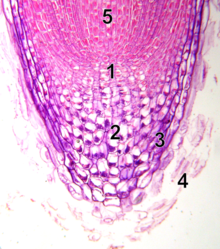 Apical meristem in root tip: 1: Meristem
Apical meristem in root tip: 1: Meristem
2: Columella
showing statocytes with statoliths
3: Lateral part of the tip
4: Dead cells
5: Elongation zone  Mesophyll as seen in the cross section of a dicotyledonous leaf A-Lower epidermis
Mesophyll as seen in the cross section of a dicotyledonous leaf A-Lower epidermis
B-Lower palisade mesophyll
C-Upper epidermis
D-Upper palisade mesophyll
E- Spongy mesophyll
F-Leaf vein  Longitudinal section of Pinus ovule A= Gametophyte
Longitudinal section of Pinus ovule A= Gametophyte
B=Egg cell
C= Micropyle
D=Integument
E= Megasporangium  Strobilus of a Selaginella A- Megaspore
Strobilus of a Selaginella A- Megaspore
B- Microsporangium
C- Megasporangium
D- Microspore
E- Sporophyll  Moniliform pods on Vachellia nilotica
Moniliform pods on Vachellia nilotica 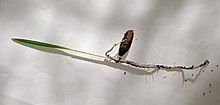 A germinating date palm, Phoenix dactylifera, a monocotyledon, showing its single cotyledon
A germinating date palm, Phoenix dactylifera, a monocotyledon, showing its single cotyledon  Mucro at the tip of the rachis of a compound leaf of Vachellia karroo
Mucro at the tip of the rachis of a compound leaf of Vachellia karroo 
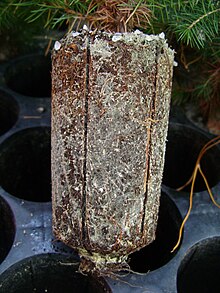 Mycelium of mycorrhiza growing on the roots of Picea maculate Spotted; marked with spots. male flower See staminate flower. mallee A growth habit in which several woody stems arise separately from a lignotuber; a plant with such a growth habit, e.g. many Eucalyptus species; vegetation characterized by such plants. mangrove Any shrub or small tree growing in salt or brackish water, usually characterized by pneumatophores; any tropical coastal vegetation characterized by such species. margin The edge of a structure, as in the edge of a leaf blade. marginal Occurring at or very close to a margin. marsh A waterlogged area or swamp. mast Edible fruit and nuts produced by woody species of plants (e.g. acorns and beechmast) which is consumed on the ground by wildlife species and some domestic animals. mealy Covered with coarse, floury powder. medulla 1. In a lichen, the typically undifferentiated tissue underneath the cortex of the thallus, or between the upper and lower cortex if both are present. The medulla is analogous to the tissues underneath the epidermis (skin) of a leaf. The uppermost region commonly contains most of the photobionts. 2. pith. See also medullary rays in wood. megasporangium the larger of two kinds of sporangium produced by heterosporous plants, producing large spores that contain the female gametophytes. Compare microsporangium. megaspore the larger of two kinds of spores produced by a heterosporous plant, giving rise to the female gametophyte. Compare microspore. megasporophyll in hetersoporous plants, a modified leaf bearing one or more megasporangia. Compare microsporophyll. megastrobilus the larger of two kinds of cones or strobili produced by gymnosperms, being female and producing the seeds. Compare microstrobilus. membranous thin, translucent and flexible, seldom green. mericarp one segment of a fruit (a schizocarp) that splits at maturity into units derived from the individual carpels, or a carpel, usually 1-seeded, released by the break-up at maturity of a fruit formed from 2 or more joined carpels. meristem Any actively dividing plant tissue. mesic Moist, avoiding both extremes of drought and wet; pertaining to conditions of moderate moisture or water supply; applied to organisms (vegetation) occupying moist habitats. mesocarp The fleshy portion of the wall of a succulent fruit inside the skin and outside the stony layer (if any), surrounding the seed(s); sarcocarp. mesomorphic Soft and with little fibrous tissue, but not succulent. mesophyll 1. The parenchyma tissues between the upper and lower epidermis. They vary in function, but usually include the photosynthetic tissue of a leaf. 2. In ecology, the blade of a leaf or leaflet that has a surface area 4500–18225 mm 2; a plant, or vegetation, that has mesophyll (sized) leaves. mesophyllous (of vegetation) Of moist habitats and having mostly large and soft leaves. mesophyte A plant thriving under intermediate environmental conditions of moderate moisture and temperature, without major seasonal fluctuations. micropyle Opening at apex of ovule. microsporangium The smaller of two kinds of sporangium produced by a heterosporous plant, producing microspores that contain the male gametophyte. Compare megasporangium. microspore The smaller of two kinds of spores produced by a heterosporous plant. Compare megaspore. microsporophyll In heterosporous plants, a modified leaf bearing one or more microsporangia. Compare megasporophyll. microstrobilus The smaller of two kinds of cones or strobilus produced by gymnosperms, being male and producing the pollen. Compare megastrobilus. midrib
Mycelium of mycorrhiza growing on the roots of Picea maculate Spotted; marked with spots. male flower See staminate flower. mallee A growth habit in which several woody stems arise separately from a lignotuber; a plant with such a growth habit, e.g. many Eucalyptus species; vegetation characterized by such plants. mangrove Any shrub or small tree growing in salt or brackish water, usually characterized by pneumatophores; any tropical coastal vegetation characterized by such species. margin The edge of a structure, as in the edge of a leaf blade. marginal Occurring at or very close to a margin. marsh A waterlogged area or swamp. mast Edible fruit and nuts produced by woody species of plants (e.g. acorns and beechmast) which is consumed on the ground by wildlife species and some domestic animals. mealy Covered with coarse, floury powder. medulla 1. In a lichen, the typically undifferentiated tissue underneath the cortex of the thallus, or between the upper and lower cortex if both are present. The medulla is analogous to the tissues underneath the epidermis (skin) of a leaf. The uppermost region commonly contains most of the photobionts. 2. pith. See also medullary rays in wood. megasporangium the larger of two kinds of sporangium produced by heterosporous plants, producing large spores that contain the female gametophytes. Compare microsporangium. megaspore the larger of two kinds of spores produced by a heterosporous plant, giving rise to the female gametophyte. Compare microspore. megasporophyll in hetersoporous plants, a modified leaf bearing one or more megasporangia. Compare microsporophyll. megastrobilus the larger of two kinds of cones or strobili produced by gymnosperms, being female and producing the seeds. Compare microstrobilus. membranous thin, translucent and flexible, seldom green. mericarp one segment of a fruit (a schizocarp) that splits at maturity into units derived from the individual carpels, or a carpel, usually 1-seeded, released by the break-up at maturity of a fruit formed from 2 or more joined carpels. meristem Any actively dividing plant tissue. mesic Moist, avoiding both extremes of drought and wet; pertaining to conditions of moderate moisture or water supply; applied to organisms (vegetation) occupying moist habitats. mesocarp The fleshy portion of the wall of a succulent fruit inside the skin and outside the stony layer (if any), surrounding the seed(s); sarcocarp. mesomorphic Soft and with little fibrous tissue, but not succulent. mesophyll 1. The parenchyma tissues between the upper and lower epidermis. They vary in function, but usually include the photosynthetic tissue of a leaf. 2. In ecology, the blade of a leaf or leaflet that has a surface area 4500–18225 mm 2; a plant, or vegetation, that has mesophyll (sized) leaves. mesophyllous (of vegetation) Of moist habitats and having mostly large and soft leaves. mesophyte A plant thriving under intermediate environmental conditions of moderate moisture and temperature, without major seasonal fluctuations. micropyle Opening at apex of ovule. microsporangium The smaller of two kinds of sporangium produced by a heterosporous plant, producing microspores that contain the male gametophyte. Compare megasporangium. microspore The smaller of two kinds of spores produced by a heterosporous plant. Compare megaspore. microsporophyll In heterosporous plants, a modified leaf bearing one or more microsporangia. Compare megasporophyll. microstrobilus The smaller of two kinds of cones or strobilus produced by gymnosperms, being male and producing the pollen. Compare megastrobilus. midrib
Also midvein.
The central and usually most prominent vein of a leaf or leaf-like organ. midvein See midrib. monad A single individual that is free from other individuals, not united with them into a group. The term is usually used for pollen to distinguish single grains from tetrads or polyads. moniliform Resembling a string of beads. monocarpic Flowering and setting seed only once before dying. See also semelparous. monochasium A cymose inflorescence with the branches arising singly. Compare dichasium, pleiochasium. monocot An abbreviation of monocotyledon. monocotyledon A flowering plant whose embryo contains one cotyledon (seed-leaf). Compare dicotyledon. monoecious (of vascular plants) Hermaphroditic, with all flowers bisexual, or with male and female reproductive structures in separate flowers but on the same plant, or of an inflorescence that has unisexual flowers of both sexes. Contrast dioecious. monoicous (of bryophyte gametophytes) Hermaphroditic or bisexual, where both male and female reproductive structures develop on the same individual. Contrast dioicous. monograph Of a group of plants, a comprehensive treatise presenting an analysis and synthesis of taxonomic knowledge of that taxon; the fullest account possible (at the time) of a family, tribe or genus. It is generally worldwide in scope and evaluates all taxonomic treatments of that taxon including studies of its evolutionary relationships with other related taxa, and cytological, genetic, morphological, palaeobotanical and ecological studies. The term is often incorrectly applied to any systematic work devoted to a single taxon. Compare revision. monomorphic Of one type, rather than several. See also dimorphic (two types) and polymorphic (many types). monophyllous Having a single leaf. monopodial A mode of stem growth and branching in which the main axis is formed by a single dominant meristem. Contrast sympodial. monostromatic Being a single cell thick, as in the alga Monostroma. monothecous having a sole compartment or cell. Compare Dithecous monotypic Containing only one taxon of the next lower rank, e.g. a family with only one genus, or a genus that includes only a single species. morphology The shape or form of an organism or part thereof. mucro
Diminutive: mucronule.
A sharp, short point, generally at the tip of a leaf or the tip of the midrib of a compound leaf. [9] mucronate Terminating in a mucro. multiple fruit A cluster of fruits produced from more than one flower and appearing as a single fruit, often on a swollen axis, as with many species of the family Moraceae. Compare aggregate fruit. muricate Covered with short hard protuberances. mutation In times before the nature of genetic encoding was understood, mutation was regarded as an abrupt, and sometimes heritable, variation from the norm of a population; for example a plant might unexpectedly produce “double” flowers, a novel colour, or a habit of growth uncharacteristic of the species or variety. Advances in genetics and molecular biology in the mid-twentieth century, showed that biological mutations comprise and reflect changes in the nucleic acid molecules that encode the genome of an organism or virus. The nucleic acid affected could be DNA in the chromosomes, or it could be extrachromosomal DNA (typically DNA in the mitochondria or chloroplasts). In RNA viruses a mutation would be a change to the genetic information that the RNA encodes. mycelium The “vegetative” (nonreproductive) part of a fungus, mostly composed of aggregations of hyphae. It functions in substrate decomposition and absorption of nutrients. mycobiont The fungal component of a lichen. Compare photobiont. mycorrhiza
pl. mycorrhizae; adj. mycorrhizal
One of several types of symbiotic association between a fungus and the roots of a plant. mycotroph
adj. mycotrophic
A plant that obtains most or all of its carbon, water, and nutrients by associating with a fungus.
N
 Hoya carnosa secretes so much nectar that it fall in drops if no pollinators remove it.
Hoya carnosa secretes so much nectar that it fall in drops if no pollinators remove it. 
 Some Senna species have extrafloral nectaries that attract ants to defend them from pests.
Some Senna species have extrafloral nectaries that attract ants to defend them from pests.  Plant stem nodes and internodes native Naturally occurring in an area, but not necessarily confined to it. Compare endemic. natural hybrid A hybrid taxon produced by chance in the wild. naturalised Describing a plant, introduced from another region, that grows and reproduces readily in competition with the natural flora. nectar A usually sweet, nutrient-rich fluid produced by the flowers of many plants and collected by bees and other insects. nectary
Plant stem nodes and internodes native Naturally occurring in an area, but not necessarily confined to it. Compare endemic. natural hybrid A hybrid taxon produced by chance in the wild. naturalised Describing a plant, introduced from another region, that grows and reproduces readily in competition with the natural flora. nectar A usually sweet, nutrient-rich fluid produced by the flowers of many plants and collected by bees and other insects. nectary
adj. nectariferous
A specialized gland that secretes nectar. neophyte A plant that has recently been introduced to a geographic area. Contrast archaeophyte. nerve Another name for a vein. node The part of a stem from which leaves or branches arise. nomen conservandum (Latin) A conserved name, usually a name that became so much better known than the correct name, that a substitution was made. nomen illegitimum A name that is either superfluous at its time of publication because the taxon to which it was applied already has a name, or the name has already been applied to another plant (a homonym). nomen invalidum A name that is not validly published, and technically is therefore not a botanical name. Abbreviation: nom. inval. See valid publication. nomen nudum A name not published in accordance with the International Code of Nomenclature for algae, fungi, and plants, usually without a diagnosis or description of the entity to which it applies, and without reference to either; such a name should not be used. nomenclature The naming of things; often restricted to the correct use of scientific names in taxonomy; a system that sets out provisions for the formation and use of names. noxious Of plants, containing harmful or unwholesome qualities. Applied in conjunction with ‘weed’ to specifically describe a plant which legislation deems harmful to the environment. Each state and territory in Australia has specific legislation governing noxious weeds. nucellus The tissue of the ovule of a seed plant that surrounds the female gametophyte. It is enclosed by integuments and is not of epidermal origin. numerous Stamens are described as numerous when there are more than twice as many as sepals or petals, especially when there is no set number of them. Compare indefinite. nut A hard, dry, indehiscent fruit containing only one seed. nutlet 1. A small nut. 2. One of the lobes or sections of the mature ovary of some members of the Boraginaceae, Verbenaceae, and Lamiaceae.
O
 Obconical syconium ( infructescence) of Ficus carica
Obconical syconium ( infructescence) of Ficus carica  Obcordate leaflets of a ternate leaf of Oxalis pes-caprae
Obcordate leaflets of a ternate leaf of Oxalis pes-caprae  Obovate leaflets of a ternate leaf of Kummerowia
Obovate leaflets of a ternate leaf of Kummerowia 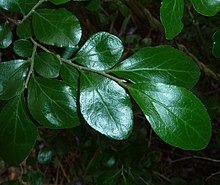 Obtuse leaves of Dovyalis zeyheri
Obtuse leaves of Dovyalis zeyheri 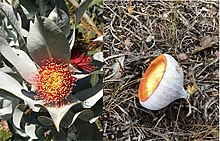 Open flower of Eucalyptus macrocarpa, next to a shed operculum
Open flower of Eucalyptus macrocarpa, next to a shed operculum  Opposite arrangement ( phyllotaxis) of leaves
Opposite arrangement ( phyllotaxis) of leaves  Orbicular leaves of Dombeya rotundifolia
Orbicular leaves of Dombeya rotundifolia 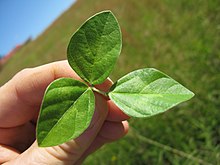 Ovate leaflets on a ternate leaf of a Vigna species ob- A prefix meaning “inversely”; usually the same shape as that described by the word stem, but attached by the narrower end. See obcordate, oblanceolate and obovate. obconic (of a fruit, hypanthium, pistil, or calyx) Shaped like an inverted cone, attached at the apex. obcordate (of a leaf blade) Broad and notched at the tip; heart-shaped but attached at the pointed end. obdiplostemonous Having stamens arranged in two whorls, and having twice as many stamens as petals, with the outer whorl being opposite the petals. Compare diplostemonous, haplostemonous. oblanceolate Having a lanceolate shape but broadest in the upper third. oblate Having a spherical shape but flattened at the poles. obligate (of parasites) Unable to survive without a host. Contrast facultative. oblique Slanting; of a leaf or stem, larger on one side of the midrib than the other, in other words asymmetrical. obloid Having a three-dimensional oblong shape, e.g. a fruit. oblong Having a length a few times greater than the width, with sides almost parallel and ends rounded. obovate (of a leaf) Having a length about 1.5 times the width, and widest above the centre. obsolete Not evident, or at most rudimentary or vestigial. obtrapeziform trapeziform, but attached by the narrower trapezoidal base (e.g. of a leaf) obtuse Blunt or rounded; having converging edges that form an angle of more than 90°. Compare acute. ocrea
Ovate leaflets on a ternate leaf of a Vigna species ob- A prefix meaning “inversely”; usually the same shape as that described by the word stem, but attached by the narrower end. See obcordate, oblanceolate and obovate. obconic (of a fruit, hypanthium, pistil, or calyx) Shaped like an inverted cone, attached at the apex. obcordate (of a leaf blade) Broad and notched at the tip; heart-shaped but attached at the pointed end. obdiplostemonous Having stamens arranged in two whorls, and having twice as many stamens as petals, with the outer whorl being opposite the petals. Compare diplostemonous, haplostemonous. oblanceolate Having a lanceolate shape but broadest in the upper third. oblate Having a spherical shape but flattened at the poles. obligate (of parasites) Unable to survive without a host. Contrast facultative. oblique Slanting; of a leaf or stem, larger on one side of the midrib than the other, in other words asymmetrical. obloid Having a three-dimensional oblong shape, e.g. a fruit. oblong Having a length a few times greater than the width, with sides almost parallel and ends rounded. obovate (of a leaf) Having a length about 1.5 times the width, and widest above the centre. obsolete Not evident, or at most rudimentary or vestigial. obtrapeziform trapeziform, but attached by the narrower trapezoidal base (e.g. of a leaf) obtuse Blunt or rounded; having converging edges that form an angle of more than 90°. Compare acute. ocrea
Also spelled ochrea.
A sheath formed from two stipules encircling the node in members of the Polygonaceae. odd-pinnate
Also imparipinnate
Having an odd number of leaflets in a compound pinnate leaf, such that there is only one terminal leaflet. oft. An abbreviation of “often”. Compare usu. and s.t.. -oideae A suffix added to the stem of a generic name to form the name of a subfamily, e.g. Fumaria → Fumarioideae. olim Formerly, e.g. “olim B”, formerly in the Berlin herbarium ( Herbarium Berolinense). ontogeny The sequence of developmental stages through which an organism passes as it grows. operculum (calyptra) A lid or cover that becomes detached at maturity, e.g. in Eucalyptus, a cap covering the bud and formed by the fusion or cohesion of perianth parts. opposite 1. Describing leaves or flowers borne at the same level but on directly opposite sides of their common axis. 2. Describing the occurrence of something on the same radius as something else, e.g. anthers opposite sepals. Compare alternate. opus utique oppressum
pl. opera utique oppressa
Listed after the botanical name of a plant, or the name of a publication, this indicates that a publication is listed in the International Code of Nomenclature for algae, fungi, and plants as a suppressed work. Botanical names of the specified rank in the publication are considered not validly published (article 34). orbicular Flat and more or less circular. order A group of one or more families sharing common features, ancestry, or both. ortet The original single parent plant from which a clone ultimately derives. orthotropous Describes an ovule that is erect, with the micropyle directed away from the placenta; atropous. Compare amphitropous, anatropous, campylotropous. oval See elliptical. ovary The basal portion of a carpel or group of fused carpels, enclosing the ovules. ovate Shaped like a section through the “long axis” of an egg and attached by the wider end. ovoid Egg-shaped, with wider portion at base; 3-dimensional object, ovate in all sections through long-axis. ovule Loosely, the seed before fertilization; a structure in a seed plant within which one or more megaspores are formed (after fertilization it develops into a seed).
P
 The thick trunk of Brachychiton rupestris accumulates moisture as a means of survival of droughts, and presents a marked example of a pachycaul habit.
The thick trunk of Brachychiton rupestris accumulates moisture as a means of survival of droughts, and presents a marked example of a pachycaul habit.  This Curio articulatus is pachycladous in that it has a disproportionately thick stem.
This Curio articulatus is pachycladous in that it has a disproportionately thick stem. 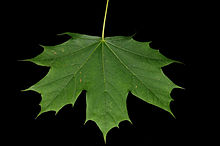
 The inflorescence of Agave americana is a giant panicle.
The inflorescence of Agave americana is a giant panicle.  Asclepias physocarpa shedding seeds, each with its silky pappus
Asclepias physocarpa shedding seeds, each with its silky pappus 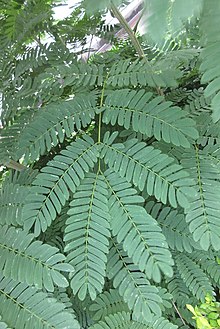 Doubly paripinnate leaves of Delonix regia
Doubly paripinnate leaves of Delonix regia  Aloe ferox in flower, bearing two inflorescences on peduncles }}
Aloe ferox in flower, bearing two inflorescences on peduncles }} 
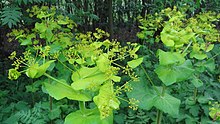 Perfoliate leaves of Smyrnium perfoliatum with stems passing through them
Perfoliate leaves of Smyrnium perfoliatum with stems passing through them  The leaves of Aponogeton madagascariensis are perforate.
The leaves of Aponogeton madagascariensis are perforate.  The perigonium of a moss (red in this case), also called a splash-cup, surrounds the antheridia and aids in dispersal of sperm.
The perigonium of a moss (red in this case), also called a splash-cup, surrounds the antheridia and aids in dispersal of sperm.  Liquidambar styraciflua bud emerging from its protective brown imbricate cataphyll scales, also known as perules
Liquidambar styraciflua bud emerging from its protective brown imbricate cataphyll scales, also known as perules 
 Rock-splitting roots of the petricolous large-leaved rock fig, Ficus abutilifolia
Rock-splitting roots of the petricolous large-leaved rock fig, Ficus abutilifolia  The phaneranthous habit of the red flowering gum, Corymbia ficifolia, can attract pollinators such as the honey eater, Anthochaera chrysoptera, from a considerable distance.
The phaneranthous habit of the red flowering gum, Corymbia ficifolia, can attract pollinators such as the honey eater, Anthochaera chrysoptera, from a considerable distance.  Seedlings of Acacia fasciculifera bear leaves that illustrate the ancestral function of their phyllodes as petioles.
Seedlings of Acacia fasciculifera bear leaves that illustrate the ancestral function of their phyllodes as petioles.  Pileus of the fruiting body of the fungus Pluteus admirabilis
Pileus of the fruiting body of the fungus Pluteus admirabilis 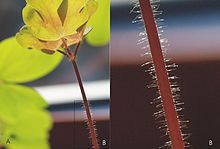 Glandular pilose hairs on the stem of Aquilegia grata
Glandular pilose hairs on the stem of Aquilegia grata 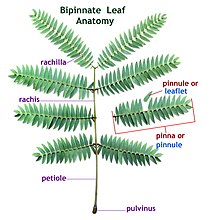 Bipinnate leaf anatomy showing a pinna (or pinnule)
Bipinnate leaf anatomy showing a pinna (or pinnule)  Simply pinnate leaf of Ekebergia capensis
Simply pinnate leaf of Ekebergia capensis 
Compare staminate flower.  Electron micrographs of sections of wood of a conifer ( Picea abies) show pits in the tracheid walls.
Electron micrographs of sections of wood of a conifer ( Picea abies) show pits in the tracheid walls.  This crustose lichen, Caloplaca thallincola, is placodioid, with radiating “arms” in its growth pattern.
This crustose lichen, Caloplaca thallincola, is placodioid, with radiating “arms” in its growth pattern. 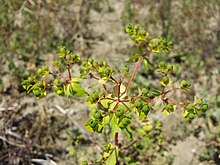 Flowers in the inflorescence of Euphorbia platyphyllos open simultaneously, as a pleiochasium
Flowers in the inflorescence of Euphorbia platyphyllos open simultaneously, as a pleiochasium  The corolla of Datura discolor is plicate.
The corolla of Datura discolor is plicate.  Longitudinal section of maize kernel, scale=1.4mm:
Longitudinal section of maize kernel, scale=1.4mm:
A= pericarp, B= aleurone
C=stalk, D= endosperm
E= coleorhiza, F= radicle
G= hypocotyl, H= plumule
I= scutellum, J= coleoptile 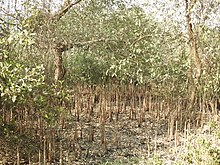 Pneumatophores on a species of mangrove
Pneumatophores on a species of mangrove  The sharp projections on the trunk of the knobthorn, Senegalia nigrescens, are prickles rather than thorns, botanically speaking.
The sharp projections on the trunk of the knobthorn, Senegalia nigrescens, are prickles rather than thorns, botanically speaking.  Procumbent growth habit of Sagina procumbens, growing mainly along the soil surface, but without rooting
Procumbent growth habit of Sagina procumbens, growing mainly along the soil surface, but without rooting  Carpobrotus and other prostrate plants growing on sand in Sicily, striking root and binding the soil as they grow
Carpobrotus and other prostrate plants growing on sand in Sicily, striking root and binding the soil as they grow  Pubescent stem and inflorescence of Gomphrena celosioides
Pubescent stem and inflorescence of Gomphrena celosioides  Punctate glands on Artemisia nova are visible because they are not covered with epidermal hairs.
Punctate glands on Artemisia nova are visible because they are not covered with epidermal hairs. 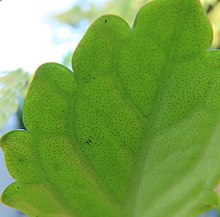 Punctiform glands on the undersurface of a Plectranthus leaf
Punctiform glands on the undersurface of a Plectranthus leaf  Pyramidal growth habit of Picea pungens
Pyramidal growth habit of Picea pungens 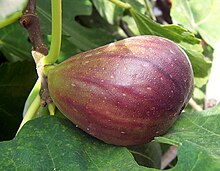 Pyriform syconium (“fruit”) of domestic fig pachycaul with a disproportionately thick trunk pachycladous with disproportionately thick stems palea
Pyriform syconium (“fruit”) of domestic fig pachycaul with a disproportionately thick trunk pachycladous with disproportionately thick stems palea
(plural paleae)
1. The upper of two bracts enclosing a grass flower, major contributors to chaff in harvested grain. 2. Chaffy scales on the receptacles of many Asteraceae. 3. Chaffy scales on the stipe of many ferns. paleate Bearing paleae or chaffy scales, as in description of the receptacle of a capitulum of a plant in the Asteraceae. paleaceous Chaff-like in texture. palmate 1. leaf with veins radiating out from a central point (usually at the top of a petiole), resembling spread out fingers pointing away from the palm. 2. A compound palmate leaf has leaflets that radiate from a central point (usually at the top of a petiole). palmatifid Deeply divided into several lobes arising from more or less the same level. palmatisect Intermediate between palmate and palmatifid, i.e. the segments are not fully separated at the base; often more or less digitate. pandurate shaped like the body of a fiddle (mainly, of plant leaves) panicle
adj. paniculate
A compound raceme; an indeterminate inflorescence in which the flowers are borne on branches of the main axis or on further branches of these. papilionate Butterfly-like; having a corolla like that of a pea. papilla
pl. papillae; adj. papillose or papillate
A small, elongated protuberance on the surface of an organ, usually an extension of one epidermal cell. pappus In daisy florets, a tuft or ring of hairs or scales borne above the ovary and outside the corolla (representing the reduced calyx); a tuft of hairs on a fruit. paraperigonium
Also paraperigone.
An anomalous secondary outgrowth of the perianthal meristem with ramifying vasculature. See also perigonium, perianth, and corona. [16] parasite An organism living on or in a different organism, from which it derives nourishment. Some plant species are parasitic. Compare saprophyte and epiphyte. parenchyma A versatile ground tissue composed of living primary cells which performs a wide variety of structural and biochemical functions in plants. parietal Attached to the marginal walls of a structure, e.g. ovules attached to placentas on the wall of the ovary. See placentation. paripinnate Having an even number of leaflets (or pinnae), i.e. terminated by a pair of pinnae as opposed to a single pinna. Compare imparipinnate. parthenocarpy The development or production of fruit without fertilization. Compare stenospermocarpy. patent
Also patulous.
Spreading; standing at 45–50° to the axis. See also erecto-patent. patulous See patent. pauciflor Having few flowers per inflorescence. Compare pluriflor and uniflor. pectinate Pinnately divided with narrow segments closely set like the teeth of a comb. pedate Having a terminal lobe or leaflet, and on either side of it an axis curving outward and backward, bearing lobes or leaflets on the outer side of the curve. pedicel
adj. pedicellate
The stalk of a flower; may also be applied to the stalk of a capitulum in the Asteraceae. peduncle
adj. pedunculate
The stalk of an inflorescence. peltate Shield-like, with the stalk attached to the lower surface and not to the margin. pellucid Transmitting light; for example, said of tiny gland dots in the leaves of e.g. Myrtaceae and Rutaceae that are visible when held in front of a light. pendulous Hanging, for example an ovule attached to a placenta on the top of the ovary. Compare suspended. penicillate Tufted like an artist’s brush; with long hairs toward one end. penninervation
adj. penninerved
With pinnately arranged veins. pentamerous In five parts, particularly with respect to flowers, five parts in each whorl. See also trimerous and tetramerous. pepo A type of berry formed from an inferior ovary and containing many seeds, usually large with a tough outer skin (e.g. a pumpkin or cucumber). perennating Of an organ that survives vegetatively from season to season. A period of reduced activity between seasons is usual. perennial A plant whose life span extends over several years. perfect (of a flower) Bisexual; containing both male and female reproductive parts in the same inflorescence. Contrast imperfect. perfoliate With its base wrapped around the stem (so that the stem appears to pass through it), e.g. of leaves and bracts. perforate With many holes. Used to describe the texture of pollen exine, and also to indicate that tracheary elements have a perforation plate. See also fenestrate. perforation plate in a tracheary element, part of the cell wall that is perforated; present in vessel members but not in tracheids. Should not be confused with a pit. perianth The collective term for the calyx and corolla of a flower (generally used when the two are too similar to be easily distinguishable). Abbreviation: P; for instance, P 3+3 indicates the calyx and corolla each have 3 elements, i.e. 3 sepals + 3 petals. pericarp The wall of a fruit, developed from the ovary wall. periclinal Curved along parallel to a surface. Compare anticlinal. pericycle A cylinder of parenchyma or sclerenchyma cells that lies just inside the endodermis and is the outer most part of the stele of plants. perigonium In flowering plants, synonym of perianth. 2. In mosses, the leaves surrounding the antheridia, also called a splash-cup, e.g. in Polytrichum juniperinum. perigynium A sac from a modified tubular bract, or when fully closed an utricle, around the pistillate flower of sedges perigynous Borne around the ovary, i.e. of perianth segments and stamens arising from a cup-like or tubular extension of receptacle (free from the ovary but extending above its base). Compare epigynous, hypogynous. persistent Remaining attached to the plant beyond the usual time of falling, for instance sepals not falling after flowering, flower parts remaining through maturity of fruit. Compare deciduous, caducous. perule
adj. perulate
1. The scales covering a leaf or flower bud, or a reduced scale-like leaf surrounding the bud. Buds lacking perulae are referred to as “naked”. 2. In Camellias the final bracts and sepals become indistinguishable and are called perules. 3. A kind of sac formed by the adherent bases of the two lateral sepals in certain orchids. petal In a flower, one of the segments or divisions of the inner whorl of non-fertile parts surrounding the fertile organs, usually soft and conspicuously coloured. Compare sepal. petaloid Like a petal; soft in texture and coloured conspicuously. petiolary (or petiolar) Associated with a petiole, as in petiolary glands. petiolate (of a leaf) Having a petiole. Contrast sessile. petiole The stalk of a leaf. petiolule The stalk of a leaflet. petricolous Rock-dwelling; living on or among rocks. phaneranthous Showy, as in showy flowers that advertise to pollinators, as opposed to aphananthous (unshowy) phanerogam Gymnosperms and angiosperms; plants producing stamens and gynoecia; literally plants with conspicuous sexual reproductive organs. Compare cryptogams. phenology The study of the timing of seasonal biological phenomena, such as flowering, leaf emergence, fruit ripening and leaf fall. phloem A specialised conducting tissue in vascular plants that transports sucrose from the leaves to other plant organs. photobiont In a lichen, the component that does the photosynthesis, the green algae ( Chlorophyta) or blue-green algae ( Cyanobacteria). (compare to mycobiont, the fungal component.) Also called the phycobiont. photosynthesis The process by which energy from sunlight is used to convert carbon dioxide and water into simple sugars in cells containing chloroplasts. All plants, except certain parasites, can perform photosynthesis. phycobiont In a lichen, a synonym for photobiont. phyllary An individual bract within an involucre or involucel. phyllid A leaf-like extension of the stem in Bryophytes phyllode
adj. phyllodineous
A leaf with the blade much reduced or absent, and in which the petiole and or rachis perform the functions of the whole leaf, e.g. many acacias. Compare cladode. phyllopodium (in ferns) A short outgrowth of the stem on which the frond is borne and which remains attached to the rhizome after the frond has been shed. phylloplane the surface of a leaf, considered as a habitat for organisms. phyllosphere The above-ground surface of plants as a habitat for epiphytic microorganisms. phylum A level of classification or taxonomic rank below kingdom and above class. Traditionally, in botany the term division has been used instead of phylum. phytomelan
Also phytomelanin; adj. phytomelanous
A black, inert, organic material that forms a crust-like covering of some seeds, commonly found in Asparagales, Asteraceae, etc. pileate Having a cap, a pileus. pileus A cap or cap-shaped structure, such as the cap of mushrooms or the plumule of some monocotyledons. piliform Having the shape of a cap, a pileus. pilose covered with soft, weak, thin and clearly separated hairs, which are usually defined as long and sometimes ascending. pinna (plural pinnae) a primary segment of a compound leaf. pinnate a compound leaf with leaflets arranged on each side of a common petiole or axis; also applied to how the lateral veins are arranged in relation to the main vein. pinnatifid Pinnately lobed. pinnatisect pinnately divided almost to midrib but segments still confluent. pinnule or pinnula Usage varies:
ultimate free division (or leaflets) of a compound leaf,
or
a pinnate subdivision of a multipinnate leaf. pistil 1. a single carpel when the carpels are free. 2. a group of carpels when the carpels are united by the fusion of their walls. pistillate flower a flower containing one or more pistils but no stamens. Sometimes called a female flower. pistillode A sterile or rudimentary pistil. pit In tracheary elements, a section of the cell wall where the secondary wall is missing, and the primary wall is present. Pits generally occur in pairs and link two cells. pith The central region of a stem, inside the vascular cylinder; the spongy parenchymatous central tissue in some stems and roots. placenta The tissue within an ovary to which the ovules are attached. placentation The arrangement of ovules inside ovary; for example axile, free-central, parietal, marginal, basal, or apical. placodioid The form of a lichen thallus which radiates outward with the ends of the radiating arms peeling up from the substrate, but which lack a cortex on the underside (unlike foliose lichens). Plant Breeders Rights (PBR) These rights, governed by Plant Breeder’s Rights Acts give the plant breeder legal protection over the propagation of a cultivar, and the exclusive rights to produce and to sell it, including the right to license others to produce and sell plants and reproductive material of a registered, deliberately bred variety. Cf. UPOV. Plant Variety Rights (PVR) Governed by the Plant Variety Rights the registration of new varieties is now governed by Plant Breeders Rights. plastochron The time between successive leaf initiation events. pleiochasium pl. pleiochasia. An inflorescence in which several buds come out at the same time. cf. monochasium, dichasium. plicate Pleated; folded back and forth longitudinally like a fan, such as the leaves of fan palm species. The concept often appears in specific names in forms such as Kumara plicatilis and Acacia plicata. Commonly such names are not correctly appropriate, but are applied to distichous structures rather than plicate. -plinerved (of leaves) A suffix indicating that the main nerves are lateral and arise from a point distinctly above the base of the leaf. Combined with a numerical prefix to form words like 3-plinerved, 5-plinerved, and so on. Such leaves are especially characteristic of the family Melastomataceae. See for example Dissotis. plumose Like a feather; with fine hairs branching from a main axis. plumule The part of an embryo that gives rise to the shoot system of a plant. Compare radicle. pluriflor Having many flowers per inflorescence. See also pauciflor and uniflor. pluriovulate Having many ovules as in placentae, carpels, or ovaries. pneumatophore A vertical appendage, aerial at low tide, on the roots of some plants. Pneumatophore functions are unclear, but possibly related to gas exchange, or to root anchoring. Pneumatophores typically occur on mangrove roots, but some versions occur on species of conifers, such as some in the Taxodioideae. pod 1. A legume, the fruit of a leguminous plant, a dry fruit of a single carpel, splitting along two sutures. 2. A siliqua and silicula, the fruit of Brassicaceae, a dry fruit composed of two carpels separated by a partition. podocarpium In 4 genera of the coniferous family Podocarpaceae: ( Acmopyle, Dacrycarpus, Falcatifolium, or Podocarpus), a group of fleshy fused bracts beneath the female cone, often brightly-coloured, which swell to enclose the developing seeds above, and attract fruit-eating animals. Eckenwalder, James E. (2009). ′′Conifers of the World: the complete reference.′′. ′′Timber Press, Inc., London.′′. p. 648-61. ISBN 978-0-88192-974-4. pollen powdery mass shed from anthers (of angiosperms) or microsporangia (of gymnosperms); the microspores of seed plants; pollen-grains. pollen-mass pollen-grains cohering by a waxy texture or fine threads into a single body; pollinium, e.g. in orchids. pollen transmitting tissue the tissue in the style of a flower through which the pollen tubes grow. pollination The transfer of pollen from a male organ (such as an anther) to the receptive region of a female organ (such as a stigma). pollinium See pollen-mass. polygamodioecious Having bisexual and male flowers on some plants and bisexual and female flowers on others. Compare Androdioecious, Andromonoecious, dioecious, monoecious, polygamomonoecious, polygamous. polygamomonoecious having male, female, and bisexual flowers on the same plant. Compare Androdioecious, Andromonoecious, polygamodioecious, polygamous. polygamous having bisexual and unisexual flowers on the same plant. polymorphic Of several different kinds (in respect to shape and/or size), hence polymorphism. See also monomorphic (a single type) and dimorphic (two types) polyphyllous having many leaves or perianth segments. Compare symphyllous, gamophyllous, apophyllous. polyploid with more than two of the basic sets of chromosomes in the nucleus; any sporophyte with cells containing three or more complete sets of chromosomes. Various combinations of words or numbers with ‘-ploid’ indicate the number of haploid sets of chromosomes, e.g. triploid = 3 sets, tetraploid = 4 sets, pentaploid = 5 sets, hexaploid = 6 sets, and so on. polystemonous having numerous stamens; the number of stamens being at least twice the number of sepals or petals, but not strictly three or four times that number. pome A fruit that has developed partly from the ovary wall but mostly from the hypanthium (e.g. an apple). population 1. All individuals of one or more species within a prescribed area. 2. A group of organisms of one species, occupying a defined area and usually isolated to some degree from other similar groups. 3. In statistics, the whole group of items or individuals under investigation. poricidal Opening by pores, as with the capsule of a poppy or the anthers in several families of plants. Compare longicidal. posterior Positioned behind or toward the rear. Contrast anterior. prickle
adj. prickly
A hard, pointed outgrowth from the surface of a plant (involving several layers of cells but not containing a vein); a sharp outgrowth from the bark, detachable without tearing wood. Compare thorn. primary species In lichens, a species reproducing mainly by sexual reproduction rather than by vegetative reproduction. primary vein The single vein or array of veins that is conspicuously larger than any others in a leaf. In pinnate venation, the single primary vein can generally be found in the middle of the leaf; in palmate venation, several such veins radiate from a point at or near the base of the leaf. propagule In lichens, a part of the thallus that has both fungal and algal parts and can break off for vegetative reproduction, e.g. an isidium, phyllidium, phyllocladium, or soredium). prophyll A leaf formed at the base of a shoot, usually smaller than those formed later. pro parte In part. In nomenclature, used to denote that the preceding taxon includes more than one currently recognized entity, and that only one of those entities is being considered. procumbent Spreading along the ground but not rooting at the nodes; not as close to the ground as prostrate. propagule Any structure capable of generating a new plant; includes seeds, spores, bulbils, etc. prostrate Lying flat on the ground; commonly rooting at nodes that touch the soil surface. protandrous Having male sex organs which mature before the female ones, e.g. a flower shedding pollen before the stigma is receptive. Compare protogynous. proteranthous With new leaves appearing before flowers. See also hysteranthous and synanthous. prothallus A gametophyte plant, usually flattened and delicate, e.g. in ferns and fern allies. protogynous Having female sex organs which mature before the male ones, e.g. a flower shedding pollen after the stigma has ceased to be receptive. Compare protandrous. proximal Near the point of origin or attachment. Compare distal. pruinose Covered with a powdery, waxy material; having a bloom. pseudanthium A type of inflorescence occurring in the Asteraceae and Euphorbiaceae, in which multiple flowers are grouped together to form a flower-like structure, commonly called a head or capitulum. pseudo- A prefix meaning “false, not genuine”, e.g. a pseudo-bulb is a thickened, bulb-like internode in orchids, but not an actual bulb. pseudobasifixed (of an anther) Connected to the filament of the stamen by connective tissue which extends in a tube around the filament tip. See also basifixed and dorsifixed. pseudostipule An enlarged, persistent axillary bud scale that resembles a stipule; common in Bignoniaceae. pseudoverticillate Having the appearance of being whorled ( verticillate), without actually being so. puberulous
Also puberulent.
Covered with minute soft erect hairs. pubescent Downy; covered with short, soft hairs, especially erect hairs. pulverulent Having powdery or crumbly particles as if pulverized. pulvinate Having a pulvinus. pulvinus a swelling at either end of a petiole of a leaf or petiolule of a leaflet, e.g. in Fabaceae, that permits leaf movement. punctate (from Latin puncta= puncture or prick-mark) marked with an indefinite number of dots, or with similarly small items such as translucent glands or tiny hollows. punctiform Dot-like or in the shape of a prick-mark. pungent Having a sharp, hard point. pustule A blister-like swelling. pustulate Having pustules. pyramidal (of a growth habit) Conical or pyramid-shaped. Most familiar in some coniferous trees, especially species adapted to snowy climates pyrene The stone of a drupe, consisting of the seed surrounded by the hardened endocarp. pyriform Pear-shaped; a term for solid shapes that are roughly conical in shape, broadest one end and narrowest at the other. As a rule the distal third of their length is the broadest, and they are narrowest near the proximal end, the base, where the stalk, if any, attaches. pyrophile Plants which need fire for their reproduction. pyrophyte Plants which have adapted to tolerate fire.
Q
 Siliques of Conringia orientalis tend toward a quadrate cross section. quadrate More or less square.
Siliques of Conringia orientalis tend toward a quadrate cross section. quadrate More or less square.
R
 Bulbinella latifolia racemes. The flowers are already open at the bottom; at the top, the axis is still growing and budding.
Bulbinella latifolia racemes. The flowers are already open at the bottom; at the top, the axis is still growing and budding.  Rachis of Vachellia karroo bipinnate leaf, with components labelled as follows: A. Rachilla (the diminutive of rachis)
Rachis of Vachellia karroo bipinnate leaf, with components labelled as follows: A. Rachilla (the diminutive of rachis)
B. Pinnule
C. Jugary glands
D. Juga (plural of jugum)
E. Base of petiole
F. Petiolary gland
G. Rachis  Radicles emerging from germinating seeds
Radicles emerging from germinating seeds 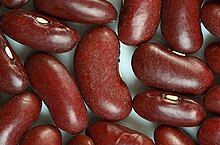 Reniform kidney bean seeds
Reniform kidney bean seeds  A leaf of Ficus carica, illustrating reticulate venation
A leaf of Ficus carica, illustrating reticulate venation  The central leaflets of the ternate leaves of Searsia glauca are oblate and commonly retuse.
The central leaflets of the ternate leaves of Searsia glauca are oblate and commonly retuse.  Typical rhizome. This one is a specimen of Iris pseudacorus.
Typical rhizome. This one is a specimen of Iris pseudacorus. 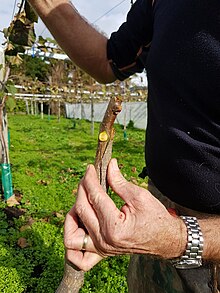 Grafting kiwifruit vine scion onto rootstock below
Grafting kiwifruit vine scion onto rootstock below  Unidentified Gasteria bearing leaves with a rugose surface, banded with callosities
Unidentified Gasteria bearing leaves with a rugose surface, banded with callosities  Rugose leaves of Alocasia are stiffer than flat leaves of the same size and thickness would be.
Rugose leaves of Alocasia are stiffer than flat leaves of the same size and thickness would be.  Unidentified Crassula bearing rugulose leaves with fine wrinkles in the epidermis
Unidentified Crassula bearing rugulose leaves with fine wrinkles in the epidermis  The runcinate lobes of a Taraxacum officinale leaf point downward, i.e. toward the stem. raceme
The runcinate lobes of a Taraxacum officinale leaf point downward, i.e. toward the stem. raceme
adj. racemose,
An indeterminate inflorescence in which the main axis produces a series of flowers on lateral stalks, the oldest at the base and the youngest at the top. Compare spike. Also racemiform or racemoid – having the form of a raceme rachilla (rhachilla) the axis of a grass spikelet, above the glumes. rachis
pl. rachises or rachides
The axis of an inflorescence or a pinnate leaf; for example ferns; secondary rachis is the axis of a pinna in a bipinnate leaf distal to and including the lowermost pedicel attachment. radial With structures radiating from a central point as spokes on a wheel (e.g. the lateral spines of a cactus). radiate (of daisies, of a capitulum) With ray floret surrounding disc florets. radical Springing from the root; clustered at base of stem. radicle The part of an embryo giving rise to the root system of a plant. Compare plumule. rainforest A moist temperate or tropical forest dominated by broad-leaved trees that form a continuous canopy. ramet An individual member of a clone. ramicaul a single-leafed stem, as in Pleurothallis orchids. [17] ray 1. zygomorphic (ligulate) flowers in a radiate flowerhead, that is, ray-florets/flowers, for example Asteraceae. 2. each of the branches of an umbel. receptacle the axis of a flower, in other words, floral axis; torus; for example in Asteraceae, the floral base or receptacle is the expanded tip of the peduncle on which the flowers are inserted. recumbent bent back toward or below the horizontal. recurved bent or curved backward or downward. reduplicate folded outward, or with the two abaxial surfaces together. reflexed bent sharply back or down. registered name a cultivar name accepted by the relevant International Cultivar Registration Authority. registration 1. the act of recording a new cultivar name with an International Cultivar Registration Authority. 2. recording a new cultivar name with a statutory authority like the Plant Breeder’s Rights Office. 3. recording a trademark with a trade marks office. regular See Actinomorphic. reniform Kidney-shaped. replum a framework-like placenta to which the seeds attach, and which remains after each valve drops away. resupinate 1. In botany, describing leaves or flowers that are in an inverted position because the petiole or pedicel, respectively, is twisted 180 degrees. compare: hyper-resupinate. 2. In lichenology, referring to either having or being a fruiting body that lies flat on the substrate, with the hymenium either over the whole surface or at the periphery. reticulate forming a network (or reticulum), e.g. veins that join one another at more than one point. retrorse Bent backward or downward. Compare antrorse. retuse Having a blunt ( obtuse) and slightly notched apex. revision an account of a particular plant group, like an abbreviated or simplified monograph. Sometimes confined to the plants of a particular region. Similar to a monograph in clearly distinguishing the taxa and providing a means for their identification. Compare monograph. revolute rolled under (downward or backward), for example when the edges of leaves are rolled under toward the midrib. Compare involute. rhachis See rachis. rhizine The “root” or “trunk” projection of a foliose lichen that attaches the lichen to the substrate (what the lichen is growing on) rhizodermis the root epidermis, the outermost primary cell layer of the root rhizome a perennial underground stem usually growing horizontally. See also stolon. Abbreviation: rhiz. rhizomatous adj. a plant whose above ground stem is derived from a below ground stem (rhizome). cf. arhizomatous (arhizomatic) rhizosphere the below-ground surface of plants and adjacent soil as a habitat for microorganisms. rhytidome the dead region of the bark and root that lies outside the periderm. rhombic like a rhombus: an oblique figure with four equal sides. Compare trapeziform, trullate. rhomboid a four-sided figure with opposite sides parallel but with adjacent sides an unequal length (like an oblique rectangle); see also rhombic. rhomboidal a shape, for instance of a leaf, that is roughly diamond-shaped with length equal to width. rimose with many cracks, as in the surface of a crustose areolate lichen. root a unit of a plant’s axial system which is usually underground, does not bear leaves, tends to grow downward, and is typically derived from the radicle of the embryo. root hairs outgrowths of the outermost layer of cells just behind the root tips, functioning as water-absorbing organs. root microbiome the dynamic community of microorganisms associated with plant roots. rootstock 1. the part of a budded or grafted plant which supplies the root system, also simply called a stock. 2. plants selected to produce a root system with some specific attribute, e.g. a virus-free rootstock. rosette when parts are not whorled or opposite but appear so, due to the contractions of internodes, e.g. the petals in a double rose or a basal cluster of leaves (usually close to the ground) in some plants. rostellate possessing a beak (rostellum). Synonym of rostrate. rostrate with a beak. rotate circular and flattened; for example a corolla with a very short tube and spreading lobes (for instance some Solanaceae). ruderal a plant that colonises or occupies disturbed waste ground. See also weed. rudiment In the structure of a plant, an item that is at best hardly functional, either because it is immature and has not yet completed its development (such as a leaf still incompletely formed inside a bud), or because its role in the organism’s morphology cannot be completed and therefore is futile (such as the leaf rudiment at the tip of a phyllode, that will be shed while immature, because the leaf function will be taken over by the phyllode). Compare cataphyll, vestige. rudimentary Being of the nature of a rudiment; at most barely functional because incompletely developed; begun, but far from completed, either temporarily or permanently. Compare vestigial. rugose Wrinkled, either covered with wrinkles, or crumpled like a wrinkled leaf, either as a stiffening structure, or in response to disease or insect damage. rugulose Finely wrinkled. ruminate (usually applied to endosperm) Irregularly grooved or ridged; appearing chewed, e.g. the endosperm in certain members of Myristicaceae. runcinate Sharply pinnatifid or cleft, with the segments directed downward. runner See stolon. rupicolous Rupestral, saxicolous, growing on or among rocks. Compare epilithic and lithophytic. rush A plant of the family Juncaceae or, more loosely, applied to various monocotyledons.
S
 Sagittate leaves of an Alocasia plant
Sagittate leaves of an Alocasia plant 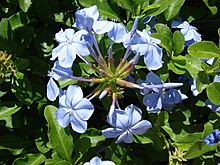 Salverform flowers of Plumbago auriculata
Salverform flowers of Plumbago auriculata  Trametes versicolor, the turkey tail fungus, is a saprotroph that consumes dead wood in forests. Its common name comes from the conspicuously patterned brackets, but the main body of the saprotroph consists of the largely invisible mycelium that penetrates the dead wood and digests it.
Trametes versicolor, the turkey tail fungus, is a saprotroph that consumes dead wood in forests. Its common name comes from the conspicuously patterned brackets, but the main body of the saprotroph consists of the largely invisible mycelium that penetrates the dead wood and digests it.  Strawberry plants reproduce mainly by sarments, stolons such as these, often called runners; at their nodes the sarments put up tufts of leaves and strike root if there is any good soil beneath.
Strawberry plants reproduce mainly by sarments, stolons such as these, often called runners; at their nodes the sarments put up tufts of leaves and strike root if there is any good soil beneath. 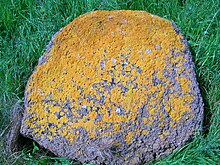
 Micrograph of the scabrid undersurface of the leaf of Stipa pulcherrima.
Micrograph of the scabrid undersurface of the leaf of Stipa pulcherrima. 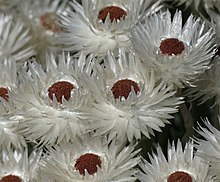 Involucral bracts of Syncarpha species are as scarious as tissue paper, but look like live petals for years, so they are known as “Everlastings” and valued for dried arrangements.
Involucral bracts of Syncarpha species are as scarious as tissue paper, but look like live petals for years, so they are known as “Everlastings” and valued for dried arrangements.  Isolated sclereid or stone cell in plant tissue
Isolated sclereid or stone cell in plant tissue 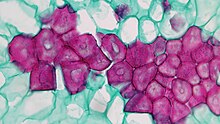 Sclereids in gritty particles of pear tissue
Sclereids in gritty particles of pear tissue 
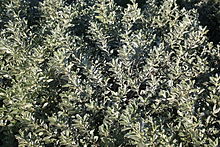 Sericeous leaves of Podalyria sericea, the silver sweet pea bush
Sericeous leaves of Podalyria sericea, the silver sweet pea bush  The fruits of Lepidium bonariense are silicles, green and circular, with a notch at the apex.
The fruits of Lepidium bonariense are silicles, green and circular, with a notch at the apex.  Silky foliage of the silvertree, Leucadendron argenteum
Silky foliage of the silvertree, Leucadendron argenteum  Sori under the leaf of the fern Rumohra adiantiformis. Some are still covered by their indusia.
Sori under the leaf of the fern Rumohra adiantiformis. Some are still covered by their indusia. 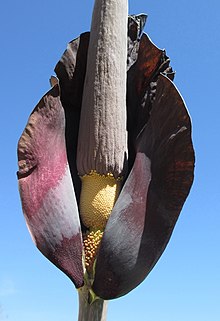 Spadix of Amorphophallus maximus within its spathe. The female flowers are around the bottom of the spadix, the male flowers above, and the sterile top part is the major source of pollinator attractants.
Spadix of Amorphophallus maximus within its spathe. The female flowers are around the bottom of the spadix, the male flowers above, and the sterile top part is the major source of pollinator attractants. 
 Drosera spatulata leaves are markedly spathulate.
Drosera spatulata leaves are markedly spathulate.  The flowering spike of this Salvia nemorosa differs from a raceme in that the flowers are practically sessile.
The flowering spike of this Salvia nemorosa differs from a raceme in that the flowers are practically sessile.  Spines emerging from the areoles of an Echinopsis species
Spines emerging from the areoles of an Echinopsis species  Spinescent leaves of Salsola australis: stiff, narrowed, and with lobes ending in spiny points
Spinescent leaves of Salsola australis: stiff, narrowed, and with lobes ending in spiny points  Bird nest fungi, Nidulariaceae, bear spectacular examples of splash-cups, with spores that are spread by raindrops.
Bird nest fungi, Nidulariaceae, bear spectacular examples of splash-cups, with spores that are spread by raindrops.  Sporangia of the fungus Rhizopus
Sporangia of the fungus Rhizopus 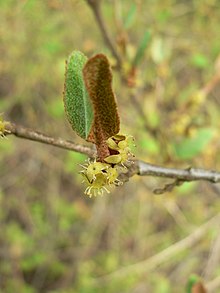
 Manilkara hexandra flowers have both stamens with anthers and staminodes that have no anthers.
Manilkara hexandra flowers have both stamens with anthers and staminodes that have no anthers. 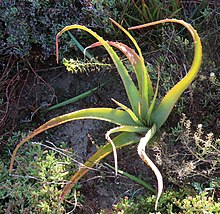 Subulate leaves are narrow with an elongated, tapering tip, as seen on this species of Aloe.
Subulate leaves are narrow with an elongated, tapering tip, as seen on this species of Aloe.  The large, succulent, acaulescent, linear, cuspidate mottled leaves of the Gasteria and the small, succulent, cordate leaves of a Crassula species contrast with the linear, herbaceous leaves of a Hypoxis species.
The large, succulent, acaulescent, linear, cuspidate mottled leaves of the Gasteria and the small, succulent, cordate leaves of a Crassula species contrast with the linear, herbaceous leaves of a Hypoxis species.  Suckers around the trunk of Dypsis lutescens
Suckers around the trunk of Dypsis lutescens  Sulcate (specifically polysulcate) grooves along the stem of Scorzonera cana
Sulcate (specifically polysulcate) grooves along the stem of Scorzonera cana  Superior ovary ovary in an Aloe species. One flower is sectioned to display the pistil and hypanthium.
Superior ovary ovary in an Aloe species. One flower is sectioned to display the pistil and hypanthium.  The suture along the concave curve of the pod of Crotalaria, along which the seeds are attached, is where the single carpel has folded shut.
The suture along the concave curve of the pod of Crotalaria, along which the seeds are attached, is where the single carpel has folded shut. 
adj. saprophytic
A plant, or loosely speaking, a fungus or similar organism, deriving its nourishment from decaying organic matter such as dead wood or humus, and usually lacking chlorophyll. Compare parasite, saprotroph and epiphyte. saprotroph
adj. saprotrophic
An organism deriving its nourishment from decaying organic matter. Contrast parasite and epiphyte. sarment A long, slender, prostrate stolon, commonly called a runner. sarmentose Reproducing by sarments; strawberry plants are the most familiar example. saxicolous Growing on stone, like some lichens. scabrid .
Also scabrous
Rough to the touch, with short hard protrusions or hairs. scalariform Ladder-like in structure or appearance. scale 1. A reduced or rudimentary leaf, for example around a dormant bud. 2. A flattened epidermal outgrowth, such as those commonly found on the leaves and rhizomes of ferns. scandent Climbing, by whatever means. See also: scandent in Wiktionary. scape
adj. scapose
A stem-like flowering stalk of a plant with radical leaves. scapose Having the floral axis more or less erect with few or no leaves; consisting of a scape. scarious Dry and membranous. schizocarp A dry fruit formed from more than one carpel but breaking apart into individual carpels ( mericarps) when ripe. scion The aerial part of a graft combination, induced by various means to unite with a compatible understock or rootstock. sclereid A cell with a thick, lignified, cell wall that is shorter than a fiber cell and dies soon after the thickening of its cell wall. sclerenchyma A strengthening or supporting tissue composed of sclereids or of a mixture of sclereids and fibers. sclerophyll
adj. sclerophyllous
A plant with hard, stiff leaves; any structure stiffened with thick-walled cells. scorpioid (of a cymose inflorescence) Branching alternately on one side and then the other. Compare helicoid. scrobiculate Having very small pits. scrubland Dense vegetation dominated by shrubs. scurf Minute, loose, membranous scales on the surface of some plant parts, such as leaves. secondary metabolite Chemicals produced by a plant that do not have a role in so-called primary functions such as growth, development, photosynthesis, reproduction, etc. secondary species In lichens, a “species” taxon of lichen reproducing only by vegetative means, whose components reproduce mainly by sexual means – cf. primary species. secretory tissue The tissues concerned with the secretion of gums, resins, oils and other substances in plants. section (sectio) The category of supplementary taxa intermediate in rank between subgenus and series. It is a singular noun always written with a capital initial letter, in combination with the generic name. secund Having all the parts grouped on one side or turned to one side (applied especially to inflorescences). sedge A plant of the family Cyperaceae. seed A ripened ovule, consisting of a protective coat enclosing an embryo and food reserves; a propagating organ formed in the sexual reproductive cycle of gymnosperms and angiosperms (together, the seed plants). segment A part or subdivision of an organ, e.g. a petal is a segment of the corolla. A term sometimes used when the sepals and petals are indistinguishable. self-pollination (also selfing) The acceptance by stigmas of pollen from the same flower or from flowers on the same plant, which means they are self-compatible. semaphyll A structure such as a bract or sepal (if the remainder of the perianth is inconspicuous) which has become modified to attract pollinators. semelparity When a plant flowers once then dies. semiterete Rounded on one side but flat on the other. See also terete. senecioid See anthemoid. sensitive A descriptive term for stigmas that, in response to touch, close the two lobes of the stigma together, ending the receptivity of the stigma, at least for the time that the lobes are closed together. Mimulus is perhaps the best-known example. sensu In the sense of. sensu auct. (of a plant group or name) As cited by a named authority. sensu amplo (of a plant group or name) In a generous or ample sense. sensu lato (of a plant group) In a broad sense. sensu strictissimo (of a plant group) In the narrowest sense. sensu stricto (of a plant group) In a narrow sense. sepal In a flower, one of the segments or divisions of the outer whorl of non-fertile parts surrounding the fertile organs; usually green. Compare petal. septicidal (of a fruit) Dehiscing along the partitions between loculi. Compare loculicidal. septum
pl. septa
A partition, e.g. the membranous wall separating the two valves of the pod of Brassicaceae. seriate Arranged in rows. sericeous Silky with dense appressed hairs. series The category of supplementary taxa intermediate in rank between section and species. It is often used as a plural adjective, as in ” Primula subgenus Primula sect. Primula series Acaules“. serrate Toothed with asymmetrical teeth pointing forward; like the cutting edge of a saw. serrulate Finely serrate. sessile Attached without a stalk, e.g. of a leaf without a petiole or a stigma, when the style is absent. seta
pl. setae; adj. setose, setaceous
A bristle or stiff hair (in Bryophytes, the stalk of the sporophyte). A terminal seta is an appendage to the tip of an organ, e.g. the primary rachis of a bipinnate leaf in Acacia. sheath A tubular or rolled part of an organ, e.g. the lower part of the leaf in most grasses. shoot The aerial part of a plant; a stem and all of its dependent parts (leaves, flowers, etc.). shrub A woody perennial plant without a single main trunk, branching freely, and generally smaller than a tree. sigmoid Shaped like the letter ‘S’. silicula or silicle A fruit like a siliqua, but stouter, not more than twice as long as wide. silique siliqua A dry, dehiscent fruit (in contrast to a silicula, more than twice as long as wide) formed from a superior ovary of two carpels, with two parietal placentas and divided into two loculi by a ‘false’ septum. silky Densely covered with fine, soft, straight, appressed hairs, with a lustrous sheen and satiny to the touch. silviculture The science of forestry and the cultivation of woodlands for commercial purposes and wildlife conservation. simple Undivided or unsegmented, e.g. a leaf not divided into leaflets (note, however, that a simple leaf may still be entire, toothed or lobed) or an unbranched hair or inflorescence. sinuate Having deep, wave-like depressions along the margins, but more or less flat. Compare undulate. sinus A notch or depression between two lobes or teeth in the margin of an organ. solitary Single, of flowers that grow one plant per year, one in each axil, or widely separated on the plant; not grouped in an inflorescence. soralia In a lichen, the structure that bears soredia for non sexual reproduction. soredium
pl. soredia
In a lichen, a small groups of algal cells surrounded by fungal filaments that form in soralia, which break off and grow new lichens without sexual reproduction after being dispersed by wind. Compare to an isidium, which breaks off and is dispersed by mechanical means. sorus
pl. sori
A cluster of sporangia. Sori typically occur in ferns, some Algae and some fungi. In many fern species the sorus is covered by a protective indusium. sp. An abbreviation of species (singular), often used when the genus is known but the species has not been determined, as in ” Brassica sp.” See spp.. spp. An abbreviation of species (plural), often used to collectively refer to more than one species of the same genus, as in ” Astragalus spp.” See sp.. spadix A spicate (spike-like) inflorescence with the flowers crowded densely, even solidly, around a stout, often succulent axis. Particularly typical of the family Araceae spathe
adj. spathaceous
A large bract ensheathing an inflorescence. Traditionally any broad, flat blade. spathulate or spatulate Spoon-shaped; broad at the tip with a narrowed projection extending to the base. species A group, or populations of individuals, sharing common features and/or ancestry, generally the smallest group that can be readily and consistently recognized; often, a group of individuals capable of interbreeding and producing fertile offspring. The basic unit of classification, the category of taxa of the lowest principal rank in the nomenclatural hierarchy. Strict assignment to a species is not always possible, as it is subject to particular contexts, and the species concept under consideration. specific epithet Follows the name of the genus, and is the second word of a botanical binomial. The generic name and specific epithet together constitute the name of a species; i.e. the specific epithet is not the species name. speirochoric Unintentional introduction by seeds. [18] Compare agochoric. spica
adj. spicate
Another name for a spike. spike
adj. spicate
An unbranched, indeterminate inflorescence in which the flowers are without stalks. Compare raceme. spikelet A subunit of a spike inflorescence, especially in grasses, sedges, and some other monocotyledons, consisting of one to many flowers and associated bracts or glumes. spine
adj. spinose
A stiff, sharp structure formed by the modification of a plant organ that contains vascular tissue, e.g. a lateral branch or a stipule; includes thorns. spinescent Ending in a spine; modified to form a spine. spiral Of arrangement, when plant parts are arranged in a succession of curves like the thread of a screw, or coiled in a cylindrical or conical manner. splash-cup (sporangia) A cup-like structure in fungi such as Nidulariaceae and in cryptogams such as some mosses. The cups function in spore dispersal, in which the energy of raindrops falling into the cup causes the water to splash outward carrying the spores. [19] sporangium (sporangia) A structure in which spores are formed and from which the mature spores are released sporangiophore An organ bearing sporangia, e.g. the cones of Equisetum. spore A haploid propagule, produced by meiosis in diploid cells of a sporophyte that can germinate to produce a multicellular gametophyte. sporocarp A fruiting body containing spores. sporophyll In pteridophytes, a modified leaf that bears a sporangium or sporangia. sporophyte The diploid multicellular phase in the alternation of generations of plants and algae that produces the spores. Compare gametophyte. sport A naturally occurring variant of a species, not usually present in a population or group of plants; a plant that has spontaneously mutated so that it differs from its parent plant. spreading Extending horizontally, e.g. in branches. Standing out at right angles to an axis, e.g. in leaves or hairs. spur 1. a short shoot. 2. a conical or tubular outgrowth from the base of a perianth segment, often containing nectar. squamule (plural squamules, squamulae) small scales; In lichens, squamules are overlapping plate-like forms, sometimes overlapping so much as to become leaf-like, but which lack a lower cortex, unlike the leafy forms of foliose lichens – adjective: squamulose. squamulose Covered with small scales ( squamules). In lichens, being composed of squamules. squarrose Having tips of leaves, stems, etc. radiating or projecting outward, e.g. in the moss Rhytidiadelphus squarrosus. s.t. An abbreviation for “sometimes”. Compare usu. and oft.. stalk The supporting structure of an organ, usually narrower in diameter than the organ itself. stamen
adj. staminate
The male organ of a flower, consisting (usually) of a stalk called the filament and a pollen-bearing head called the anther. staminate flower
Also male flower.
A flower with stamens but no pistil. staminode A sterile stamen, often rudimentary, sometimes petal-like. staminophore A structure, around the apex of eucalypt, myrtaceae hypanthia, that supports the stamens. standard The large posterior petal of pea-flowers. standard specimen A representative specimen of a cultivar or other taxon which demonstrates how the name of that taxon should be used. stele The primary vascular system (including phloem, xylem, and ground tissue) of plant stems and roots. stellate Star-shaped. stem The plant axis, either aerial or subterranean, which bears nodes, leaves, branches, and flowers. stem-clasping See amplexicaul. stenospermocarpy The development or production of fruit that is seedless or has minute seeds because of the abortion of seed development. Compare parthenocarpy. sterile Infertile, as with a stamen that does not bear pollen or a flower that does not bear seed. stigma The pollen-receptive surface of a carpel or group of fused carpels, usually sticky; usually a point or small head at the summit of the style. stipe Generally a small stalk or stalk-like structure. The stalk of a frond of a fern; the stalk supporting the pileus of a mushroom; the stalk of a seaweed such as a kelp; the stalk-like support of a gynaecium or a carpel stipella
Also stipel; pl. stipellae
One of two small secondary stipules at the base of leaflets in some species. stipitate stalked; borne on a stipe; of an ovary, borne on a gynophore. stipulate Bearing stipules. stipule A small appendage at the bases of leaves in many dicotyledons. stock See rootstock. stolon
Also runner.
A slender, prostrate or trailing stem, producing roots and sometimes erect shoots at its nodes. See also rhizome. stoloniferous Having stolons. stoma
pl. stomata
A pore or small hole in the surface of a leaf (or other aerial organ) allowing the exchange of gases between tissues and the atmosphere. stone cell a sclereid cell, such as the cells that form the tissue of nut shells and the stones of drupes. striate Striped with parallel, longitudinal lines or ridges. strigose Covered with appressed, straight, rigid, bristle-like hairs; the appressed equivalent of hispid. strobilus
pl. strobili
A cone-like structure consisting of sporophylls (e.g. conifers and club mosses) or sporangiophores (e.g. in Equisetopsida) borne close together on an axis. style An elongated part of a carpel or a group of fused carpels between the ovary and the stigma. stylodium An elongate stigma that resembles a style; a false style, e.g. commonly found in the Poaceae and Asteraceae. stylopodium A swelling on top of the ovary, at the base of the styles commonly found in flowers of the Apiaceae. stylulus The elongated apex of a free carpel which functions like the style of a syncarpous ovary, allowing pollen tubes from its stigma to enter the locule of only that carpel. subcoriaceous Slightly leathery or coriaceous. subgenus A category of supplementary taxa intermediate between genus and section. The name of a subgenus is a singular noun, always has a capital initial letter and is used in combination with the generic name, e.g. Primula subgenus Primula. subglobose Inflated, but less than spherical. See also globose. suborbicular nearly orbicular, flat and almost circular in outline. See also orbicular. subpetiolate (of a leaf) Having an extremely short petiole, and may appear sessile. subquadrangular Not quite square. Compare quadrangular. subshrub
Also undershrub
A small shrub which may have partially herbaceous stems, but generally a woody plant less than 1 metre (3.3 ft) high. subspecies A taxonomic category within a species, usually used for geographically isolated or morphologically distinct populations of the same species. Its taxonomic rank occurs between species and variety. subtend To stand beneath or close to, as in a bract at the base of a flower. subulate Narrow and tapering gradually to a fine point. succulent 1. Juicy or fleshy. 2. A plant with a fleshy habit. sucker A shoot of more or less subterranean origin; an erect shoot originating from a bud on a root or a rhizome, sometimes at some distance from the stem of the plant. suffrutex
pl. suffrutices
A subshrub or undershrub. sulcate Furrowed; grooved. May be single ( monosulcate), two ( bisulcate) or many ( polysulcate). superficial On the surface. superior ovary An ovary borne above the level of attachment of the other floral parts, or above the base of a hypanthium. Compare inferior ovary and half-inferior ovary. suspended Of an ovule, when attached slightly below the summit of the ovary. Compare pendulous. suture A junction or seam of union. See fissure and commissure. sward Extensive, more or less even cover of a surface, e.g. a lawn grass. Compare tussock. sympatric Having more or less similar or overlapping ranges of distribution. sympodial A mode of growth in which the main axis is repeatedly terminated and replaced with a lateral branch. Examples occur in the family Combretaceae, including the genera Terminalia and Combretum. cf. monopodial. syconium A hollow infructescence containing multiple fruit, such as that of a fig. syn-
Also sym-.
A prefix meaning “with, together”. symmetrical Capable of being divided into at least two equal, mirror-image halves (e.g. zygomorphic) or having rotational symmetry (e.g. regular or Actinomorphic). Compare irregular and asymmetrical. sympetalous Having united ( connate or fused) petals, not free ( apopetalous). See also syntepalous (having fused tepals). symphyllous a single perianth-whorl of united segments. Compare gamophyllous ( synonym), apophyllous, polyphyllous synangium A fused aggregate of sporangia, e.g. in the trilocular sporangia of the whisk fern Psilotum. synanthous A type of growth in which new leaves and flowers appear and die back at the same time. See also hysteranthous and proteranthous. synaptospermy The dispersal of diaspores as units, where each bears more than one seed, for example where each diaspore comprises an entire inflorescence, as in Brunsvigia or multi-seeded fruit as in Tribulus zeyheri. Ephemeral synaptospermy is the term for when the diaspores split into units containing fewer or single seeds each, as in most tumbleweeds. True synaptospermy is when the diaspore generally remains entire until germination, as commonly happens in species of Grielum. syncarpous (of a gynoecium) Composed of united carpels. synonym An outdated or ‘alternative’ name for the same taxon. synoecious A synonym of bisexual. syntepalous Having fused tepals. See also sympetalous (having fused petals).
T
 Leucaena leucocephala taproot exposed in a roadcut
Leucaena leucocephala taproot exposed in a roadcut 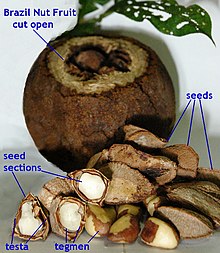 Cross sections of Brazil nut seeds, showing the tegmen and testa
Cross sections of Brazil nut seeds, showing the tegmen and testa  Tendrils of Cucurbita pepo, some supporting the stem on the frame, some failing to find a point of attachment
Tendrils of Cucurbita pepo, some supporting the stem on the frame, some failing to find a point of attachment 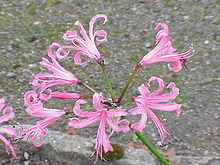 Nerine bowdenii, showing the lack of visible sepals, and the inferior ovaries. The sepals are incorporated into the corolla as tepals.
Nerine bowdenii, showing the lack of visible sepals, and the inferior ovaries. The sepals are incorporated into the corolla as tepals.  Terete raceme of Kniphofia shown together with a cross section of a peduncle. A: Inflorescence; B: Terete peduncle; C: Cross section of a terete peduncle
Terete raceme of Kniphofia shown together with a cross section of a peduncle. A: Inflorescence; B: Terete peduncle; C: Cross section of a terete peduncle 

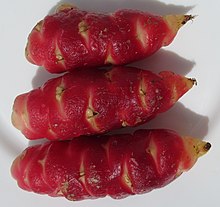 Oxalis tuberosa, a stem tuber
Oxalis tuberosa, a stem tuber  Corms of Crocosmia bear typical tunics formed of cataphylls growing from the nodes of the corm. The illustration shows still-living cataphylls as white tissue, whereas the functional, hard, resistant tunic is brown.
Corms of Crocosmia bear typical tunics formed of cataphylls growing from the nodes of the corm. The illustration shows still-living cataphylls as white tissue, whereas the functional, hard, resistant tunic is brown. 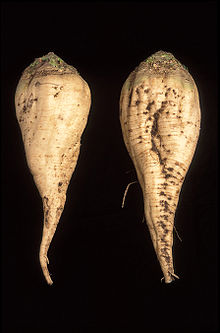 Turbinate (spinning-top shaped) roots of sugar beet
Turbinate (spinning-top shaped) roots of sugar beet 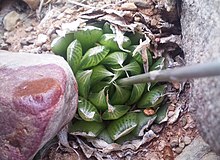 Haworthia lockwoodii, with its leaves turgid and green after seasonal rains, storing water against the coming dry period
Haworthia lockwoodii, with its leaves turgid and green after seasonal rains, storing water against the coming dry period 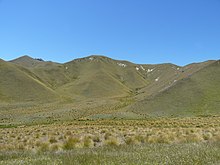
pl. taxa
A group or category in a system of biological classification. taxonomy The study of the principles and practice of classification. tegmen The inner layer of the testa (seed coat). It develops from the inner integument of the ovule. tendril Any slender organ modified from a stem, leaf, leaflet, or stipule and used by climbing plants to cling to an object. tepal A segment of a perianth, either sepal or petal; usually used when all perianth segments are indistinguishable in appearance. terete
Also semiterete
Circular in cross-section; more or less cylindrical without grooves or ridges. terminal Situated at the tip or apex. ternate In groups of three; of leaves, arranged in whorls of three; of a single leaf, having the leaflets arranged in groups of three. terrestrial Of or on the ground; of a habitat, on land as opposed to in water ( aquatic), on rocks ( lithophytic), or on other plants ( epiphytic). testa The seed coat. tetrad A group of four; usually used to refer to four pollen grains which remain fused together through maturity (e.g. in the Epacridaceae). [20] tetragonal Square; having four corners; four-angled, e.g. the cross-sections of stems of herbaceous Lamiaceae. tetramerous In four parts, particularly with respect to flowers; four parts in each whorl. See also trimerous and pentamerous. tetraploid Having four complete sets of chromosomes in each sporophyte cell. tetraspore The asexual spore of red algae. It is so named because each sporangium produces just four spores. See Rhodophyceae. [21] thalamus
Obsolete
1. A synonym for receptacle. 2. The inflorescence disk of members of the Asteraceae. 3. A calyx, as used by Carl Linnaeus. having a thallus-like structure; in the form of a thallus; thalloid thallus A vegetative structure that is not differentiated into stem and leaves, as in lichens, algae, thallose liverworts and certain vascular plants (e.g. Lemna; plural thalli theca One of the usually two synangia in which pollen is produced in flowering plants. It consists of two fused sporangia known as pollen sacs. The wall between the pollen sacs disintegrates before dehiscence, which is usually by a common slit. thorn A sharp, stiff point, usually a modified stem, that cannot be detached without tearing the subtending tissue; a spine. Compare prickle. throat The opening of a corolla or perianth. thyrse A branched inflorescence in which the main axis is indeterminate ( racemose) and the lateral branches determinate ( cymose). tomentum A dense covering of short, matted hairs. Tomentose is often used as a general term for bearing an indumentum, but this is not a recommended use. toothed Having a more or less regularly incised margin. torus See receptacle. transmitting tissue See pollen transmitting tissue. trapeziform 1. Like a trapezium (a four-sided figure with two parallel sides of unequal length). 2. Like a trapezoid (a four-sided figure, or quadrilateral, with neither pair of sides equal); sometimes used erroneously as a synonym for rhombic. tree A woody plant, usually with a single distinct trunk and generally more than 2–3 metres (6.6–9.8 ft) tall. triad A group of three. triangular Planar and with 3 sides. tribe A taxonomic grouping that ranks between genus and family. trichome In non-filamentous plants, any hair-like outgrowth from the epidermis, e.g. a hair or bristle; sometimes restricted to unbranched epidermal outgrowths. trifid. Split into three parts. See also bifid. trifoliate A compound leaf of three leaflets; for example, a clover leaf. trifoliolate See trifoliate. trigonous Triangular in cross-section and obtusely angled. Compare triquetrous. trimerous In three parts, particularly with respect to flowers; having three parts in each whorl. See also tetramerous and pentamerous. trinerved Having three nerves or veins. triplinerved (of leaves) Having three main nerves with the lateral nerves arising from the midnerve above the base of the leaf. triporate (of pollen) Having three pores triquetrous More or less triangular in cross-section, but acutely angled (with 3 distinct longitudinal ridges). Compare trigonous. trivalve Divided into three valves. Also trivalvar. See also bivalve. trivial name The second word in the two-part scientific name of an organism. Compare specific epithet. trophophyll A vegetative, nutrient-producing leaf or microphyll whose primary function is photosynthesis. It is not specialized or modified for some other function. Compare sporophyll. trullate Ovate but angled, as with a bricklayer’s trowel; inversely kite-shaped. Compare rhombic. truncate Cut off squarely; having an abruptly transverse end. trunk The upright, large and typically woody main stem of a tree. truss A compact cluster of flowers or fruits arising from one centre; evident in many rhododendrons. tuber Any of many types of specialised vegetative underground storage organs. They accumulate food, water, or in protection from death by fire, drought, or other hard times. Tubers generally are well differentiated from other plant organs; for example, informally a carrot is not generally regarded as a tuber, but simply a swollen root. In this they differ from the tuber of a sweet potato, which has no special root-like function. Similarly, corms are not generally regarded as tubers, even though they are underground storage stems. Tubers store food for the plant, and also have important roles in vegetative reproduction. They generally are of two main types: stem tubers form by the swelling of an underground stem growing from a root, or from structures such as underground stolons. Stem tubers generally produce propagative buds at their stem nodes, forming a seasonal perennating organ, e.g. a potato. The main other class is the root tuber, also called tuberoid. They differ from stem tubers in features such as that, like any normal root, they do not form nodes. tubercle A small wart-like outgrowth or protuberance of tissue. tuberculate Covered in tubercles. See warty. tuberoid An alternative name for underground storage organ formed by the swelling of a root; occurs in many orchids. tuberous Resembling a tuber or producing tubers. tubular Having the form of a tube or cylinder. tufted Densely fasciculate at the tip. tunic The outer covering of some bulbs and corms. tunicate (of bulbs) Consisting of concentric coats. turbinate Shaped like a spinning top or beetroot. turgid Swollen with liquid; bloated; firm. Compare flaccid. tussock A dense tuft of vegetation, usually well separated from neighbouring tussocks, for example in some grasses. Compare sward. two-ranked Having leaves arranged in two rows in the same plane, on opposite sides of the branch. See distichous. type An item (usually an herbarium specimen) to which the name of a taxon is permanently attached, i.e. a designated representative of a plant name. Important in determining the priority of names available for a particular taxon. type genus In nomenclature, a single genus on which a taxonomic family is based.
U
 Umbo in the middle of the cap of Cantharellula umbonata
Umbo in the middle of the cap of Cantharellula umbonata  Thorny prickles of Senegalia mellifera subspecies detinens are unciform.
Thorny prickles of Senegalia mellifera subspecies detinens are unciform. 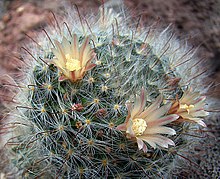 Mammillaria bocasana has uncinate tips on its major spines.
Mammillaria bocasana has uncinate tips on its major spines.  Pitchers of the species Nepenthes ventricosa tend to be markedly urceolate. umbel A racemose inflorescence in which all the individual flower stalks arise in a cluster at the top of the peduncle and are of about equal length; in a simple umbel, each stalk is unbranched and bears only one flower. A cymose umbel looks similar to an ordinary umbel but its flowers open centrifugally. umbo A rounded elevation, such as in the middle of the top of an umbrella or mushroom; a central boss or protuberance, such as on the scale of a cone. umbonate Having an umbo, with a conical or blunt projection arising from a flatter surface, as on the top of a mushroom or in the scale of a pine cone. unciform Hook-shaped. uncinate Having a hook at the apex. undershrub A low shrub, often with flowering branches that die off in winter. Compare subshrub. understory Plant life growing beneath the forest canopy. undulate Wavy and not flat. Compare sinuate. uniflor Having a single flower (uniflory). Compare pauciflor (few) and pluriflor (many). unilocular Having one loculus or chamber, e.g. the ovary in the families Proteaceae and Fabaceae. uniserial Arranged in a single row or series. Unbranched. Uniseriate. uniseriate Arranged in a single row or series. Unbranched. Uniserial. unisexual Of one sex; bearing only male or only female reproductive organs, dioecious, dioicous. See Sexual reproduction in plants. unitegmic (of an ovule) Covered by a single integument. See also bitegmic, having two integuments. urceolate Shaped like an urn or pitcher, with a swollen middle and narrowing top. Examples include the pitchers of many species of the pitcher plant genera Sarracenia and Nepenthes. usu. An abbreviation of usually. Compare s.t. and oft.. utricle 1. A small bladder; a membranous bladder-like sac from the ovary wall, thin pericarp, becomes more or less bladdery or inflated at maturity enclosing an ovary or fruit. 2. In sedges, a fruit in which the fruit is loosely encloses from a modified tubular bract, see perigynium.
Pitchers of the species Nepenthes ventricosa tend to be markedly urceolate. umbel A racemose inflorescence in which all the individual flower stalks arise in a cluster at the top of the peduncle and are of about equal length; in a simple umbel, each stalk is unbranched and bears only one flower. A cymose umbel looks similar to an ordinary umbel but its flowers open centrifugally. umbo A rounded elevation, such as in the middle of the top of an umbrella or mushroom; a central boss or protuberance, such as on the scale of a cone. umbonate Having an umbo, with a conical or blunt projection arising from a flatter surface, as on the top of a mushroom or in the scale of a pine cone. unciform Hook-shaped. uncinate Having a hook at the apex. undershrub A low shrub, often with flowering branches that die off in winter. Compare subshrub. understory Plant life growing beneath the forest canopy. undulate Wavy and not flat. Compare sinuate. uniflor Having a single flower (uniflory). Compare pauciflor (few) and pluriflor (many). unilocular Having one loculus or chamber, e.g. the ovary in the families Proteaceae and Fabaceae. uniserial Arranged in a single row or series. Unbranched. Uniseriate. uniseriate Arranged in a single row or series. Unbranched. Uniserial. unisexual Of one sex; bearing only male or only female reproductive organs, dioecious, dioicous. See Sexual reproduction in plants. unitegmic (of an ovule) Covered by a single integument. See also bitegmic, having two integuments. urceolate Shaped like an urn or pitcher, with a swollen middle and narrowing top. Examples include the pitchers of many species of the pitcher plant genera Sarracenia and Nepenthes. usu. An abbreviation of usually. Compare s.t. and oft.. utricle 1. A small bladder; a membranous bladder-like sac from the ovary wall, thin pericarp, becomes more or less bladdery or inflated at maturity enclosing an ovary or fruit. 2. In sedges, a fruit in which the fruit is loosely encloses from a modified tubular bract, see perigynium.
V
 Photomicrograph of a cross section of a vascular bundle in the stem of a typical herbaceous dicotyledon A: Phloem
Photomicrograph of a cross section of a vascular bundle in the stem of a typical herbaceous dicotyledon A: Phloem
B: Cambium
C: Xylem
D: Fibrous sheath of vascular bundle  Leaf veins and velutinous hairs of Nepeta
Leaf veins and velutinous hairs of Nepeta  Velamen, the pale grey membrane covering the mature part of the root of an epiphyte
Velamen, the pale grey membrane covering the mature part of the root of an epiphyte  Flower stalks and sepal tubes of Pueraria phaseoloides are covered with velutinous ( velvety) hairs.
Flower stalks and sepal tubes of Pueraria phaseoloides are covered with velutinous ( velvety) hairs.  Verticillaster of Salvia yangii
Verticillaster of Salvia yangii 

 Asparagus virgatus owes its specific epithet virgatus to the twiggy appearance of its virgate shoots. vallecular canal A resin canal coinciding with a longitudinal groove in the seeds of Asteraceae. A longitudinal cavity in the cortex of the stems of Equisetum, coinciding with a groove in the stem surface. valvate (of sepals and petals in bud) Meeting edge-to-edge but not overlapping. valve A portion of an organ that fragments or splits open, e.g. the teeth-like portions of a pericarp in a split (dehisced) capsule or pod when ripe. var. An abbreviation of varietas. variant A plant or group of plants showing some measure of difference from the characteristics associated with a particular taxon. variegated Irregularly marked with blotches or patches of another colour. varietas
Asparagus virgatus owes its specific epithet virgatus to the twiggy appearance of its virgate shoots. vallecular canal A resin canal coinciding with a longitudinal groove in the seeds of Asteraceae. A longitudinal cavity in the cortex of the stems of Equisetum, coinciding with a groove in the stem surface. valvate (of sepals and petals in bud) Meeting edge-to-edge but not overlapping. valve A portion of an organ that fragments or splits open, e.g. the teeth-like portions of a pericarp in a split (dehisced) capsule or pod when ripe. var. An abbreviation of varietas. variant A plant or group of plants showing some measure of difference from the characteristics associated with a particular taxon. variegated Irregularly marked with blotches or patches of another colour. varietas
Often variety in common usage and abbreviated as var.
A taxonomic rank below that of species and between the ranks of subspecies and form. vascular Referring to the conducting tissues ( xylem and phloem) of vascular plants. vascular bundle A bundle of vascular tissue in the primary stems of vascular plants, consisting of specialised conducting cells for the transport of water ( xylem) and assimilate ( phloem). vasculum A container used by botanists for collecting field specimens. vein
Also nerve.
A strand of vascular tissue, e.g. in the leaves of vascular plants. veinlet A small vein; the ultimate (visible) division of a vein. velamen A spongy tissue covering the aerial roots of orchids and some other epiphytes. velutinous See velvety. velvety Densely covered with fine, short, soft, erect hairs. venation The arrangement of veins in a leaf. ventral From Latin venter, meaning “belly”. The opposite of dorsal. Partly because the term originally referred to animals rather than plants, usage in botany is arbitrary according to context and source. In general “ventral” refers to “the belly or lower part”, but in botanical usage such concepts are not always clearly defined and may be contradictory. For example:
- facing toward the axis (adaxial) in referring to a lateral organ of an erect plant
- facing toward the substrate in any part of an erect plant, for example the lower surface of a more or less horizontal leaf (abaxial)
- facing toward the substrate in a prostrate or climbing plant.
For more detail see dorsal. vernation The arrangement of unexpanded leaves in a bud; the order in which leaves unfold from a bud. vernonioid In the Compositae, style with sweeping hairs borne on abaxial surfaces of style branches. verruciform Wart-like in form. verrucose Having warts. verruculose Minutely verrucose; minutely warty. versatile (of anthers) Swinging freely about the point of attachment to the filament. verticillate Arranged in one or more whorls, i.e. several similar parts arranged at the same point of the axis, e.g. leaf arrangement. Compare pseudoverticillate (appearing whorled or verticillate but not actually so). verticillaster A type of pseudoverticillate inflorescence, typical of the Lamiaceae, in which pseudo-whorls are formed from pairs of opposite cymes. vesicular (of hairs) Bladder-like; vesciculous, bearing such hairs. vessel A capillary tube formed from a series of open-ended cells in the water-conducting tissue of a plant. vestigial Reduced in form and function from the normal or ancestral condition. villous Abounding in or covered with long, soft, straight hairs; shaggy with soft hairs. vine 1. Scandent plants climbing by means of trailing or twining stems or runners. 2. Such a stem or runner. [9][22] 3. A member of the genus Vitis. virgate
Diminutive: virgulate
Wand-shaped, twiggy, especially referring to erect, straight stems. In mycology, referring to a pileus with radiating ribs or lines. Viridiplantae A clade of autotrophic organisms that includes the green algae, Charophyta and land plants, all of which have cellulose in their cell walls, chloroplasts derived from primary endosymbiosis with Cyanobacteria that contain chlorophylls a and b and lack phycobilins. viscid Sticky; coated with a thick, syrupy secretion. vitta An oil tube in the fruit of some plants. viviparous 1. Referring to seeds or fruits which germinate before being shed from the parent plant. 2. The development of plantlets on non-floral organs, e.g. leaves.
W


 Winged seeds of Catalpa bignonioides are nearly all wing. Tufts at the tips increase aerodynamic drag, thereby improving wind dispersal.
Winged seeds of Catalpa bignonioides are nearly all wing. Tufts at the tips increase aerodynamic drag, thereby improving wind dispersal. 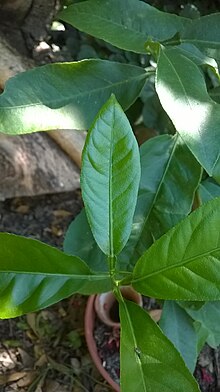 Leaves of some species of Citrus have winged petioles.
Leaves of some species of Citrus have winged petioles. 
X
xeromorph A plant with structural features (e.g. hard or succulent leaves) or functional adaptations that prevent water loss by evaporation; usually associated with arid habitats, but not necessarily drought-tolerant. Compare xerophyte. xerophyte A plant generally living in a dry habitat, typically showing xeromorphic or succulent adaptation; a plant able to tolerate long periods of drought. Compare xeromorph. xylem A specialised water-conducting tissue in vascular plants.
Z
 Zonate markings on the leaves of a garden variety of Pelargonium zonale
Zonate markings on the leaves of a garden variety of Pelargonium zonale  Like most of the genus Pelargonium, and unlike most members of the genus Geranium, Pelargonium quercifolium bears flowers that are bilaterally symmetrical. Accordingly, because the yoke of an ox is bilaterally symmetrical, such flowers are said to be zygomorphic, which literally means “yoke-shaped”. zonate Having light and dark circular bands or rings, typically on leaves or flowers. zygomorphic Bilaterally symmetrical; symmetrical about one vertical plane only; applies to flowers in which the perianth segments within each whorl vary in size and shape. Contrast Actinomorphic and irregular. zygote A fertilized cell, the product of fusion of two gametes.
Like most of the genus Pelargonium, and unlike most members of the genus Geranium, Pelargonium quercifolium bears flowers that are bilaterally symmetrical. Accordingly, because the yoke of an ox is bilaterally symmetrical, such flowers are said to be zygomorphic, which literally means “yoke-shaped”. zonate Having light and dark circular bands or rings, typically on leaves or flowers. zygomorphic Bilaterally symmetrical; symmetrical about one vertical plane only; applies to flowers in which the perianth segments within each whorl vary in size and shape. Contrast Actinomorphic and irregular. zygote A fertilized cell, the product of fusion of two gametes.
See also
- Glossary of biology
- Glossary of plant morphology
- Glossary of leaf morphology
- Glossary of scientific naming
- International scientific vocabulary
- Plant morphology
- Floral formula – abbreviations used in describing flower parts
- Plant anatomy
- Palynology
-
![Leaf 1 web.jpg]() Plants portal
Plants portal
References
- ^ a b c Harris & Harris 2001, p. 3.
- ^ Shreve, Forrest; Wiggins, Ira. Vegetation and Flora of the Sonoran Desert. Stanford University Press, 1964. ISBN 978-0804701631
- ^ a b Harris & Harris 2001, p. 4.
- ^ Harris & Harris 2001, pp. 4–5.
- ^ a b c d e f g h i Harris & Harris 2001, p. 5.
- ^ John Sims (1803). Curtis’s Botanical Magazine, Or, Flower-garden Displayed: In which the Most Ornamental Foreign Plants, Cultivated in the Open Ground, the Green-house, and the Stove, are Accurately Represented in Their Natural Colours … pp. 93–.
- ^ Harris & Harris 2001, p. 6.
- ^ Handbook of Plant Palaeoecology, Flora and Vegetation, p.95 By R. T. J. Cappers, R. Neef
- ^ a b c d Jackson, Benjamin, Daydon; A Glossary of Botanic Terms with their Derivation and Accent; Published by Gerald Duckworth & Co. London, 4th ed 1928
- ^ a b Jaeger, Edmund Carroll (1959). A source-book of biological names and terms. Springfield, Ill: Thomas. ISBN 978-0-398-06179-1.
- ^ a b Hanzawa, F.; Beattie, A.; Holmes, A. (1985). “Dual Function of the Elaiosome of Corydalis aurea (Fumariaceae): Attraction of Dispersal Agents and Repulsion of Peromyscus maniculatus, a Seed Predator”. American Journal of Botany. 72 (11): 1707–1711. doi:10.1002/j.1537-2197.1985.tb08442.x. JSTOR 2443727.
- ^ Mosses Lichens & Ferns of Northwest North America, Dale H. Vitt, Janet E. marsh, Robin B. Bovey, Lone Pine Publishing Company, ISBN 0-295-96666-1
- ^ Potentials and Limitations of Ecosystem Analysis, Extinction and Naturalization of Plant Species p.261, edited by Ernst-Detlef Schulze, Helmut Zwölfer
- ^ Potentials and Limitations of Ecosystem Analysis, Extinction and Naturalization of Plant Species, p.261, edited by Ernst-Detlef Schulze, Helmut Zwölfer, 1987
- ^ Field Guide to California Lichens, Stephen Sharnoff, Yale University Press, 2014, ISBN 978-0-300-19500-2, page 279
- ^ Alan W. Meerow, Michael F. Fay, Charles L Guy, Qin-Bao Li, Faridah Q Zaman, Mark W. Chase. Systematics of Amaryllidaceae based on cladistic analysis of plastid sequence data. Am. J. Bot. September 1999 vol. 86 no. 9 1325-1345
- ^ Pell, Susan K.; Angell, Bobbi (2016). A Botanist’s Vocabulary: 1300 Terms Explained and Illustrated. Portland, OR: Timber Press. p. 169. ISBN 978-1-604-69563-2.
- ^ Selected aspects of tiny vetch [Vicia hirsuta (L.) Gray S.F. Seed ecology: generative reproduction and effects of seed maturity and seed storage on seed germination Magdalena Kucewicz, Katarzyna Maćkiewicz, Anna Źróbek-Sokolnik, Uniwersity of Warmia and Mazury, Department of Botany and Nature Protection. 5 September 2009.
- ^ The Splash-Cup Dispersal Mechanism in Plants, Harold J. Brodie, Canadian Journal of Botany, 1951, 29(3): 224-234, 10.1139/b51-022, [1]
- ^ Beach, Chandler B., ed. (1914). “Tetrad” . The New Student’s Reference Work . Chicago: F. E. Compton and Co.
- ^ Beach, Chandler B., ed. (1914). “Tetraspore” . The New Student’s Reference Work . Chicago: F. E. Compton and Co.
- ^ Brown, Lesley (1993). The New shorter Oxford English dictionary on historical principles. Oxford [Eng.]: Clarendon. ISBN 978-0-19-861271-1.
- ^ Carr, G.W., in Foreman & Walsh, 1993.
Bibliography
- Allaby, Michael (2012). A Dictionary of Plant Sciences. Oxford: Oxford University Press. ISBN 978-0-19-960057-1.
- Henk Beentje (2010) The Kew Plant Glossary, an illustrated dictionary of plant terms. Revised edition (2012). Kew Publishing: Richmond, U.K. ISBN 978-1-84246-422-9.
- Ernest M. Gifford and Adriance S. Foster. 1989. Morphology and Evolution of Vascular Plants, 3rd edition. W. H. Freeman. ISBN 978-0-7167-1946-5
- Harris, James G.; Harris, Melinda Woolf (2001). Plant Identification Terminology: An Illustrated Glossary (2nd ed.). Spring Lake, UT, USA: Spring Lake Publishing. ISBN 0-9640221-6-8.
- Hickey, Michael; King, Clive (2000). The Cambridge illustrated glossary of botanical terms. Cambridge: Cambridge University Press. ISBN 978-0-521-79401-5.
- Hughes, Colin. “The virtual field herbarium”. Oxford University Herbaria. Retrieved 4 March 2017.
- “Plant Characteristics” (Glossary). Retrieved 4 March 2017., in Hughes (2017)
- Benjamin D. Jackson. A Glossary of Botanic Terms. Duckworth: London. J.B. Lippincott Company: Philadelphia (1928).
- David B. Lellinger. 2002. A Modern Multilingual Glossary for Taxonomic Pteridology (Pteridologia, 3). American Fern Society. ISBN 978-0-933500-02-0.
- Simpson, Michael G. (2011). Plant Systematics. Academic Press. ISBN 978-0-08-051404-8.
- Stearn, W.T. 1983. Botanical Latin. David & Charles, North Pomfret, Vermont.
- Glossary of botanical and medical terms, in Don G. W. A general system of gardening and botany. Founded upon Miller’s Gardener’s dictionary, and arranged according to the natural system. 1831
- “Glossary of botanical terms”. Neotropikey. Royal Botanic Gardens, Kew. Retrieved 18 February 2017.
- “Glossary for Vascular Plants”. The William & Lynda Steere Herbarium, New York Botanical Garden. Retrieved 20 September 2019.
External links
- Wiktionary
- Glossary at: APweb
- A glossary of botanical terms in English At: Flora, etc.
- Garden Web
- eFloras
- Categorical Glossary for the Flora of North America Project
Royal Botanical Gardens at Kew
- Standard glossary (archive)
- Stuppy, W. Glossary of Seed and Fruit Morphological Terms
Australia and New Zealand
- University of Sydney: Eflora – Glossary
- Florabase (Western Australia)
- Flora of Australia Online Glossary
- Flora of Australia Abbreviations
- Flora of S Australia
- Botany Word of the Day. Illustrated with New Zealand natives
- New Zealand Plant Conservation Network
Africa
- Herman, P P J (2015). “Botanical glossary” (PDF). SANBI. Retrieved 21 May 2020.
- Plants of southern Africa
